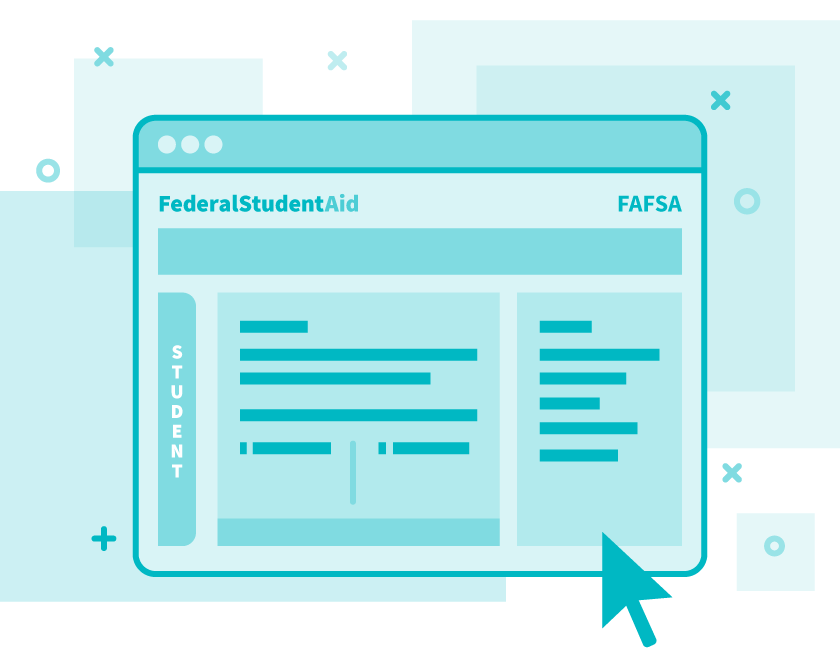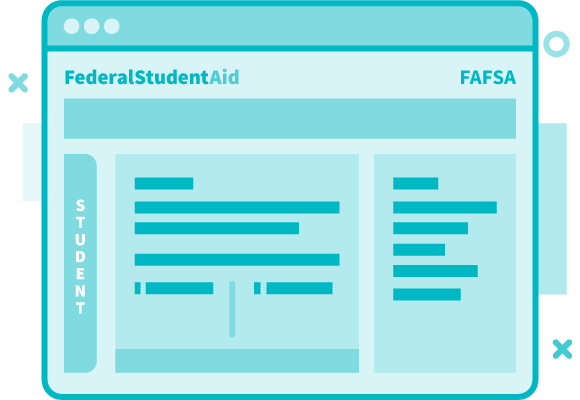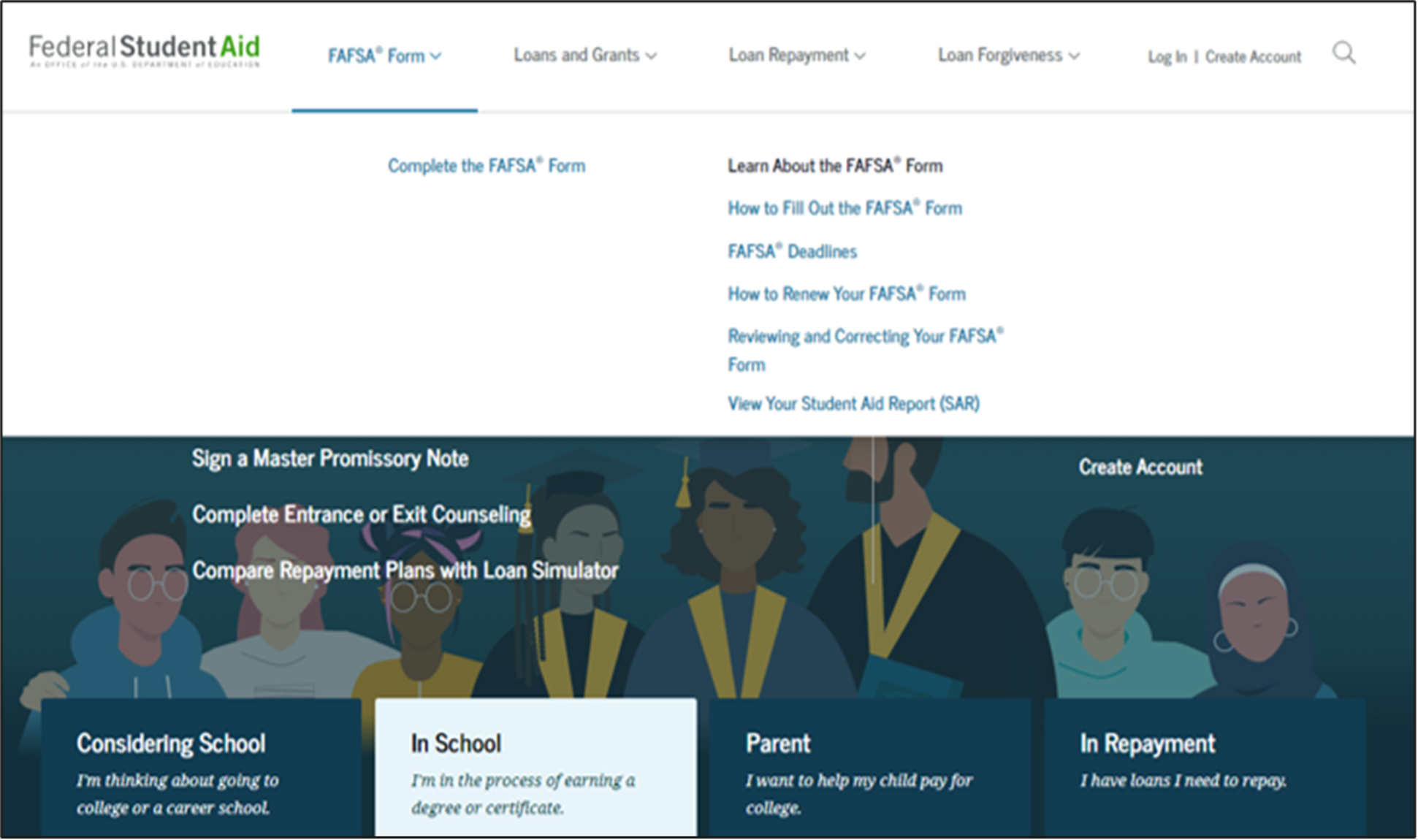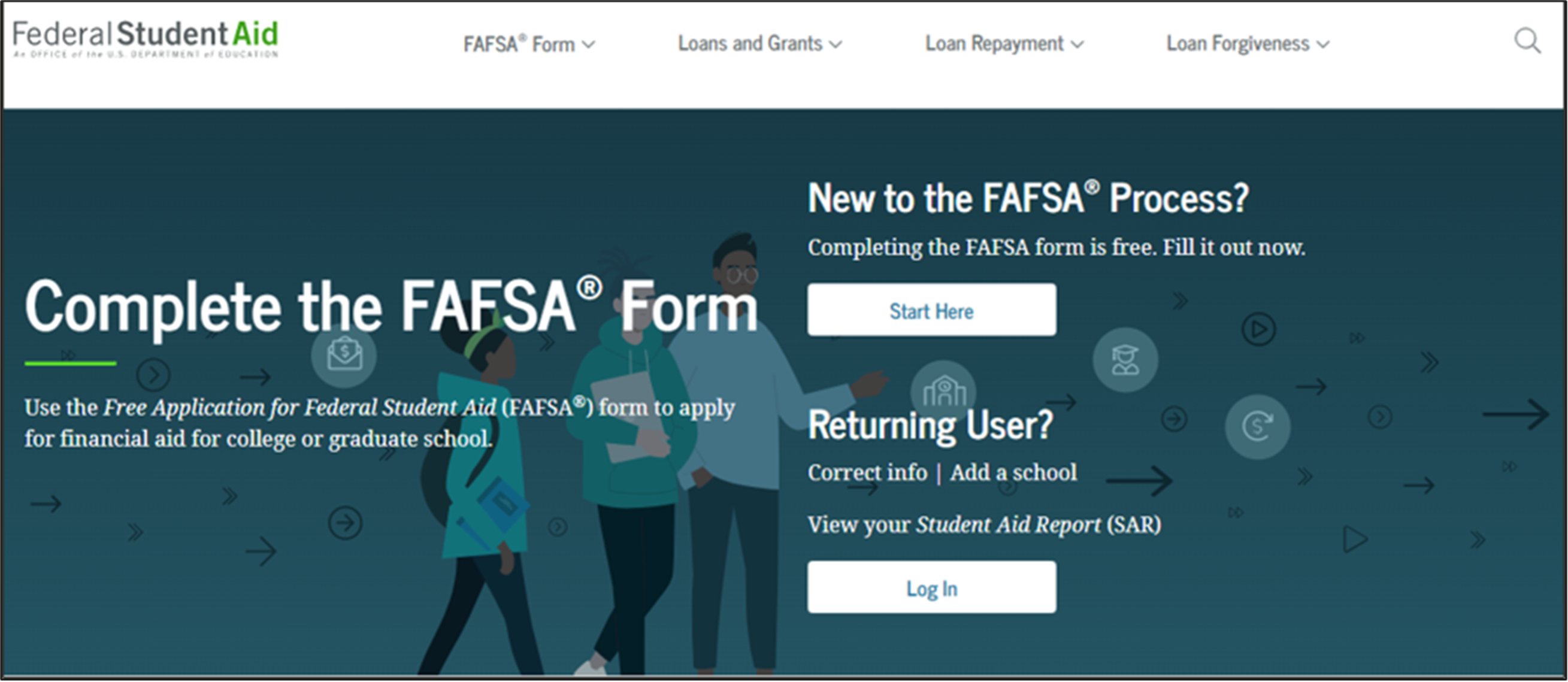How to Complete the 2023-2024 FAFSA Application
To help you fill out the Free Application for Federal Student Aid (FAFSA), prepare all of the required documents listed below. Then follow 1 of our detailed guides: Online version (continue scrolling below) or use our question-by-question guide.
Information you’ll need to fill out the FAFSA:
- Your FSA ID, which you can create on studentaid.gov. Note that students and parents will need to create their own FSA ID and keep it private.
- Your social security number and driver’s license, and/or alien registration number if you are not a U.S. citizen.
- Your federal income tax returns, W-2s, and other records of money earned.
- Your parents income tax returns, W-2 forms and 1040 forms if you’re a dependent.
- Bank statements and records of investments (if applicable).
- Records of untaxed income (if applicable).
- Title IV Institution Codes for each school you’re applying to, which you can find from the FAFSA federal school code search.
step one

Learn how to answer each question
Step One: Role Selection
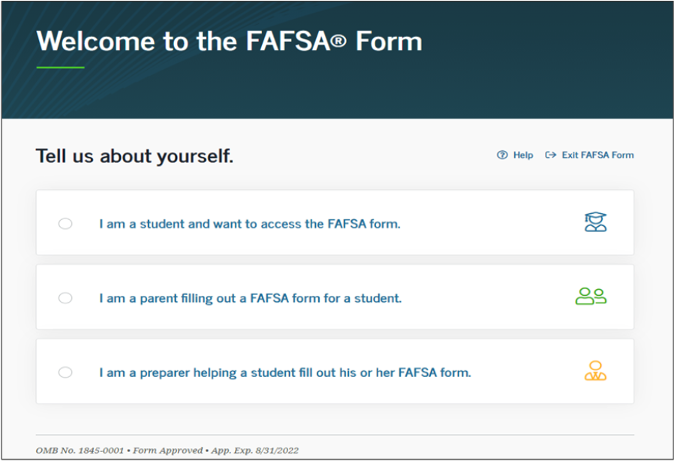
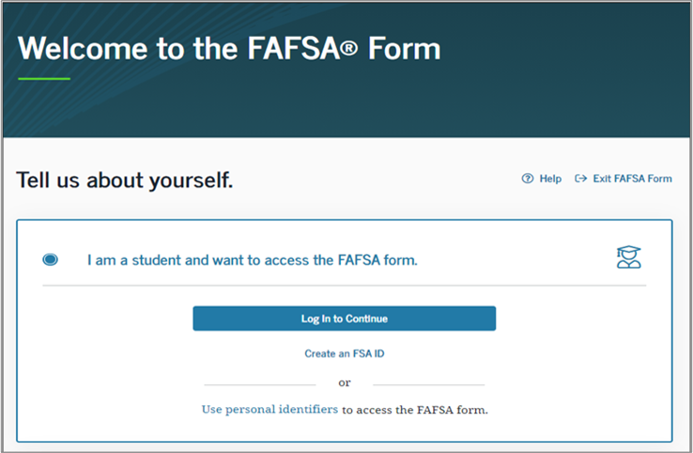
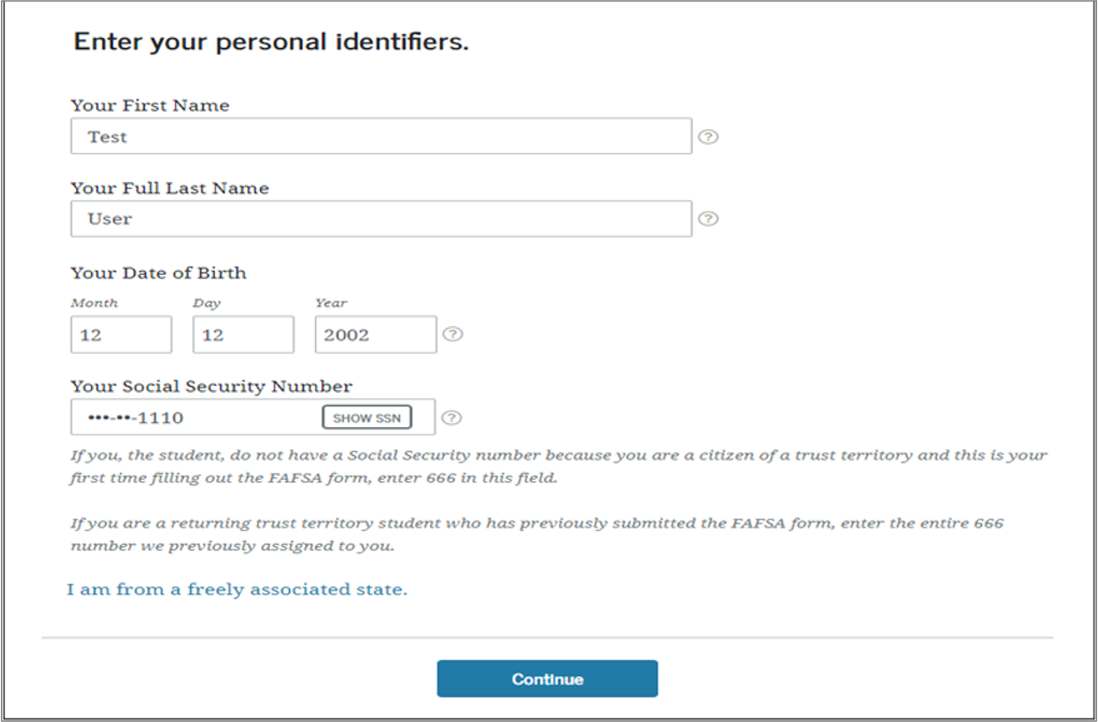
- The user selected to use personal identifiers (first name, last name, date of birth, and Social Security number) to access the FAFSA® form. Once the user enters their personal identifiers, they will select "Continue."
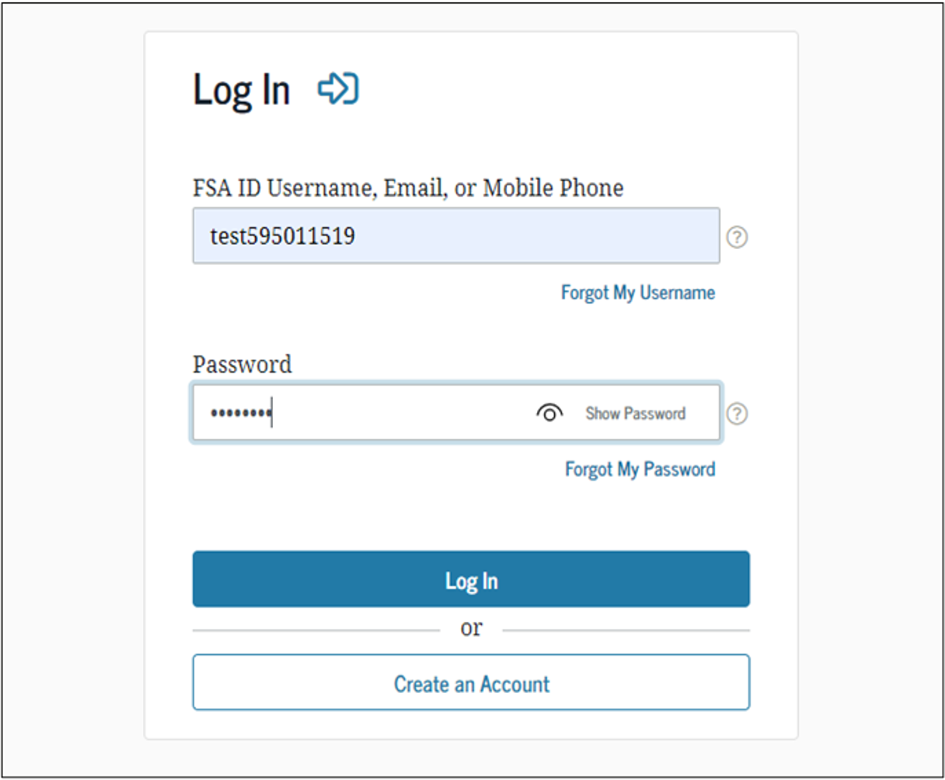
- If the user selects the "Log In to Continue" button, on the Roles page ,the user is prompted to enter their FSA ID (account username and password). If the user doesn't have an FSA ID, the user can select "Create an Account" to create an FSA ID.
Part 2: Login & Get Started
- 2023-24 “Login” view with the “I am the student” option selected.
- Note: If using this option, the applicant can choose one of three ways to log in to the application: using an FSA ID, a verified email address, or a verified phone number and password. If you haven’t created a FSA ID yet, you can create one here.
- Only student’s may use their FSA ID to log in. Parents and others can start a FAFSA for a student by entering the student identifiers or select the applicable role, "I am a parent or preparer" to log in with the student's name, Social Security Number and date of birth.
- The SSN is masked by default and users have the ability to check the “Show SSN” box if they wish to see what is being typed in.
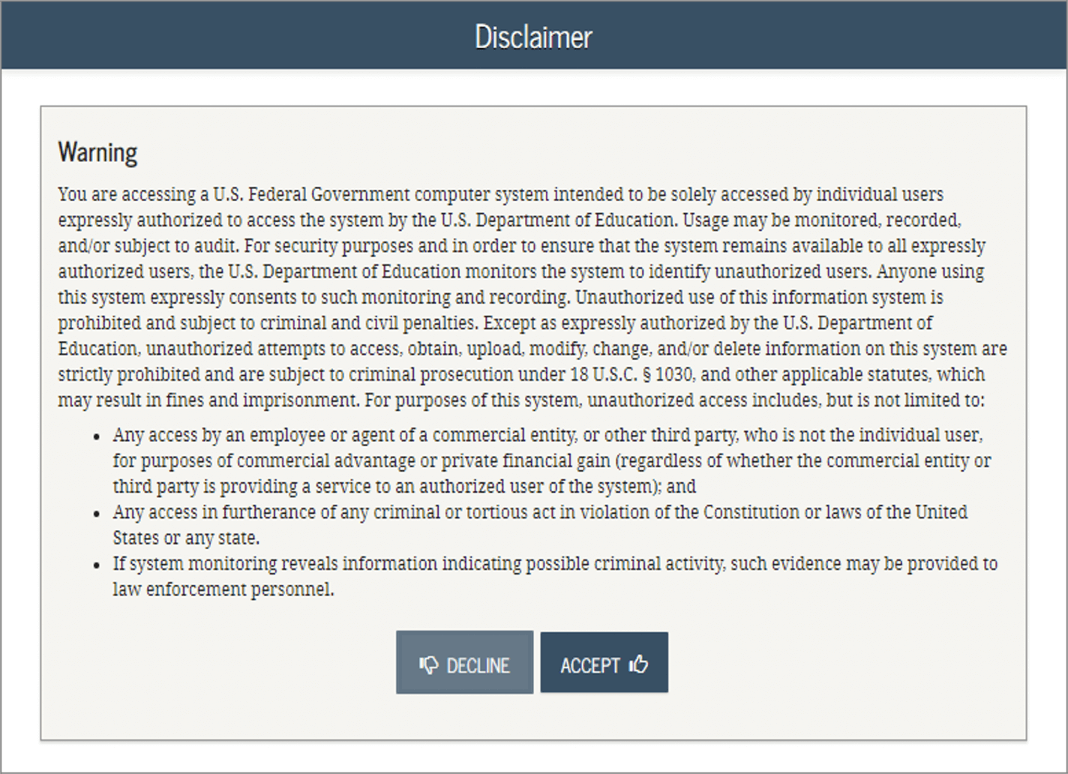
- 2023-24 “Disclaimer” view.
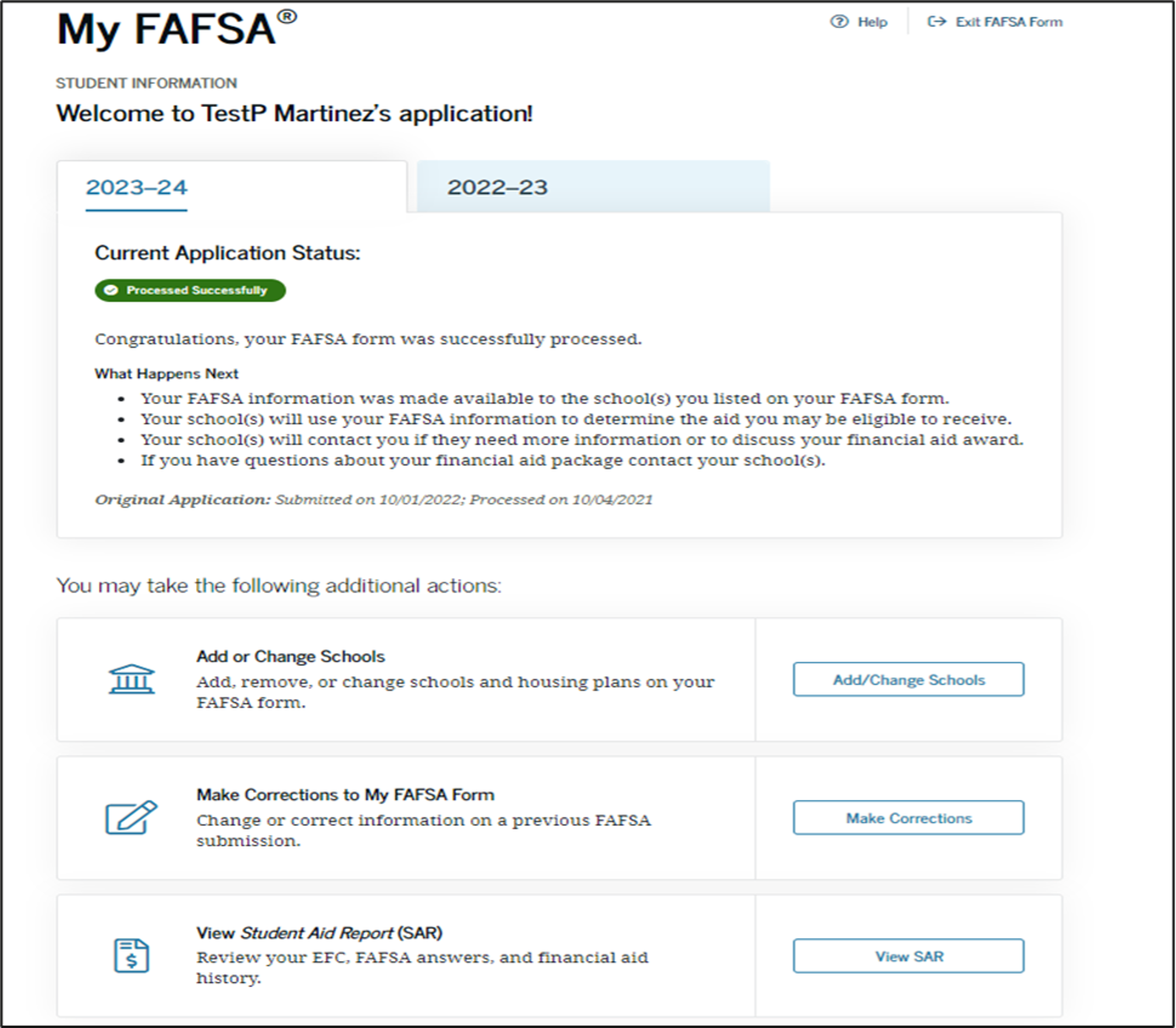
- If you submitted a 2022-2023 FAFSA, select ”FAFSA Renewal" for the information from that application to be used to renew your 2023-2024 FAFSA.
- If you didn't submit a 2022-2023 FAFSA, select "Start New FAFSA."
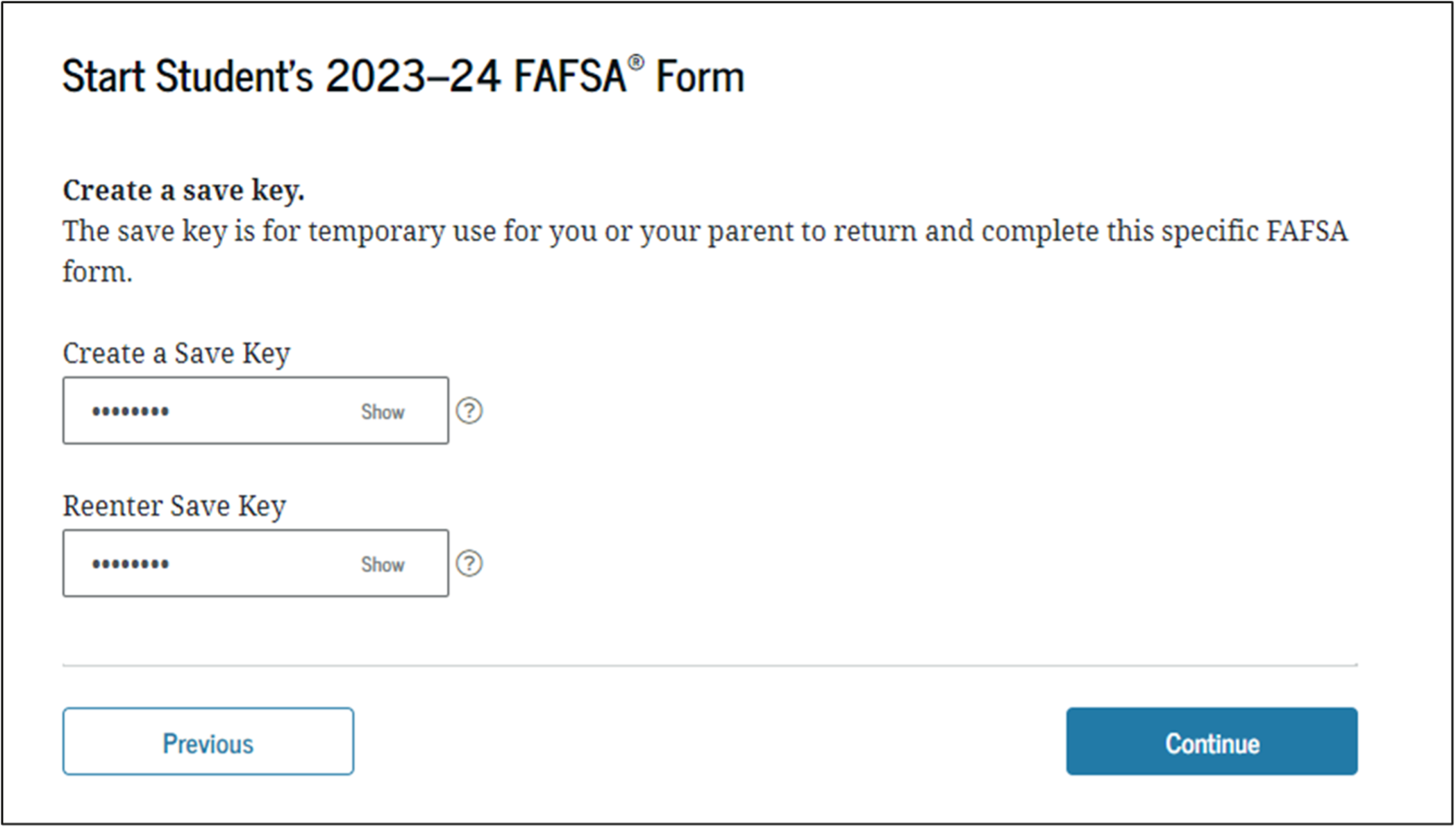
- The user must create a save key in order to start their FAFSA form. The save key is also used to return and complete their FAFSA form.
- The Save Key acts as a temporary password while you are working on your application. It can be between 4 and 8 characters long and can contain any combination of numbers and/or uppercase and lowercase letters.
- The Save Key allows an applicant to save their Free Application for Federal Student Aid (FAFSA®) form and return at a later time to complete and submit the application. The application is saved for 45 days, unless the applicant submits their application for processing prior to that. Additionally, the Save Key provides applicants a way to share access to their FAFSA form or correction if their parent(s) needs to add information or sign it.
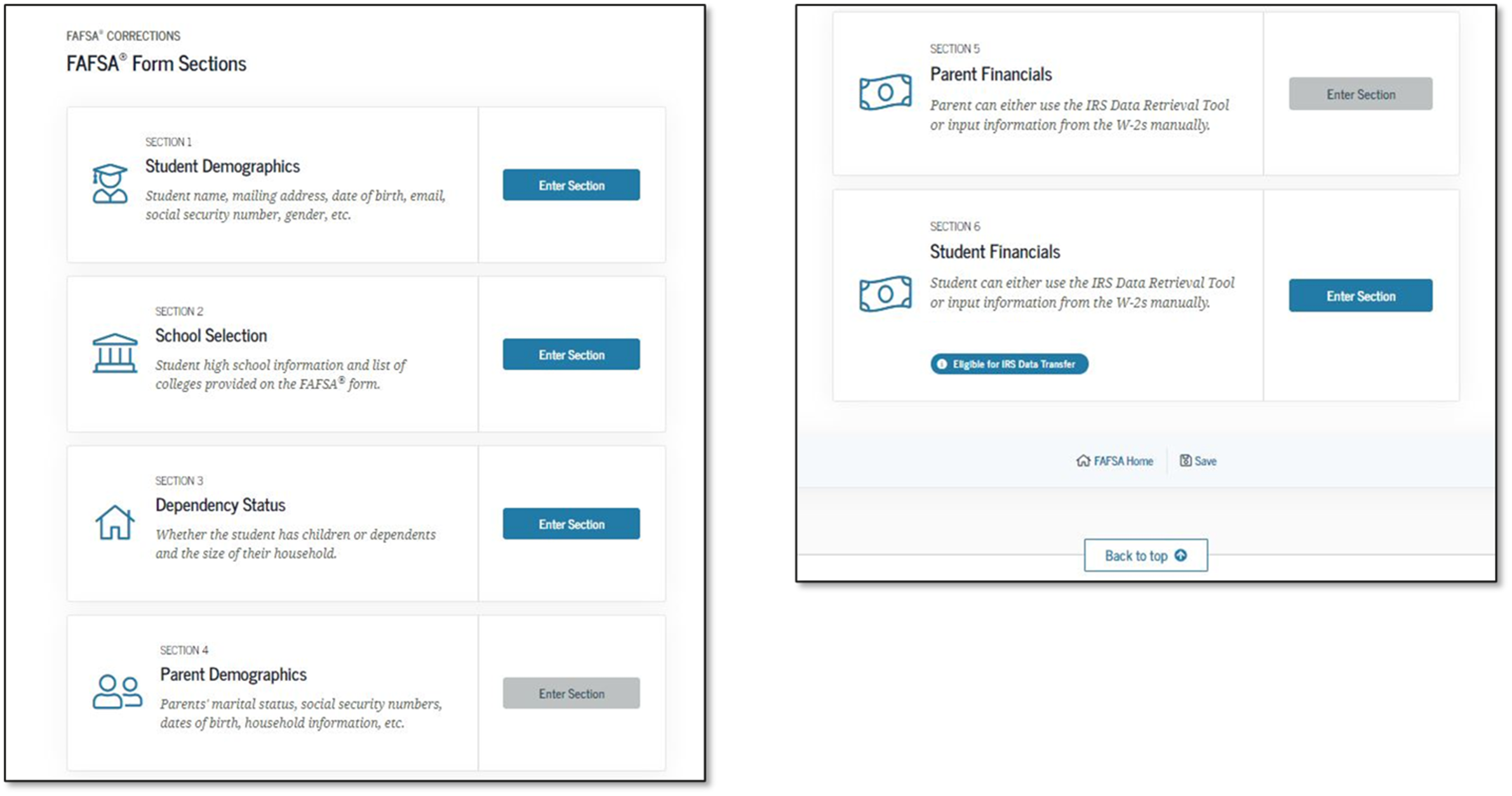
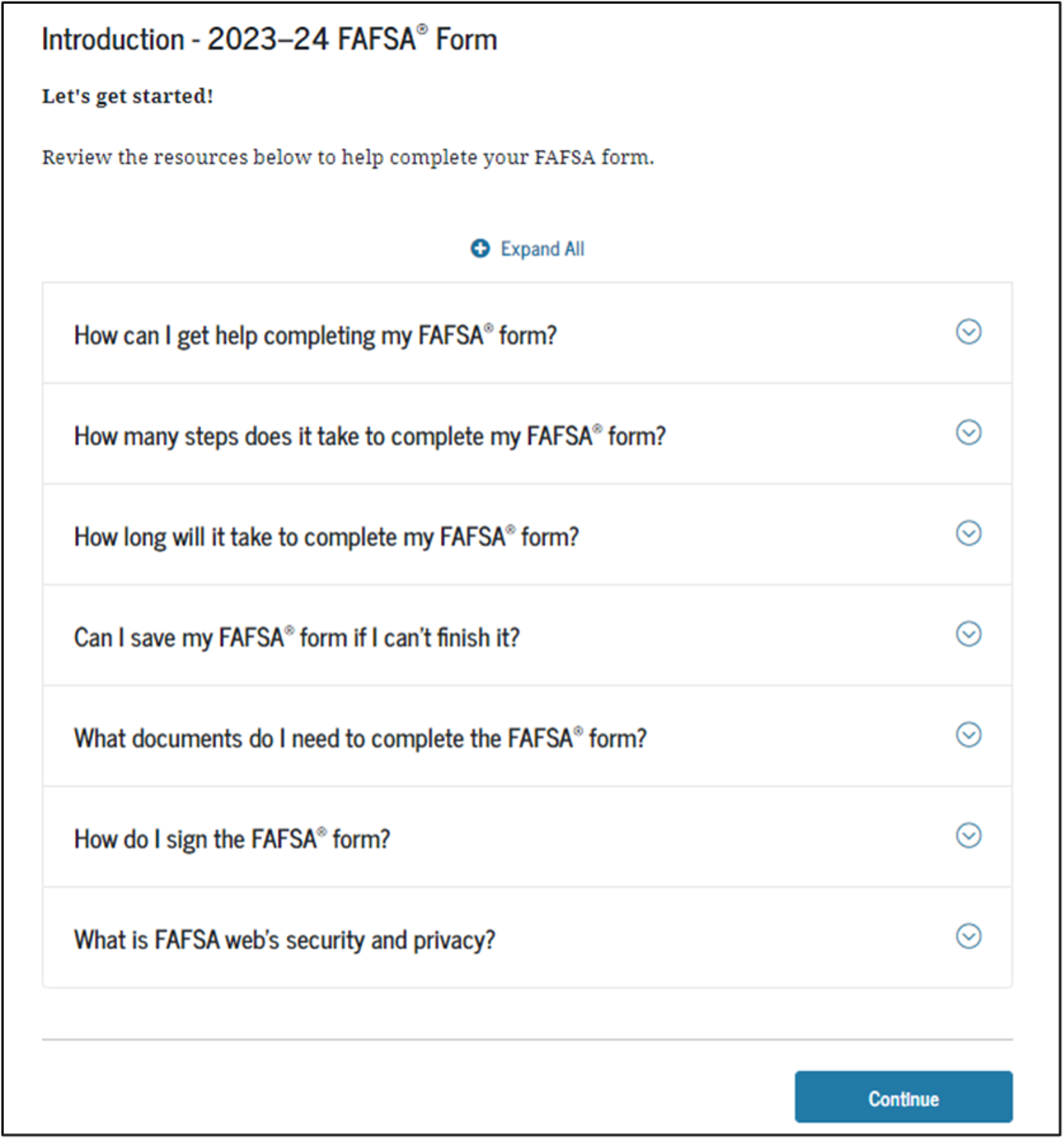
- 2023-24 “Introduction” view.
- Each topic has accordion functionality that can be expanded and contracted to reveal or conceal additional information.
- If the user needs help completing their FAFSA form, they can review the resources found on the Introduction page. The user can click on “Expand All” to view all the resources all at once or can click on the dropdown button to the right of each question to view that question’s respective resource.
Step Two: Student Demographics
- Note: the web app is a smart form and so additional or different questions may come up based on the user’s responses. We will note where we know this to be the case.
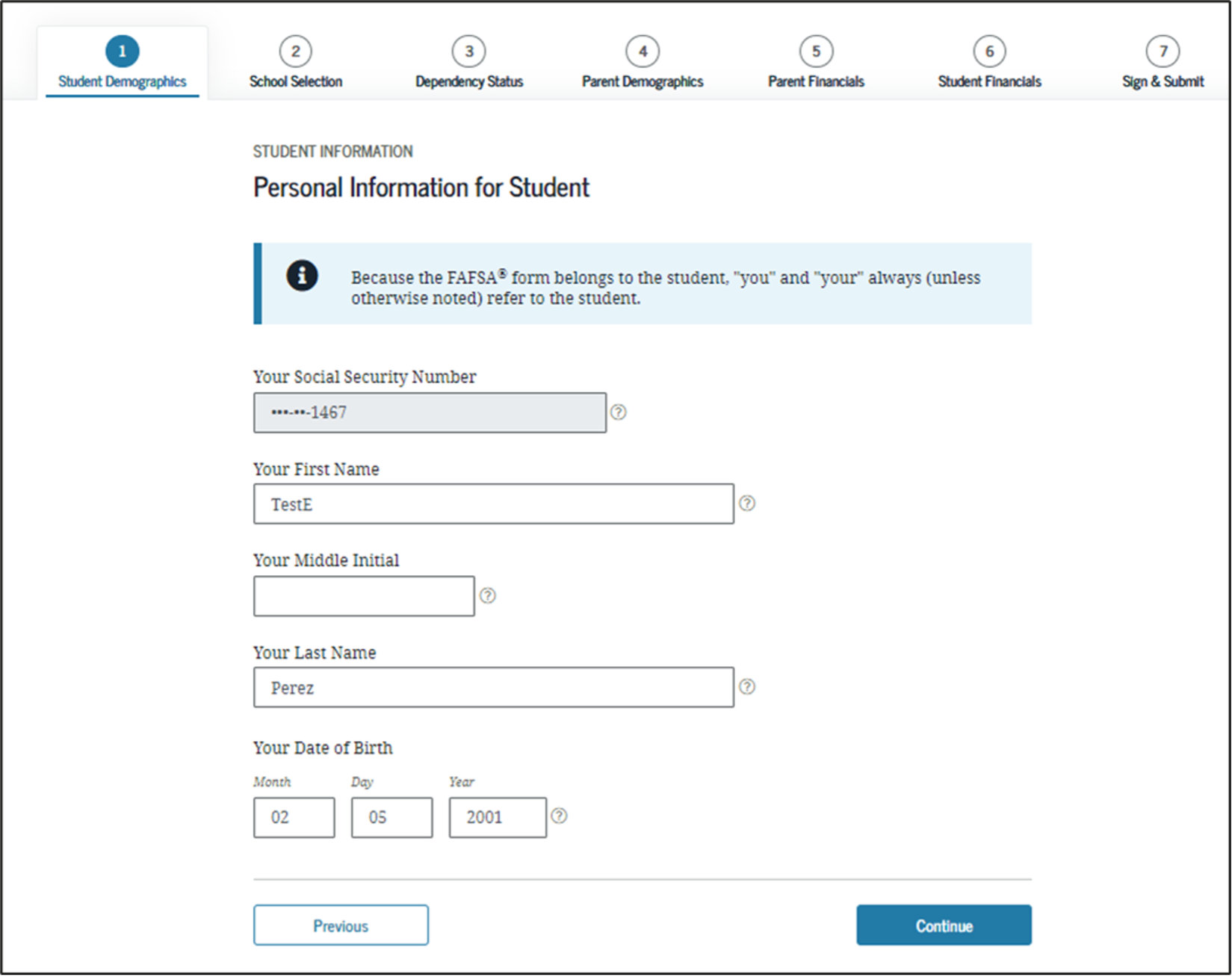
- Note: Much of this section will be pre-filled from the FSA login.
- Input your last name exactly how it appears on your Social Security card. If your name has a suffix, such as Jr. or III, include a space between your last name and suffix.
- Input your first name exactly how it appears on your Social Security card.
- Input your middle initial exactly how it appears on your Social Security card.
- Input your Social Security Number (SSN). Confirm that you enter your SSN accurately before moving on in the process.
- Input your date of birth (month / day / year).
- This is one of multiple pages on fafsa.gov that explains that “you” and “your” are referencing the applicant. Other pages where this messaging appears includes the Search for High School, Student Marital Status, Parent Marital Status, and Student Tax Filing Status.
- The box highlighted in green indicates that the application has been successfully saved.
- Note: This is the first view for the Student Demographics section.
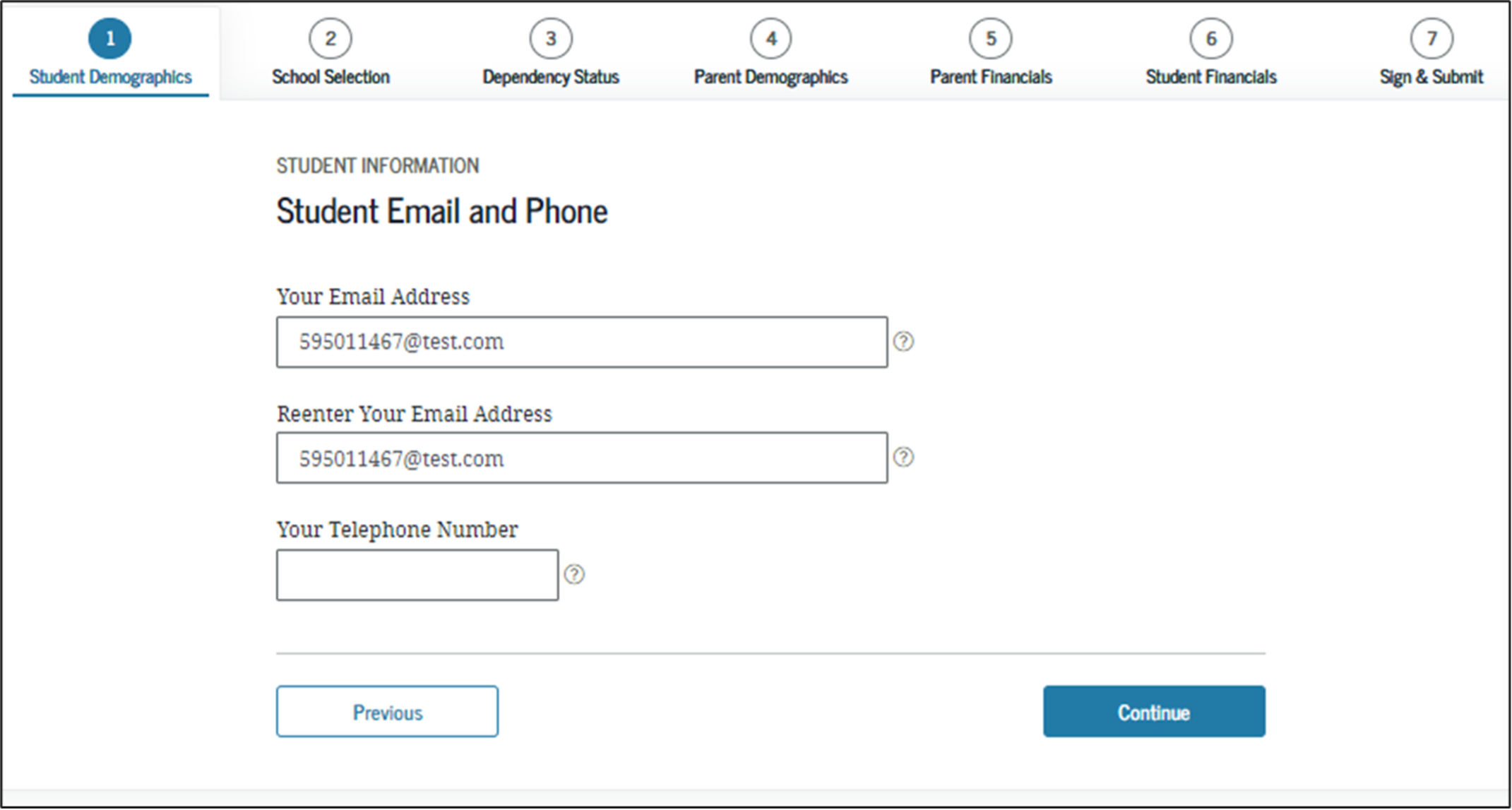
- 2023-24 “Student E-mail and Phone” view.
- Note: While not mandatory, it is beneficial for the applicant/parent to include an e-mail address on the FAFSA form in order to receive important communications about their financial aid.
- If you provide your email address, you will be contacted electronically. For example, when your FAFSA has been processed, you will be notified by email. Your email address will also be shared with your state and the colleges listed on your FAFSA to allow them to contact you. Leave this field blank if you don't have an email address.
- Need more help?
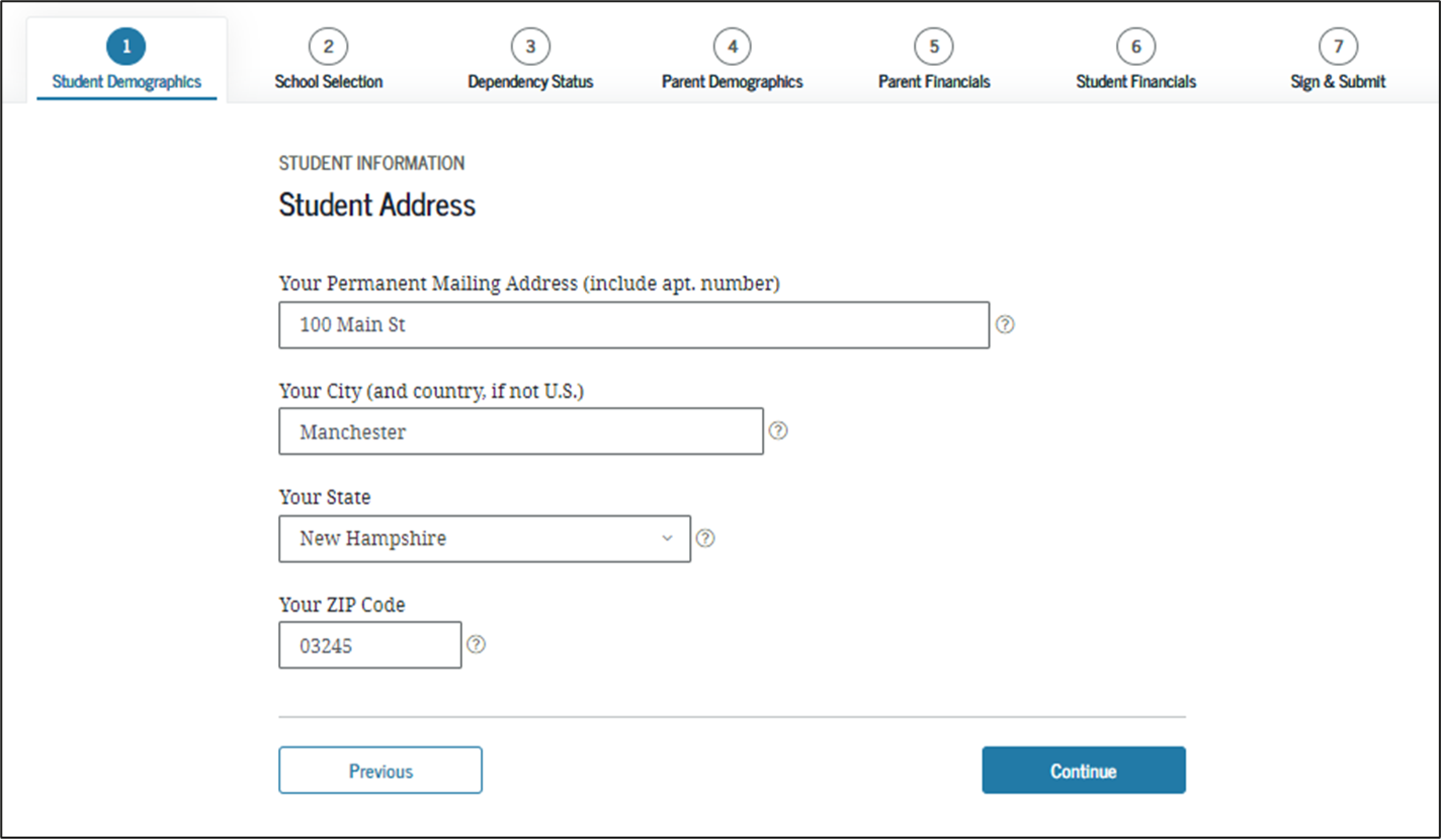
- 2023-24 “Student Address” view.
- Input the number and street, including the apt. number, of your permanent mailing address. Although you may use your college’s mailing address after you are an enrolled student, you'll need to use your home address when filing the FAFSA.
- Input your city of residence. Include the country if it's not located in the U.S.
- Input your state of residency. Leave blank if located outside of the U.S.
- Input your zip code
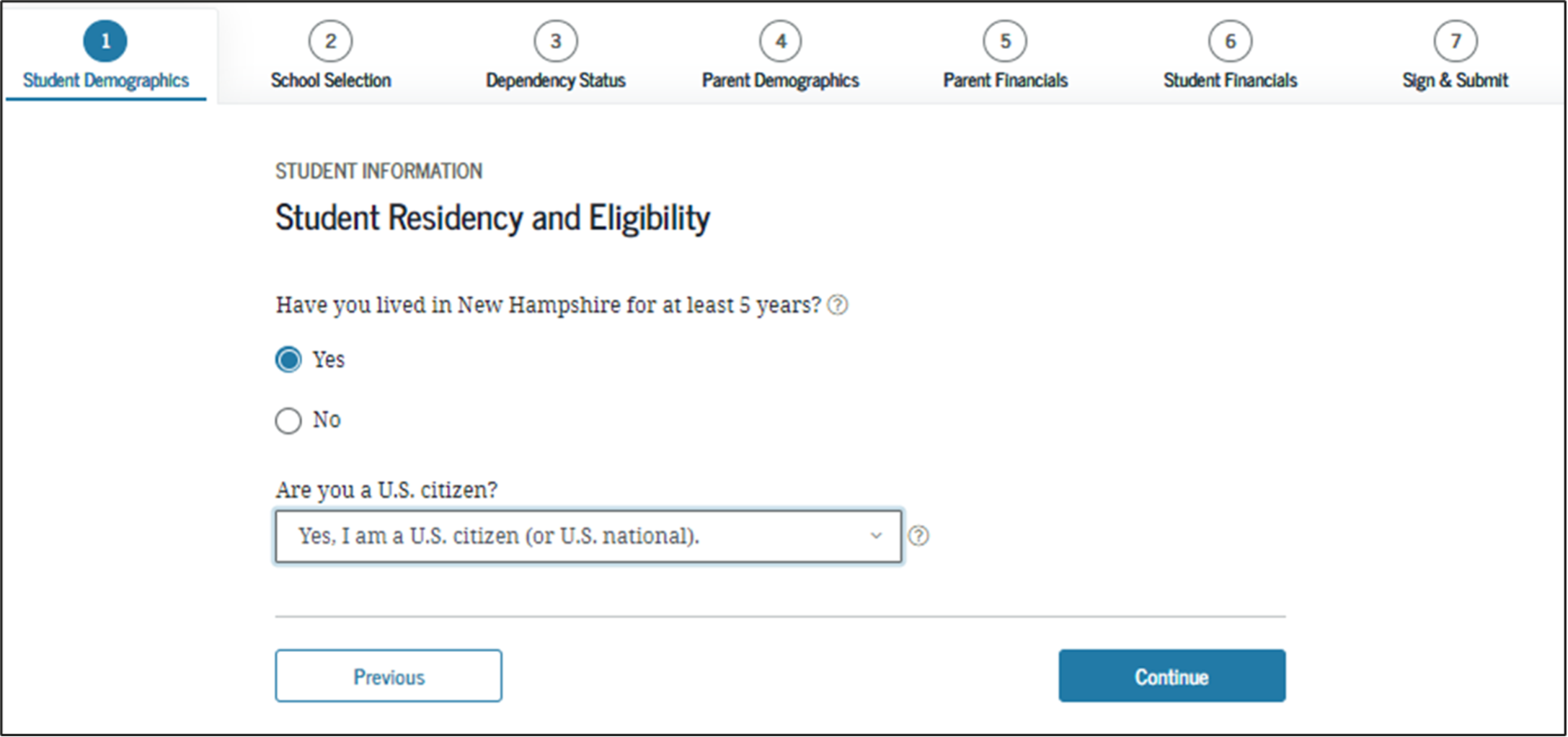
- 2023-24 “Student Residency and Eligibility” view.
- Select "yes" if this is your state of legal residence and you have living there for 5 years or more. This state will represent your state of legal residence, which is where you reside and have a true, fixed, and permanent home. If you moved into this state for the sole purpose of attending a school, do not count this state as your state of legal residence.
- Note: You might receive a note that you can transfer your FAFSA information to your state’s student aid application once you receive the confirmation page after submitting your FAFSA.
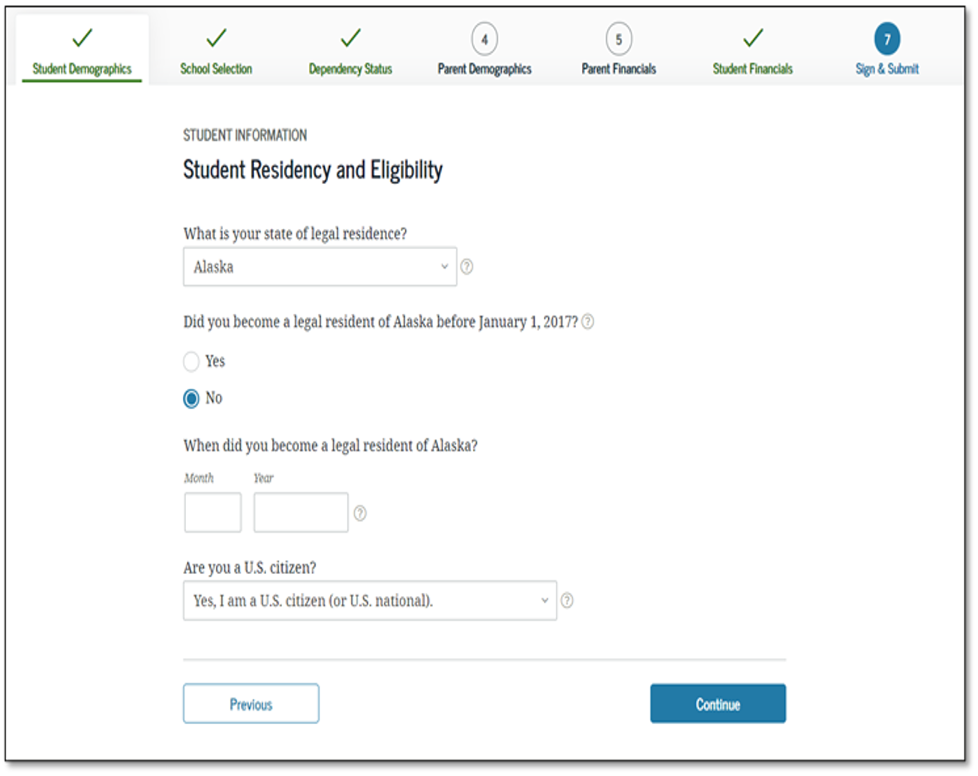
- Select if you're a U.S. citizen from the dropdown. The Department of Education requires that you meet certain citizenship criteria in order to receive Federal financial aid. You are automatically eligible if you are a U.S. citizen or U.S. national (natives of American Samoa or Swain’s Island). If you are neither a citizen nor an eligible noncitizen, you are not eligible for federal student aid, but you may still qualify for local state grants. For this reason, you will still want to continue and complete the FAFSA.
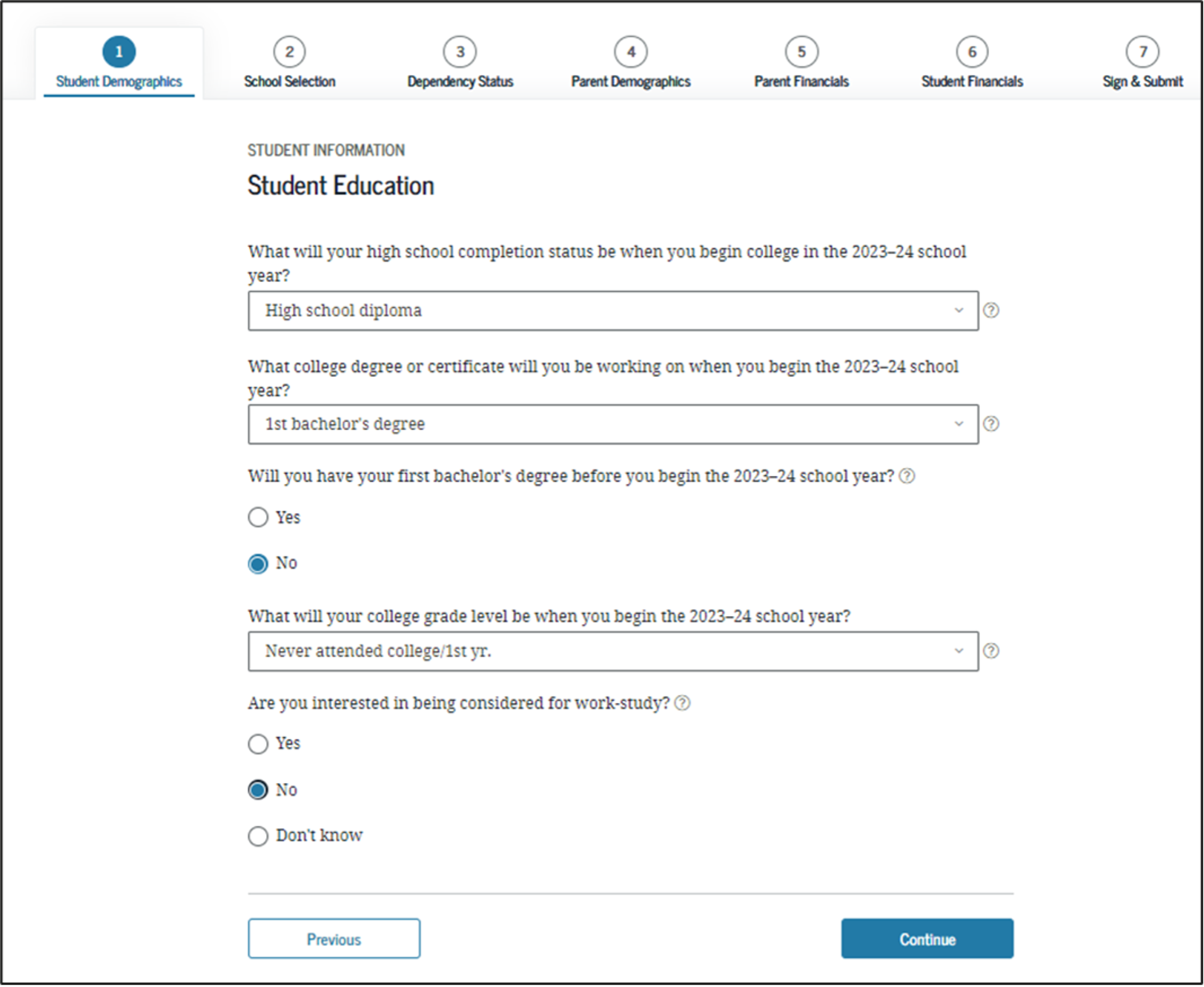
- High school completion status: This question aims to determine your level of high school completion prior to enrolling in an institute of higher learning. This will help to determine your eligibility for federal financial aid.
- College degree or certificate seeking: This question aims to determine your level of undergraduate, graduate, or professional schooling prior to enrolling in an institute of higher learning. This will help to determine your dependency status, which will also determine your eligibility for federal financial aid. The Department of Education wants to know what area of study you intend to undertake academically while receiving federal funding
- 1st Bachelor's Degree: Select "yes" or "no" based on your degree level in 2023-2024. Undergraduate programs offer different types of aid and different amounts of federal financial aid compared to graduate types and amounts
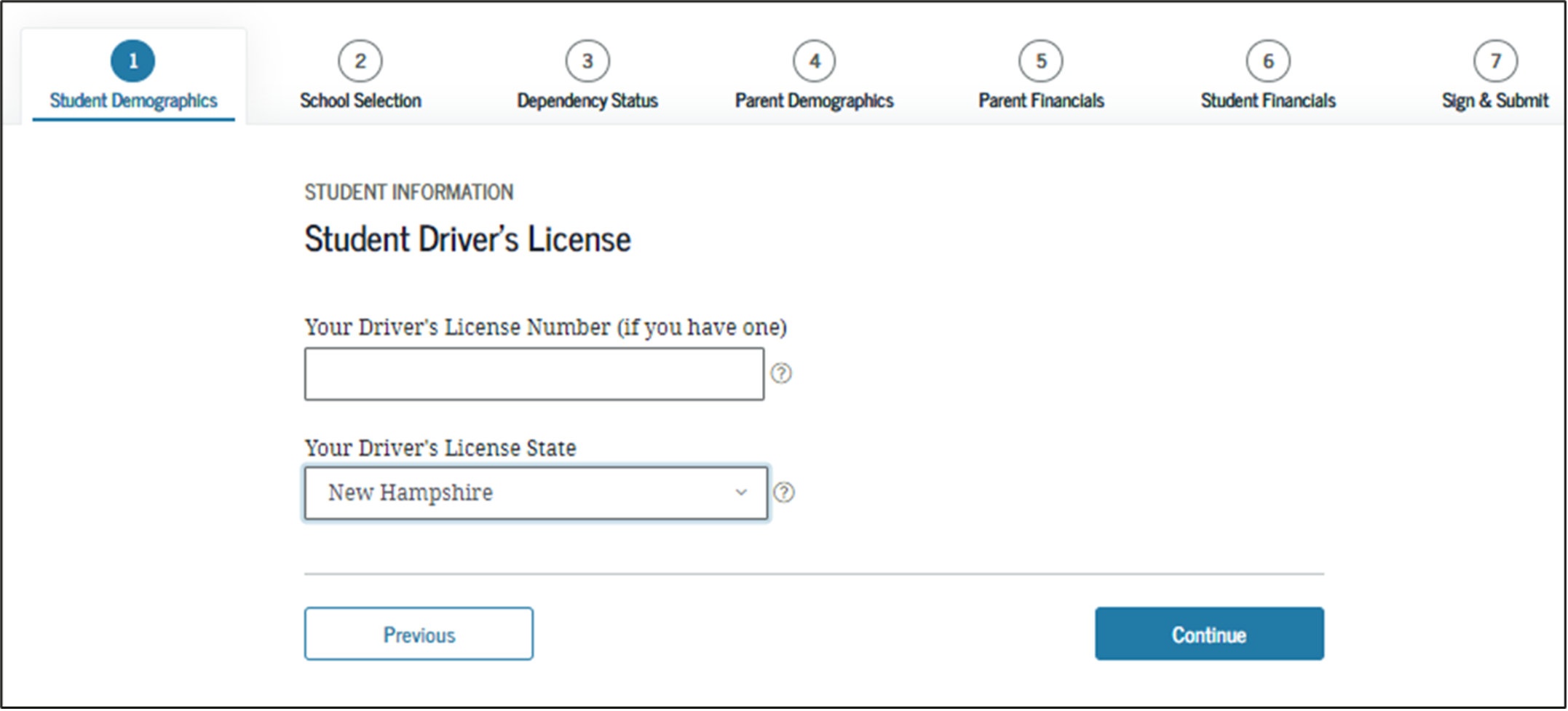
- FAFSA asks about a student driver’s license to help prevent identity theft. Colleges can use a student driver’s license to prevent someone else from picking up the student’s refund check. Note that the student’s driving record does not affect eligibility for financial aid. The driver’s license number is also not used to verify citizenship or drug convictions.
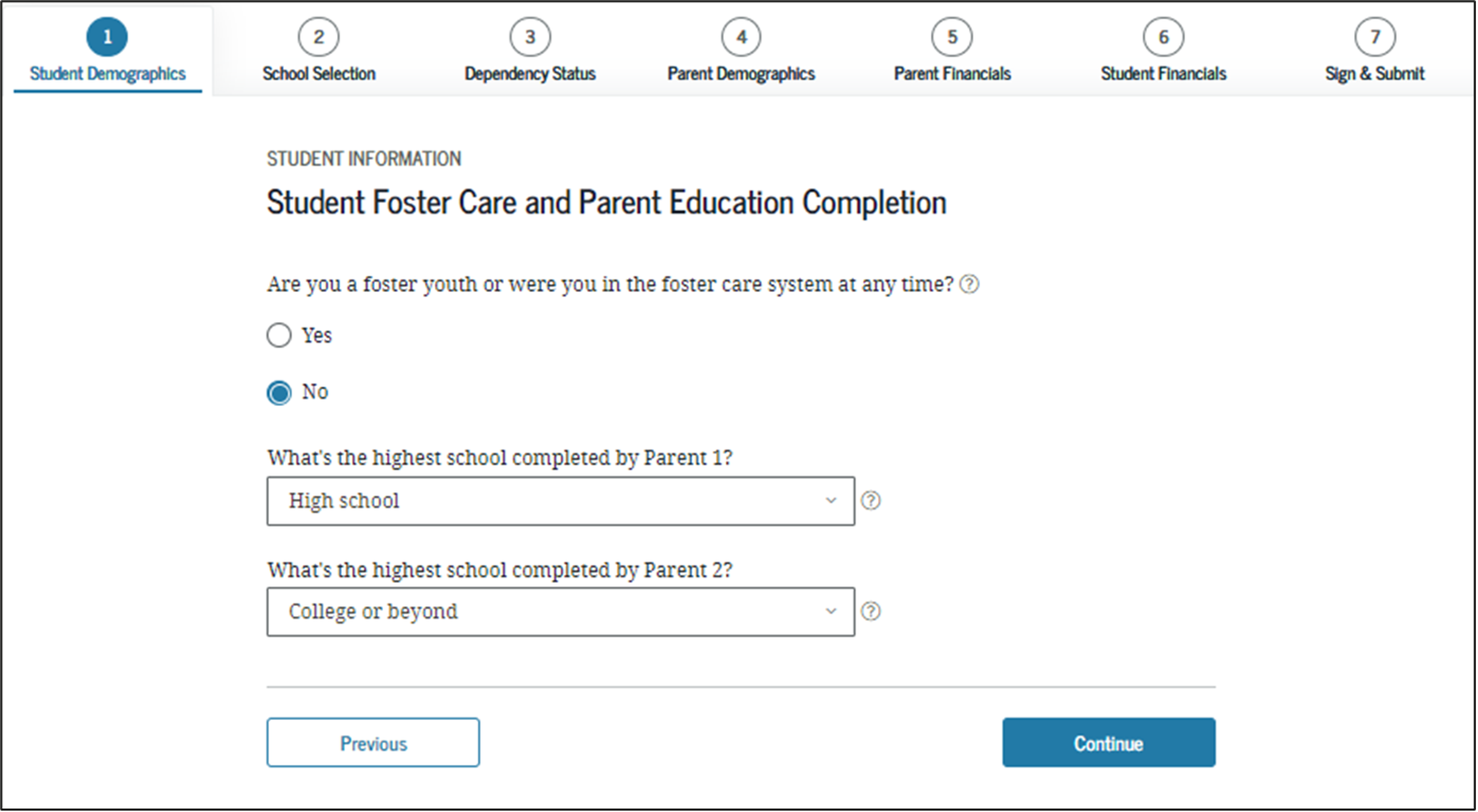
- 2023-24 “Student Foster Care and Parent Education Completion” view.
- The response indicates the student's parent’s highest completed grade level. For this question, parent means your birth or adoptive parent. Do not answer this question about a stepparent, legal guardian, or foster parent.
- This question is used for state scholarship purposes only and does not affect the student's eligibility for federal student aid. Student Eligibility Worksheet The answers to the student eligibility worksheet will not impact the a_____________
Step Three: School Selection
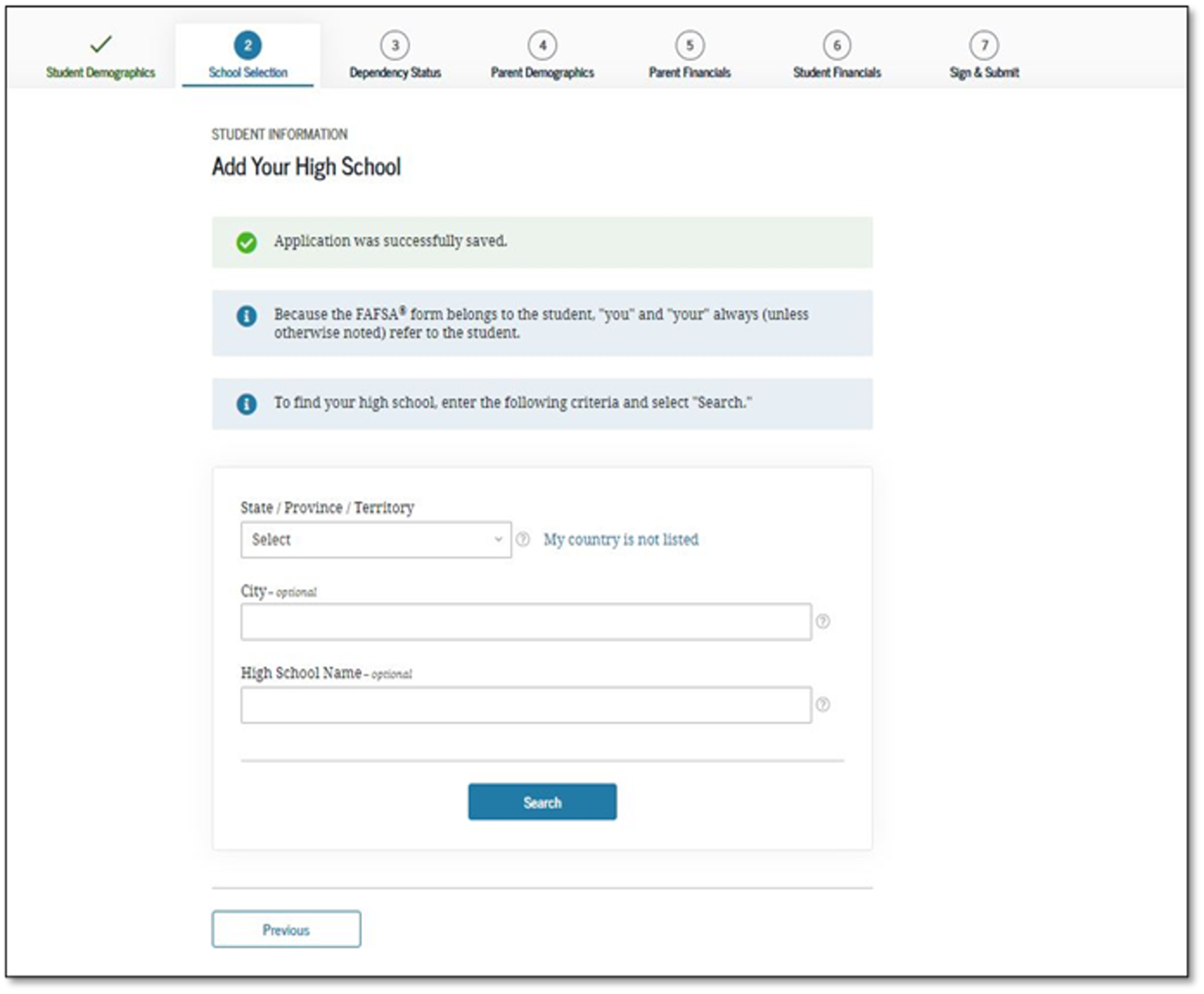
- Enter the complete name of your high school.
- Enter the city that your high school is located.
- Select the state that your high school is located in from the dropdown.
Note. If you receive an error message from this page, make sure you are clicking “search” rather than “next” in order to identify your high school.
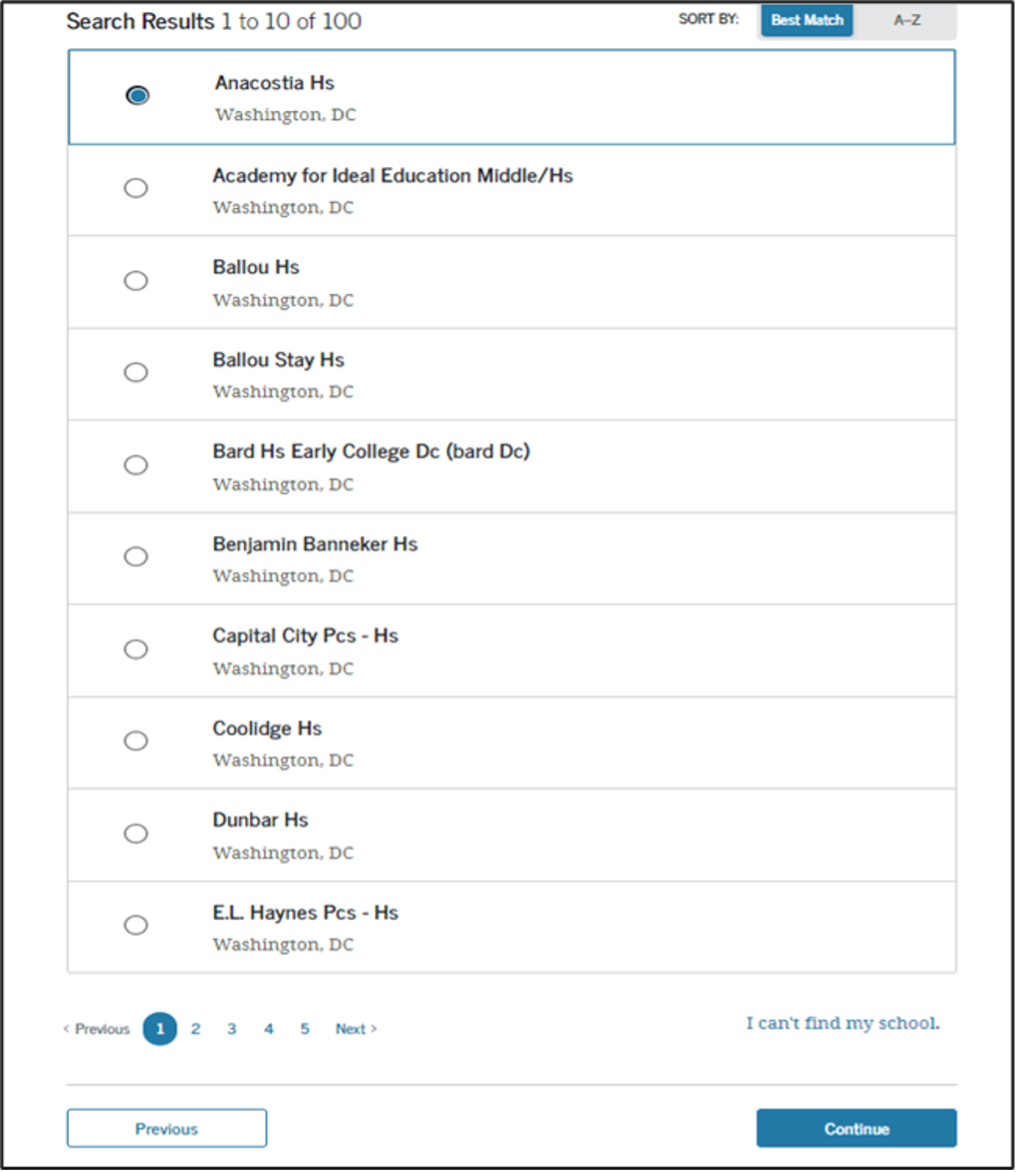
- Your search results should look like this. Choose your high school from the list by clicking “select” on the left.
Confirm Your High School
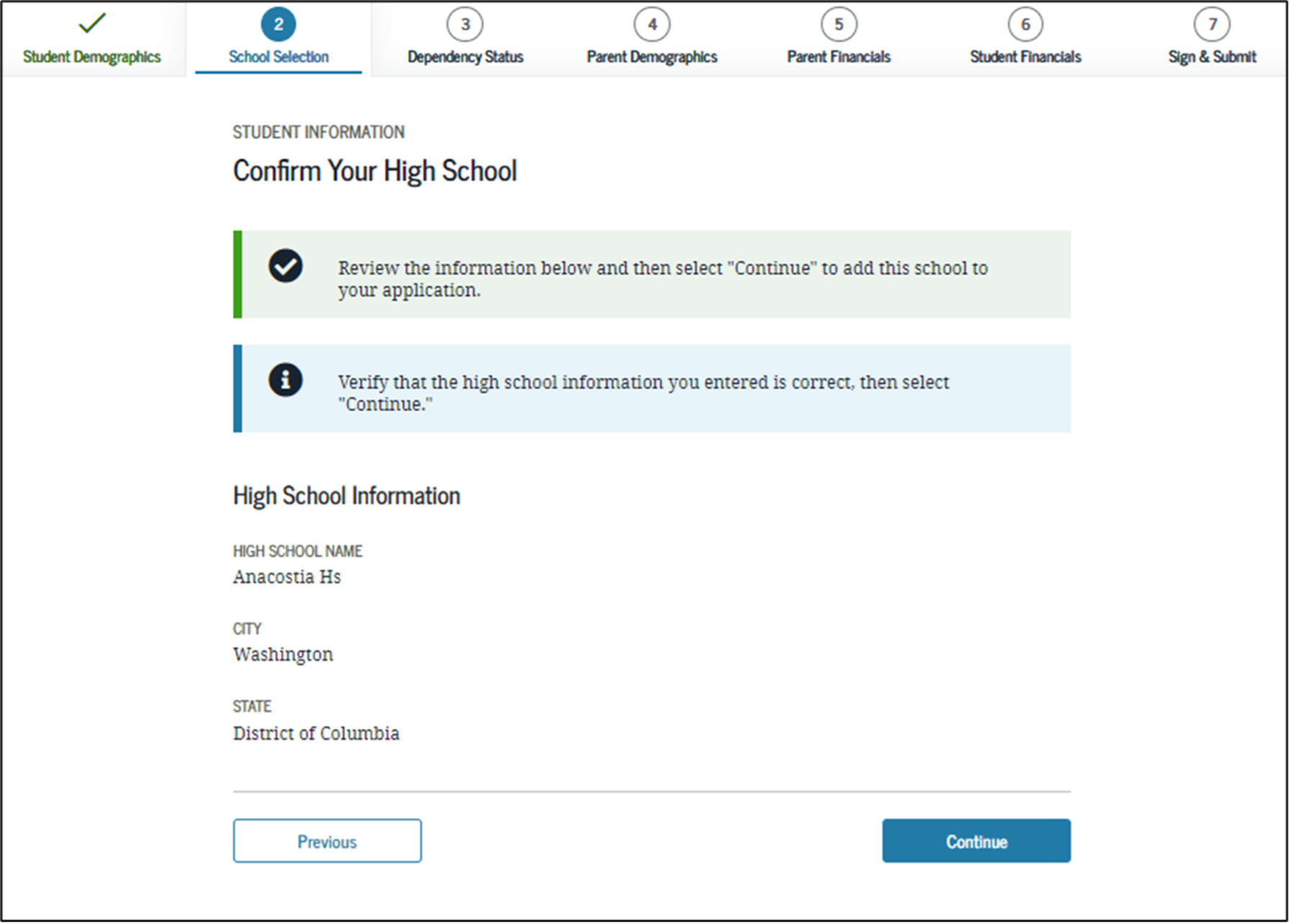
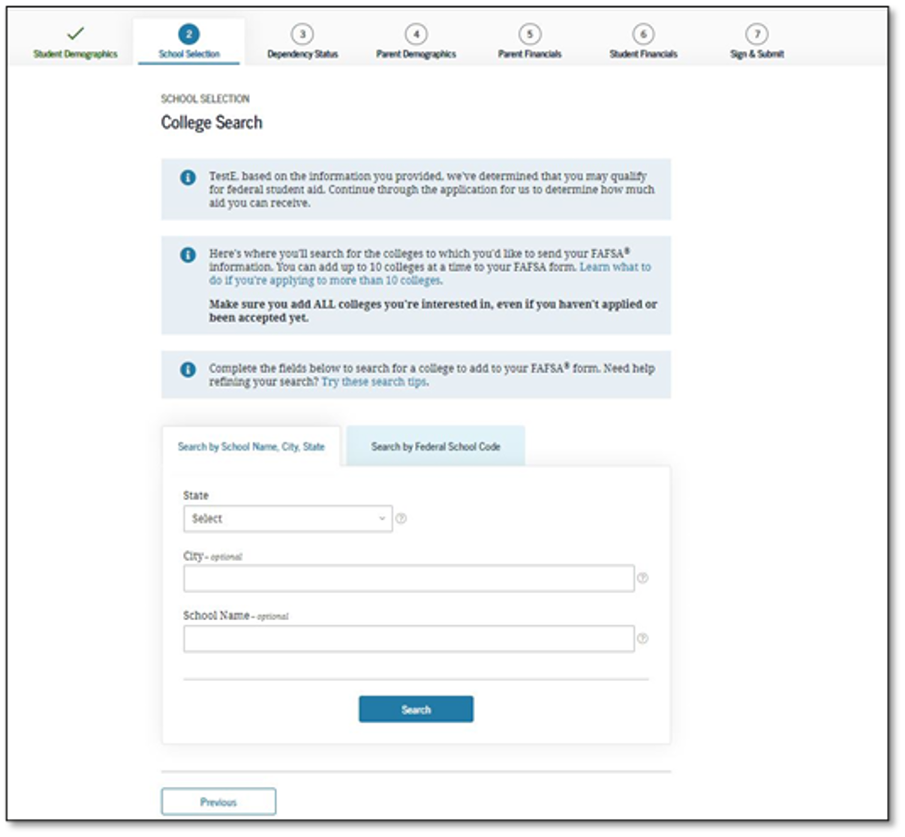
- 2023-24 “Search for Colleges” view
Search by Federal School Code
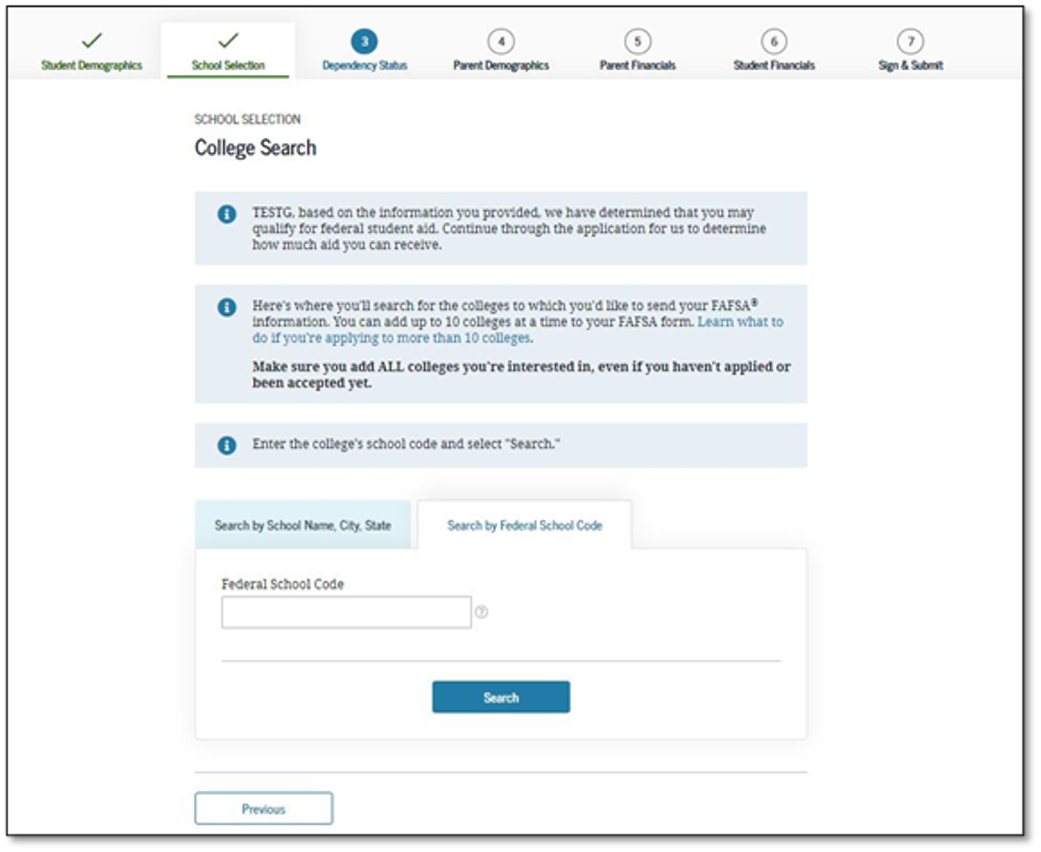
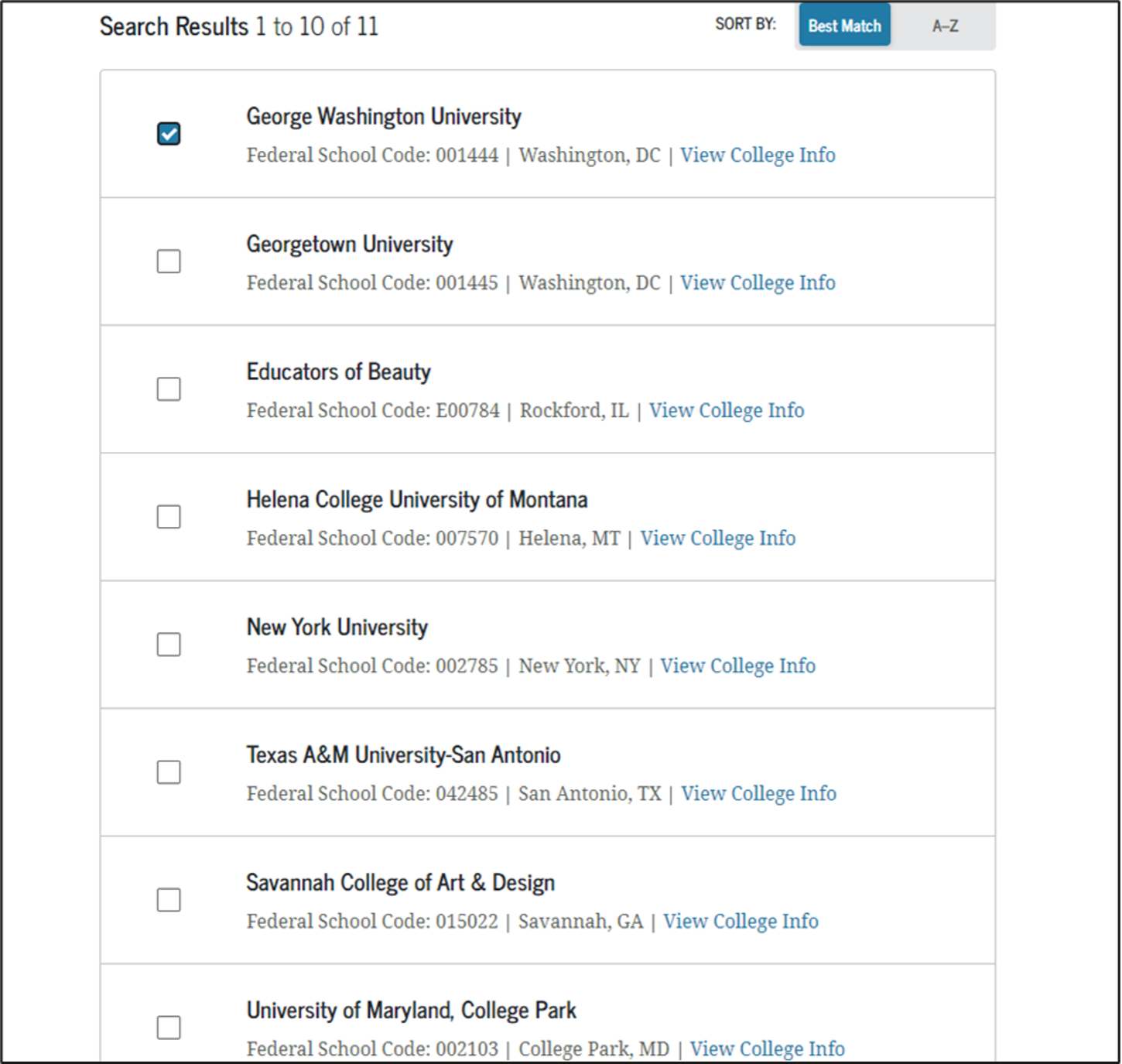
- Once you select your school from the previous page, it will appear on this page.
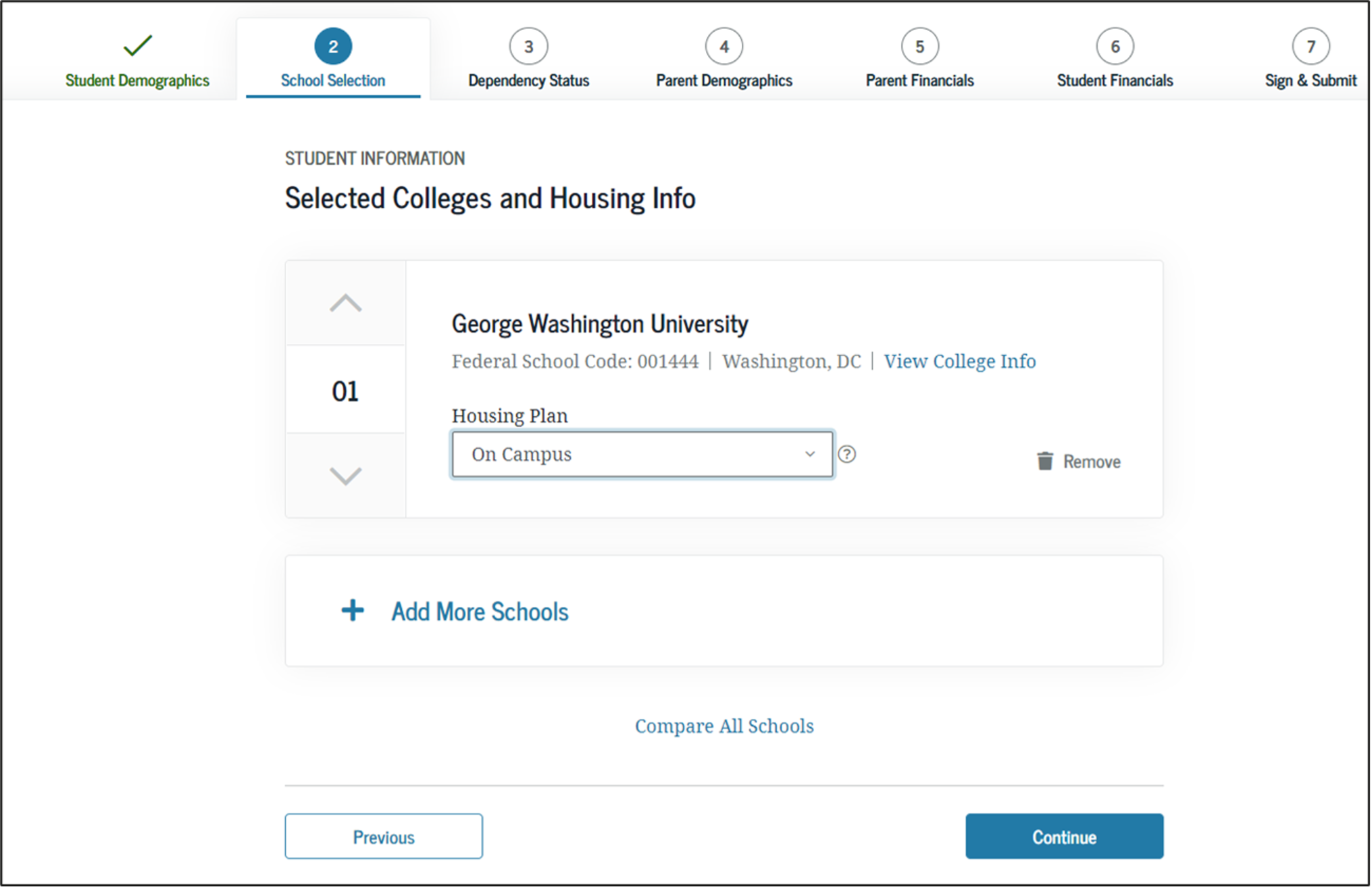
- Enter your housing plan for each school selection. If you plan to live in a dorm, your housing costs will be calculated using the amount that the school charges. If you live off-campus, you'll be awarded a housing allowance.
Step Four: Dependency Status
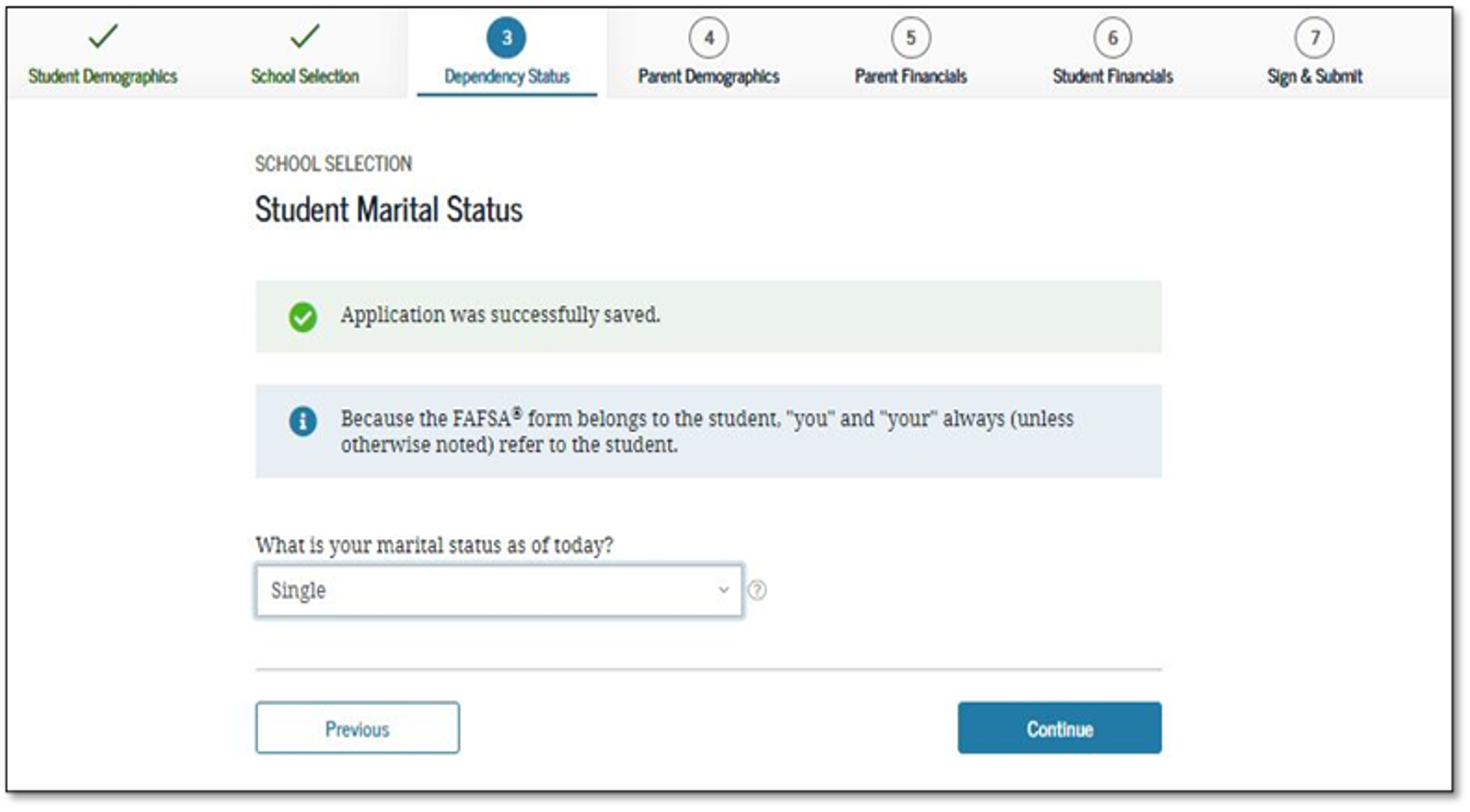
- 2023-24 “Student Marital Status” view.
- Note: This is the first page of the Dependency Status section.
- Select your marital status as of today from the dropdown. You are asked about your marital status in order to determine if you will be required to provide any spouse’s information along with your own throughout the application.
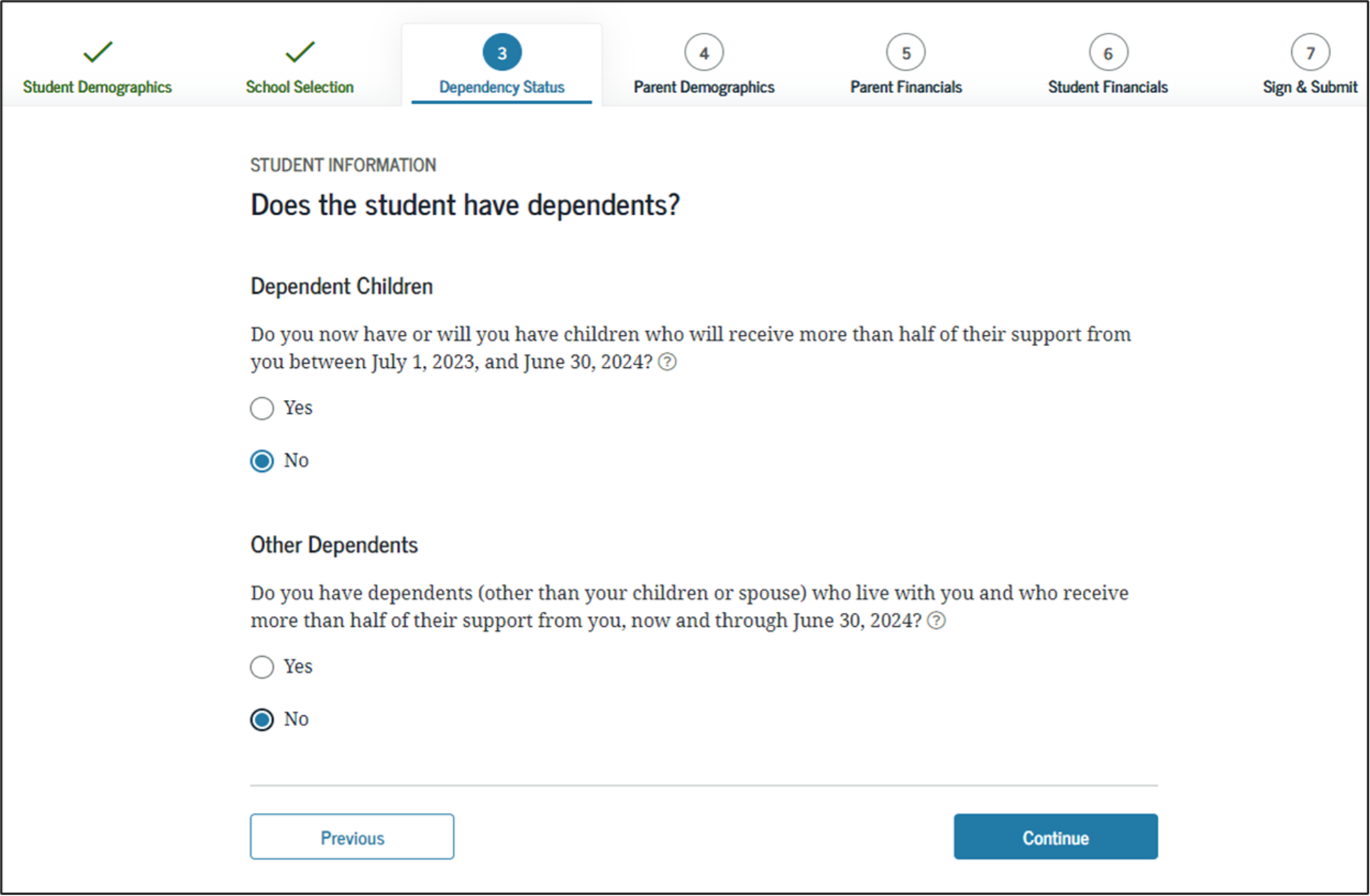
- Select "Yes" if you have children, or are expecting children in the year for which you are applying for aid. Select "No" if not.
- Select "Yes" if you have a dependent (someone who may not be your own child, or possibly even a parent), AND you also provide more than 50% of their living expenses. Select "No" if not.
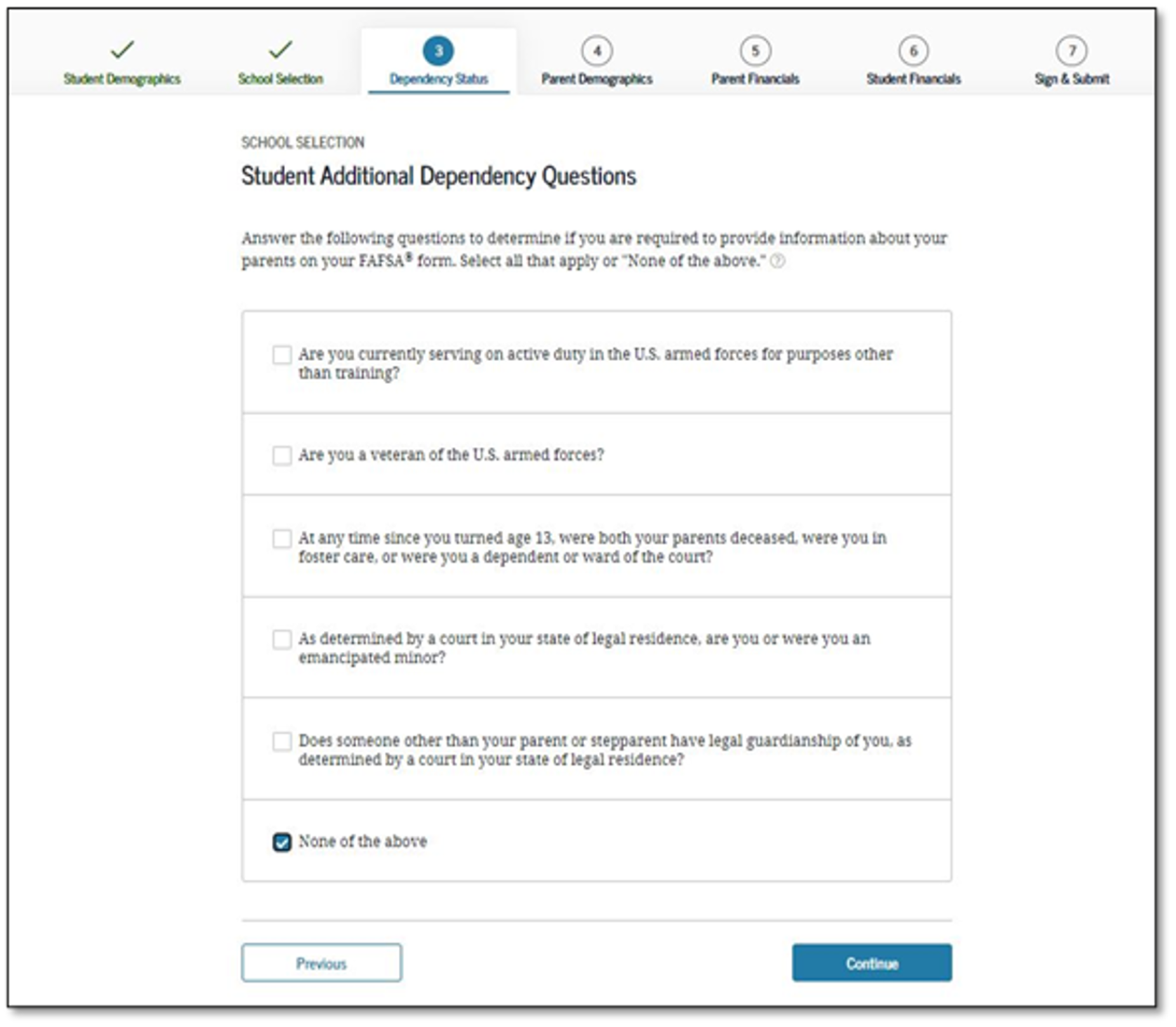
- Your answers to questions on the FAFSA® form determine whether you are considered a dependent or independent student. our dependency status determines whose information you must report on the Free Application for Federal Student Aid (FAFSA®) form.
- If you’re a dependent student, you will report your and your parents’ information.
- If you’re an independent student, you will report your own information (and, if you’re married, your spouse’s).
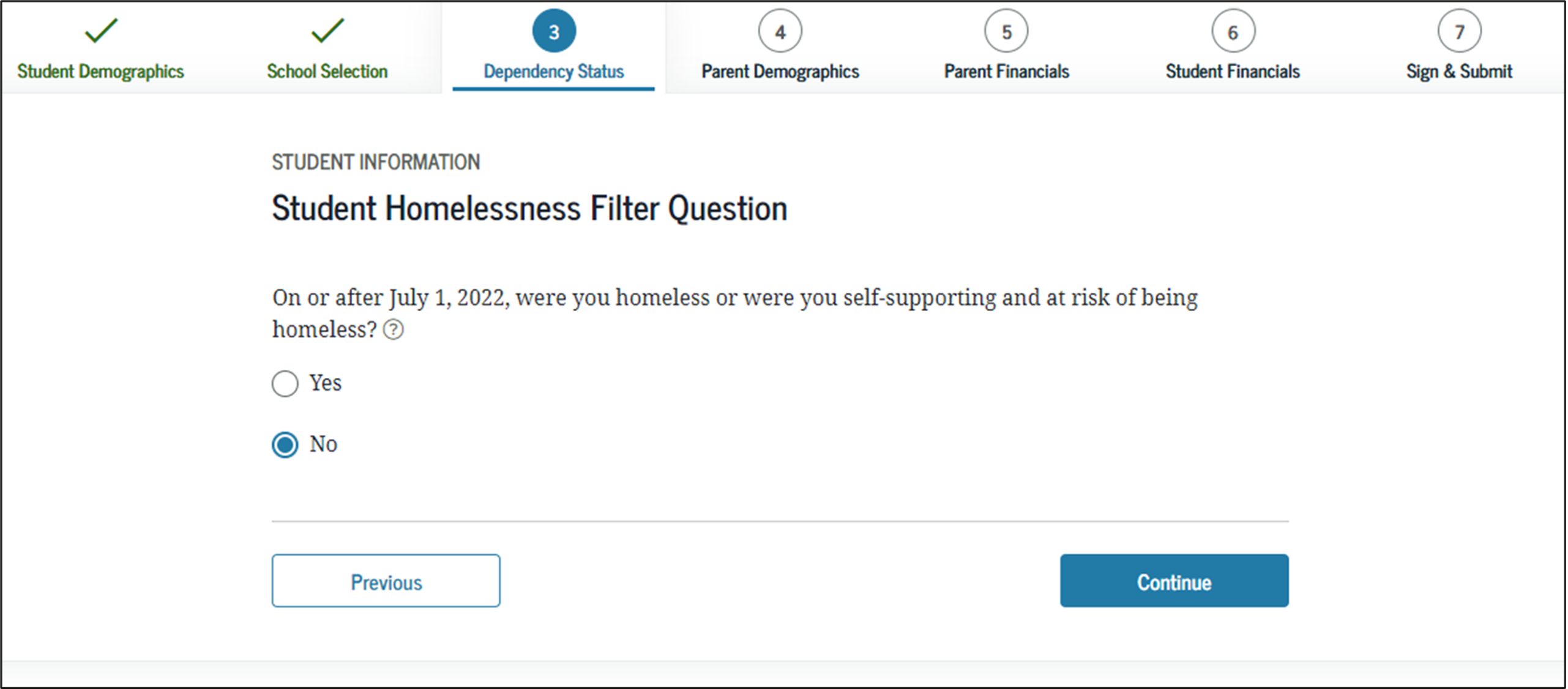
- 2023-24 “Student Homelessness Filter Question” view.
- If you state on the FAFSA that you are homeless, you can submit the application without including information related to your parents' income. Stating “yes” to the homeless question indicates that you are not with your parents, making you an independent student with special circumstances. You will be required to submit supporting documentation of this claim to the financial aid office of the school you plan to attend.
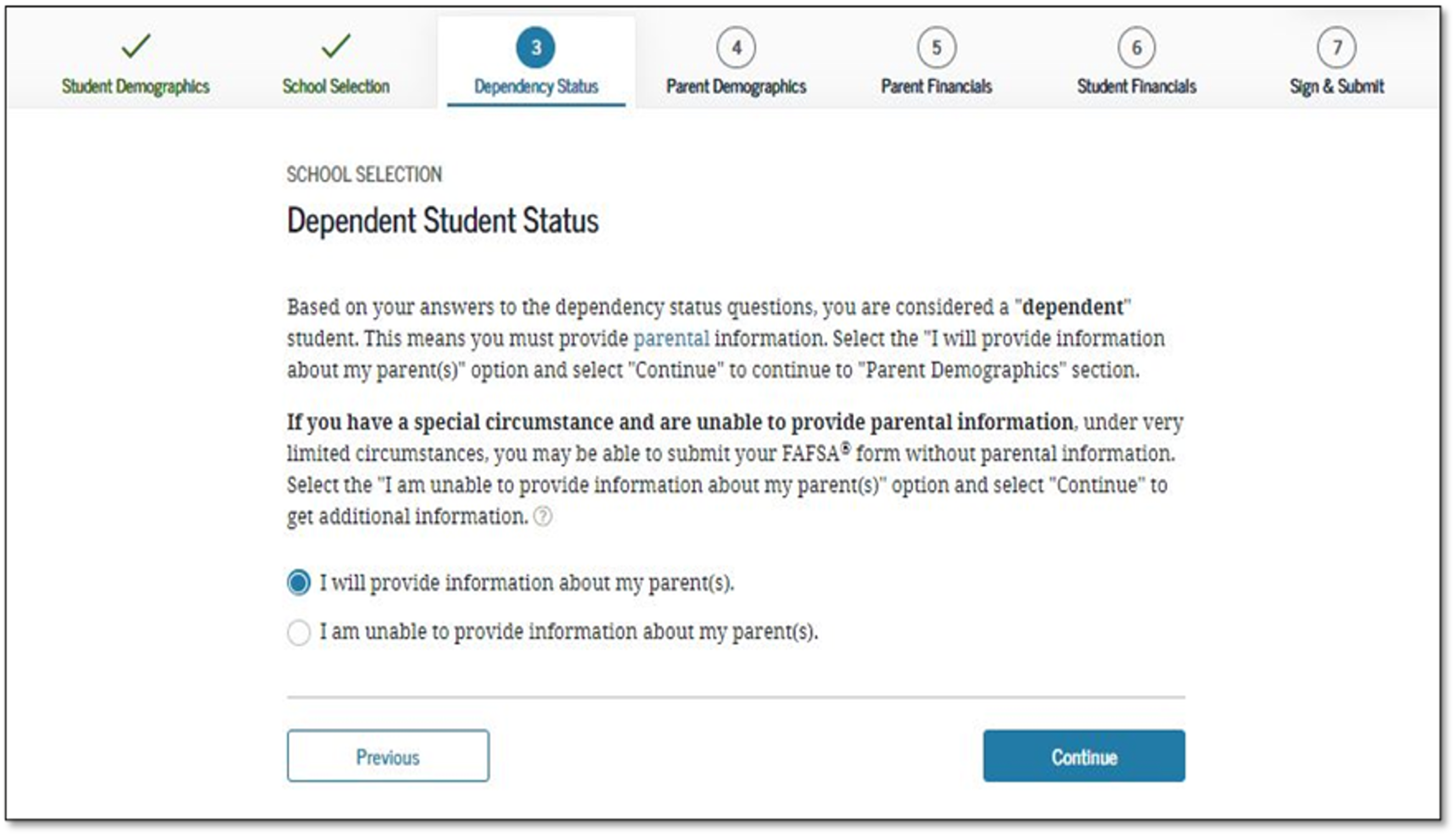
- 2023-24 “Dependent Student” view.
- This page only displays if it has been determined that the applicant is considered to be dependent.
Step Five: Parent Demographics
Whose Information Should I Provide?
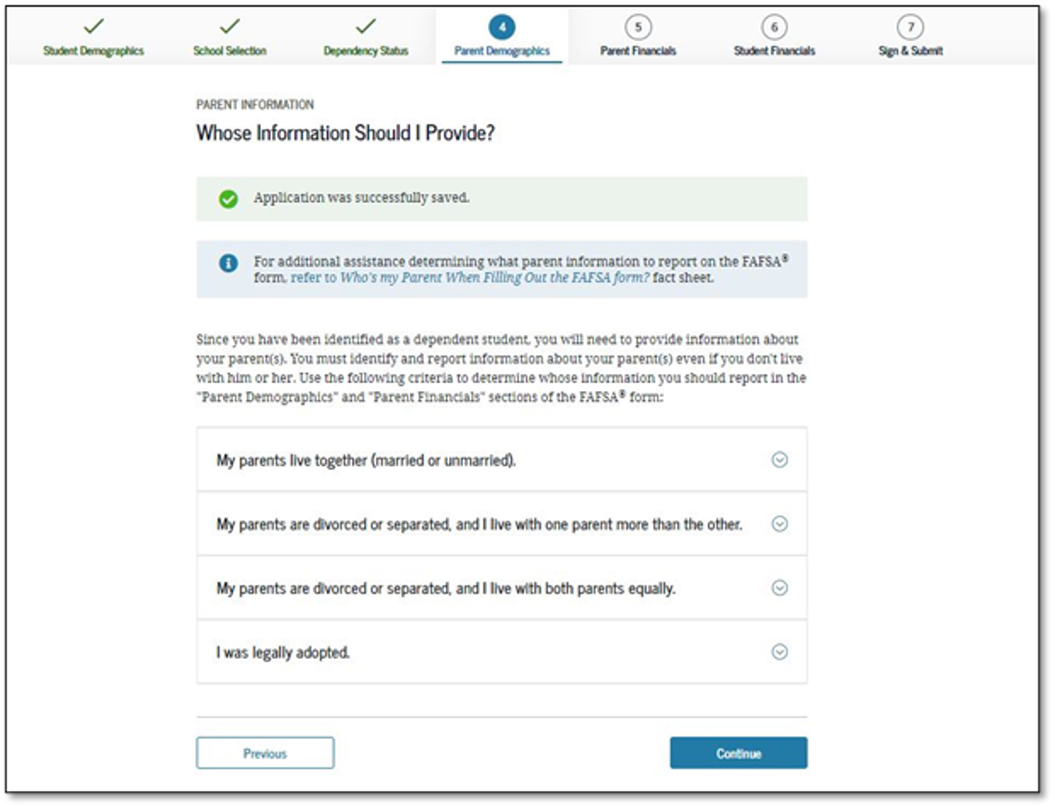
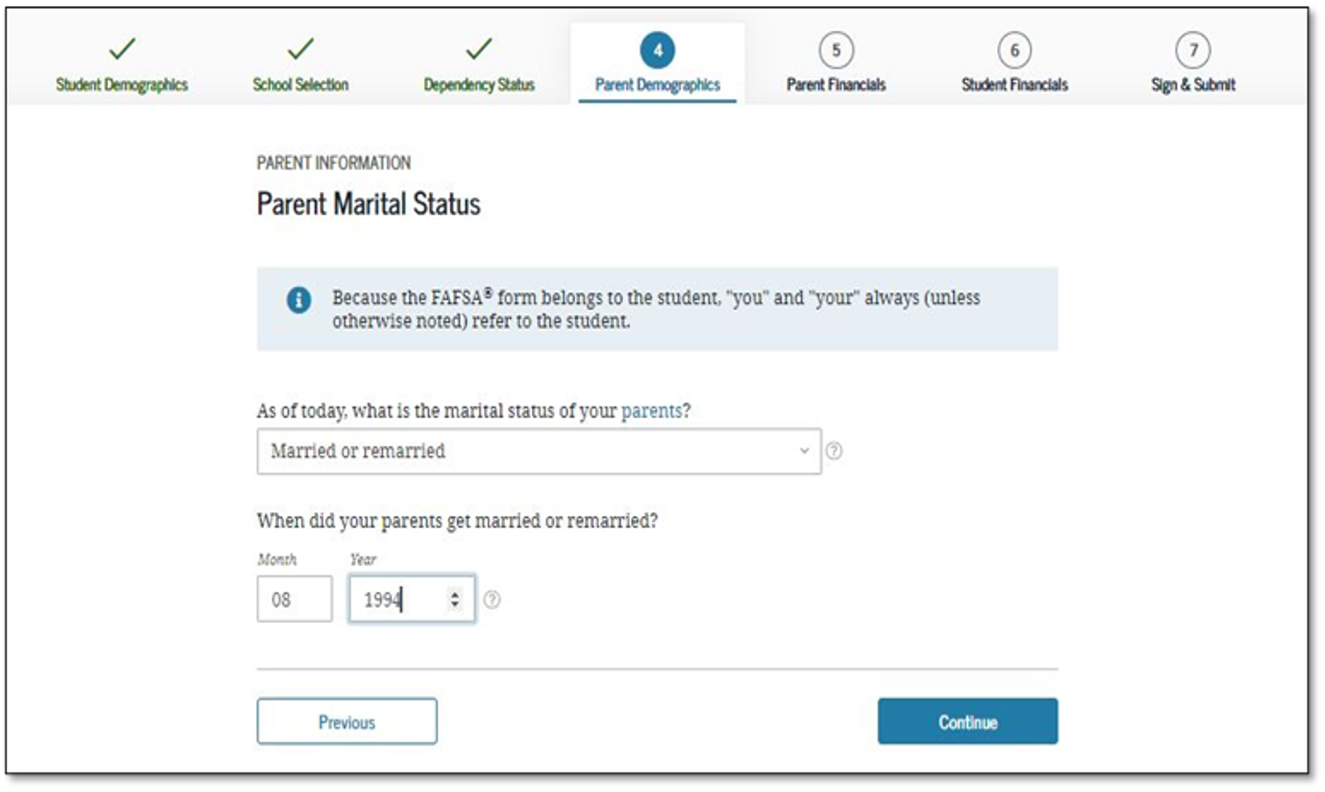
- 2023-24 “Parent Marital Status” view.
- Note: This is the first view in the Parent Demographics section.
- Select the marital status of your parents from the dropdown. As a point of clarification, if one of your biological parents is divorced from the other, you will only need to report the financial information of the parent who has legal custody of you.
- Note: This is a smart question and the response to marital status may generate additional questions.
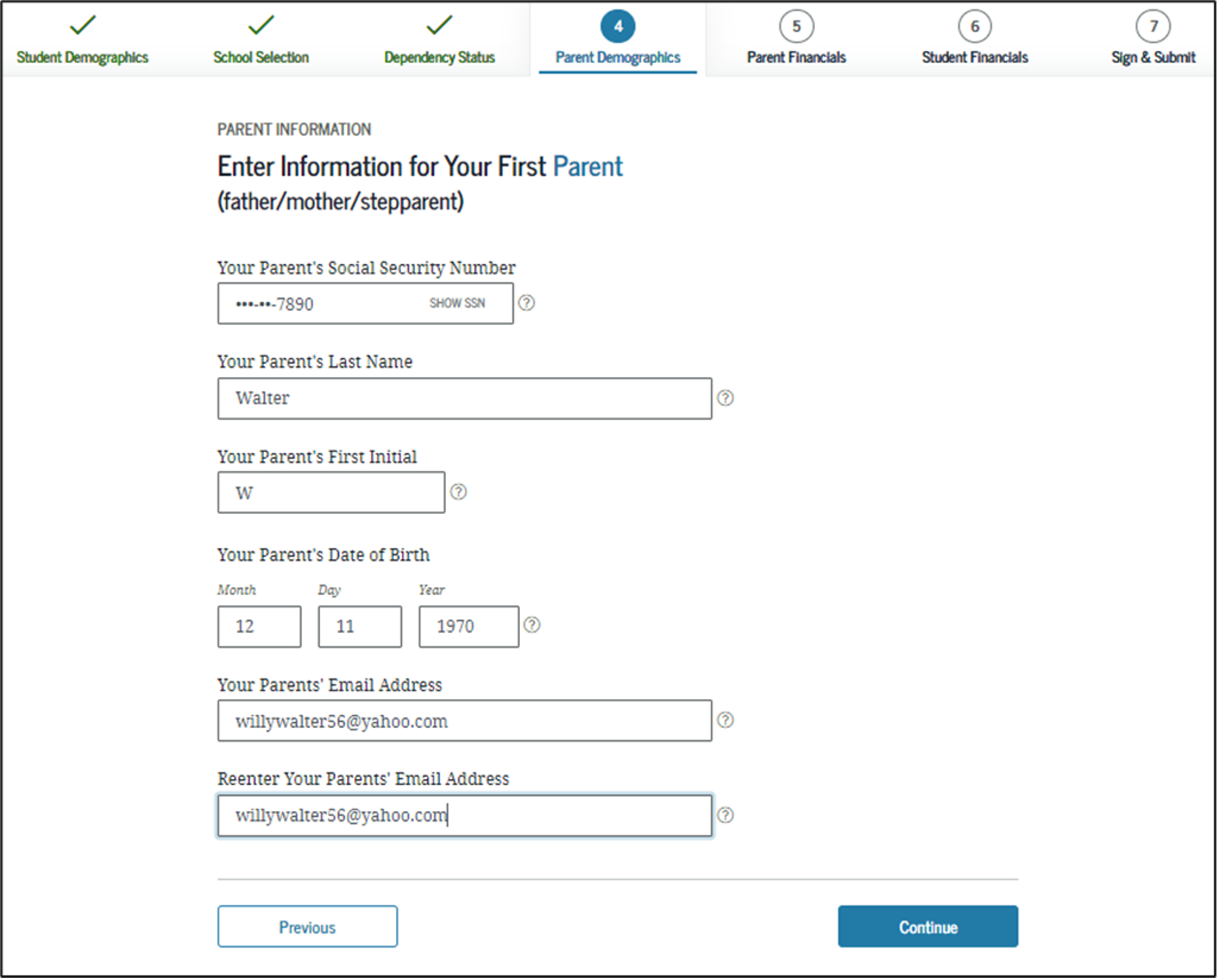
- 2023-24 “Personal Information for Parent” view.
- You may choose whichever of your parents for either field, but do not mix “first parent” figures with “other parent” as this may cause an error in your application. If your parent does not have a Social Security Number, you must enter 000-00-0000.
- Includes your parents last name as it appears on their Social Security card(s) and birth certificate(s). If the name includes a suffix, such as Jr. or III, include a space between the last name and suffix.
- Include your parents first initial as it appears in their first name on their Social Security card(s) and birth certificate(s).
- Includes your parent’s date of birth as it appears on their Social Security card(s) and birth certificate(s). Enter two digits for each day and month (e.g., for May 31, enter 05 31).
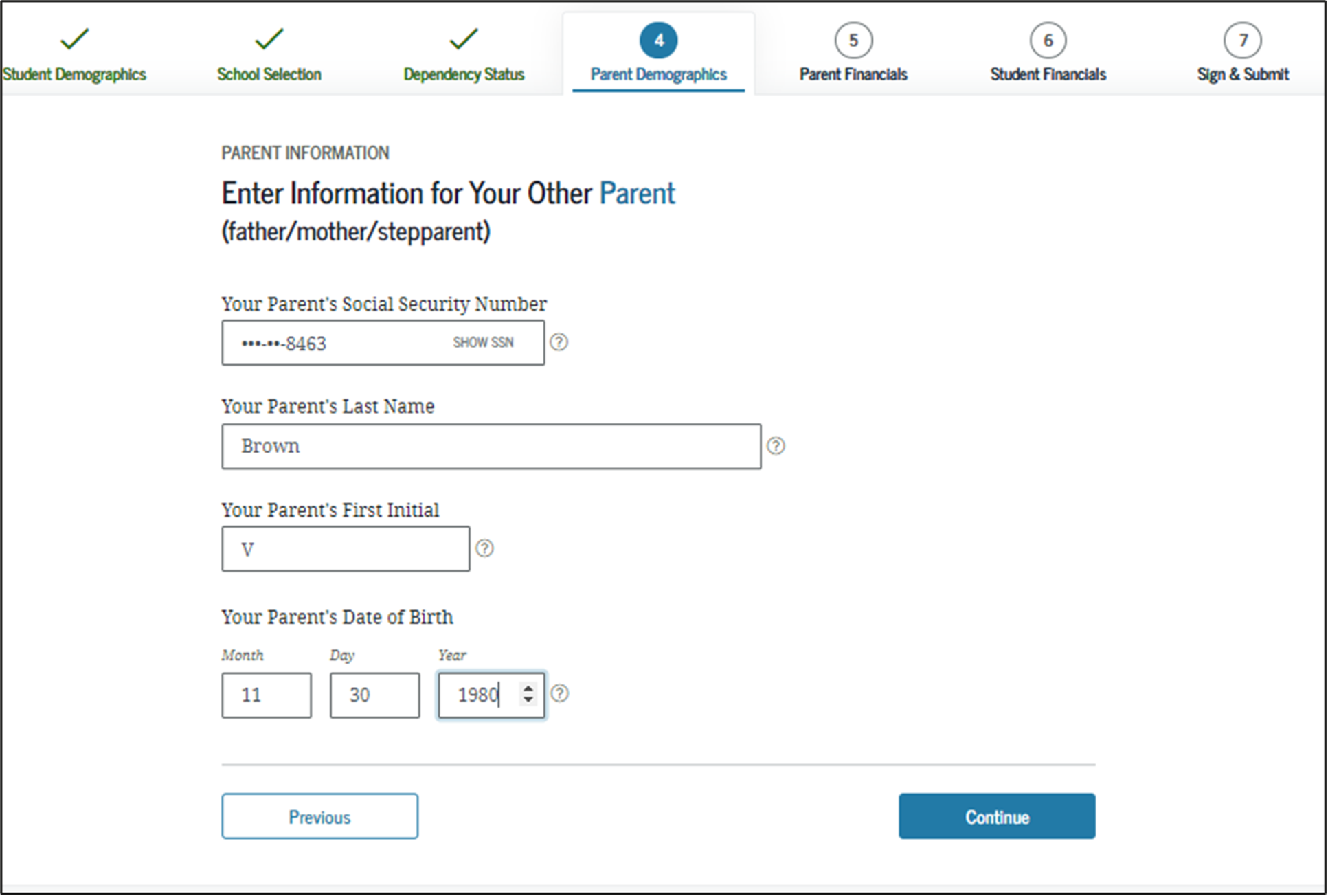
- 2023-24 “Personal Information for Other Parent” view.
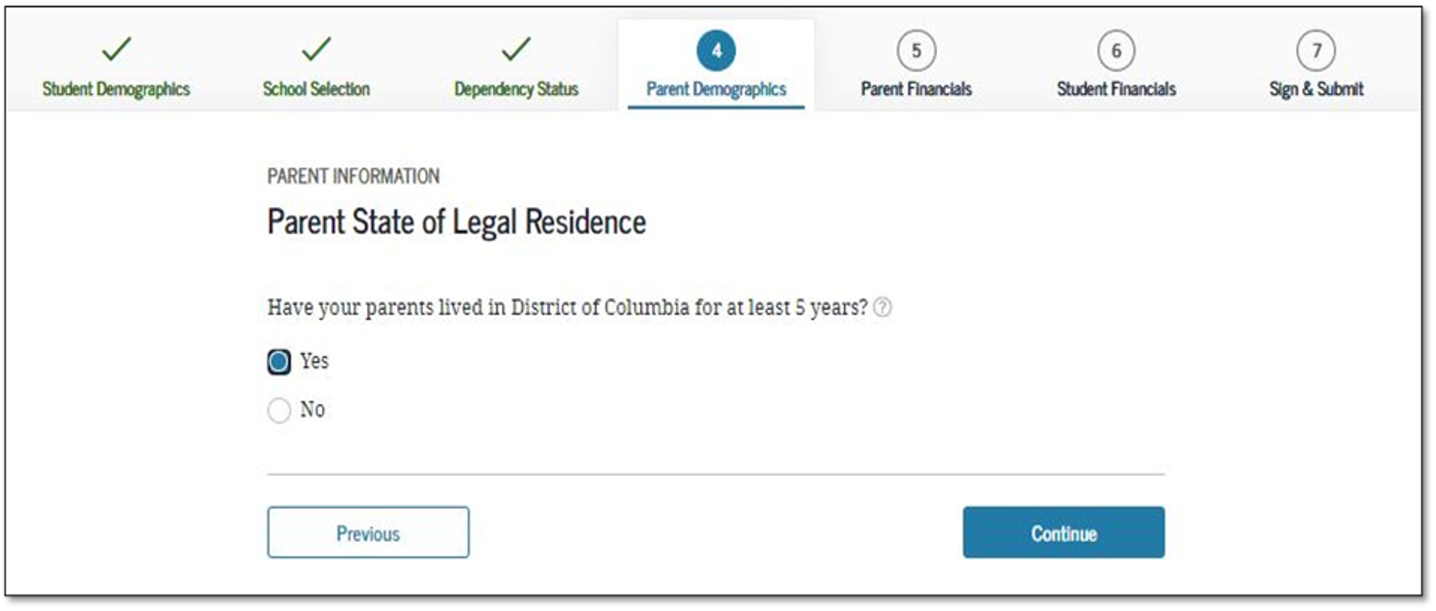
- 2023-24 “Parent State of Legal Residence” view.
Enter Information for Your Parent's Dependents
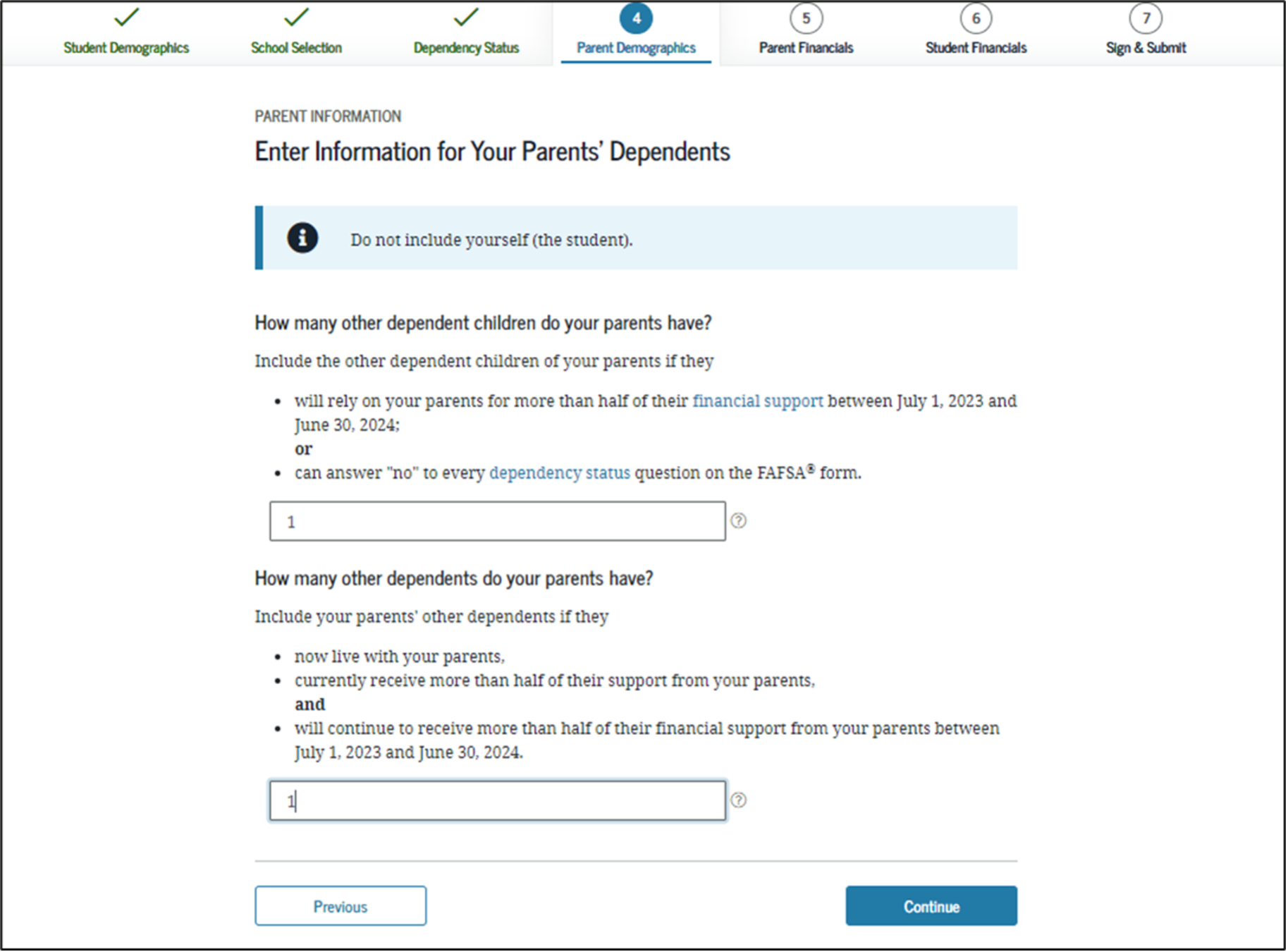
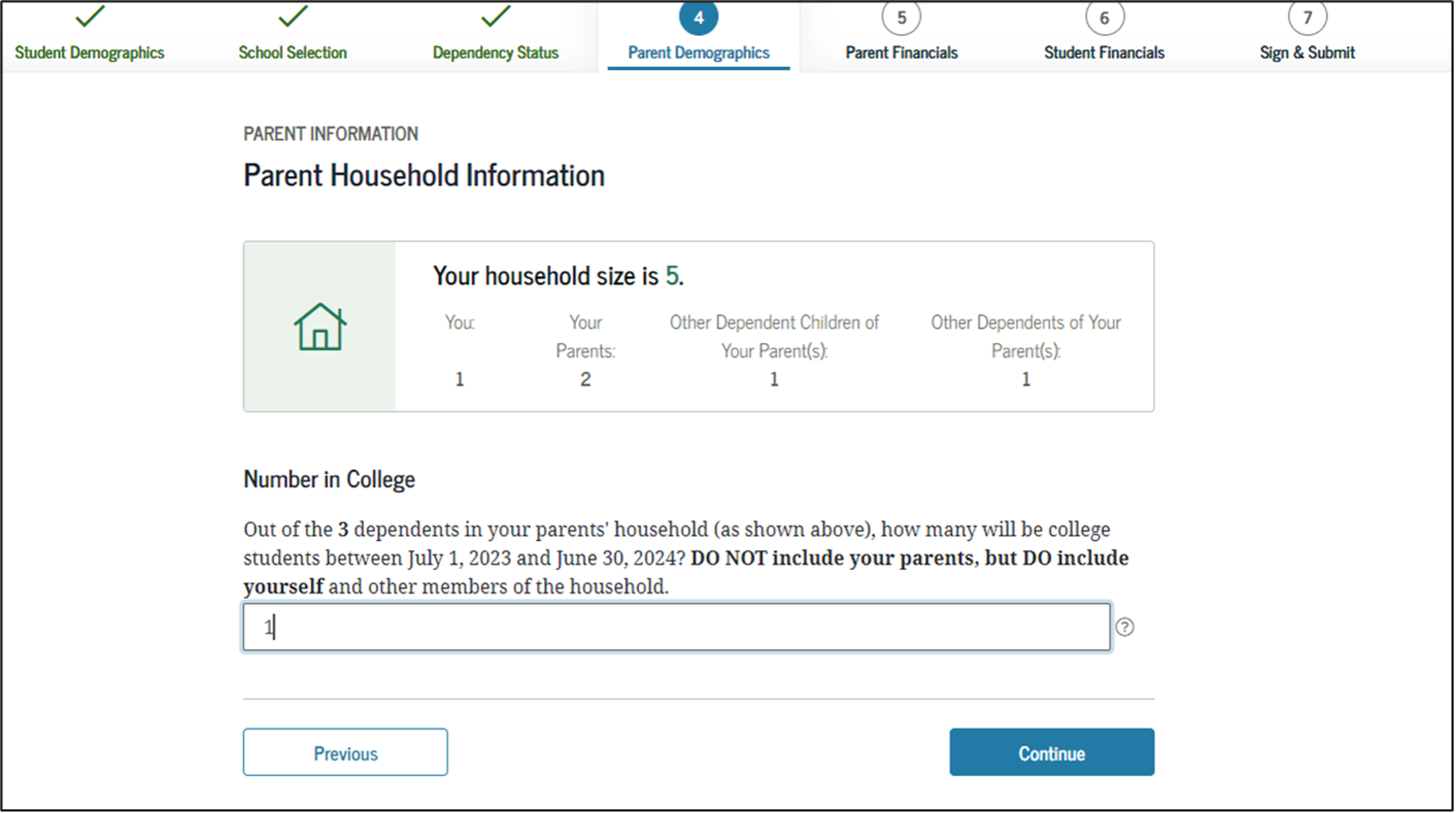
- 2023-24 “Parent Household Info” view.
- Parents are required to complete the household size worksheet in an effort to get more accurate information about the number in the parent’s household and the number of those in the household who are in college. Some information will be prefilled, based on responses provided previously within the FAFSA form. The system tallies the totals as the parent completes the worksheet to ensure that there are no mathematical errors.
- You will want to count the number of people living in your household/home, beginning with yourself, then your parent(s), and any other siblings or relatives for whom your parent(s) pay 50% or more of their financial support
- For “Number in College,” count yourself, but also include any siblings who will attend and be enrolled as part-time students, as well. You do not want to include your parents in this section, even if they are in college or a degree-seeking program. Adults who have already earned a degree, are in graduate or professional programs, or who are over the age of 24 will not be counted as simultaneously being in college during the same period as you.
Step Six: Parent Financials
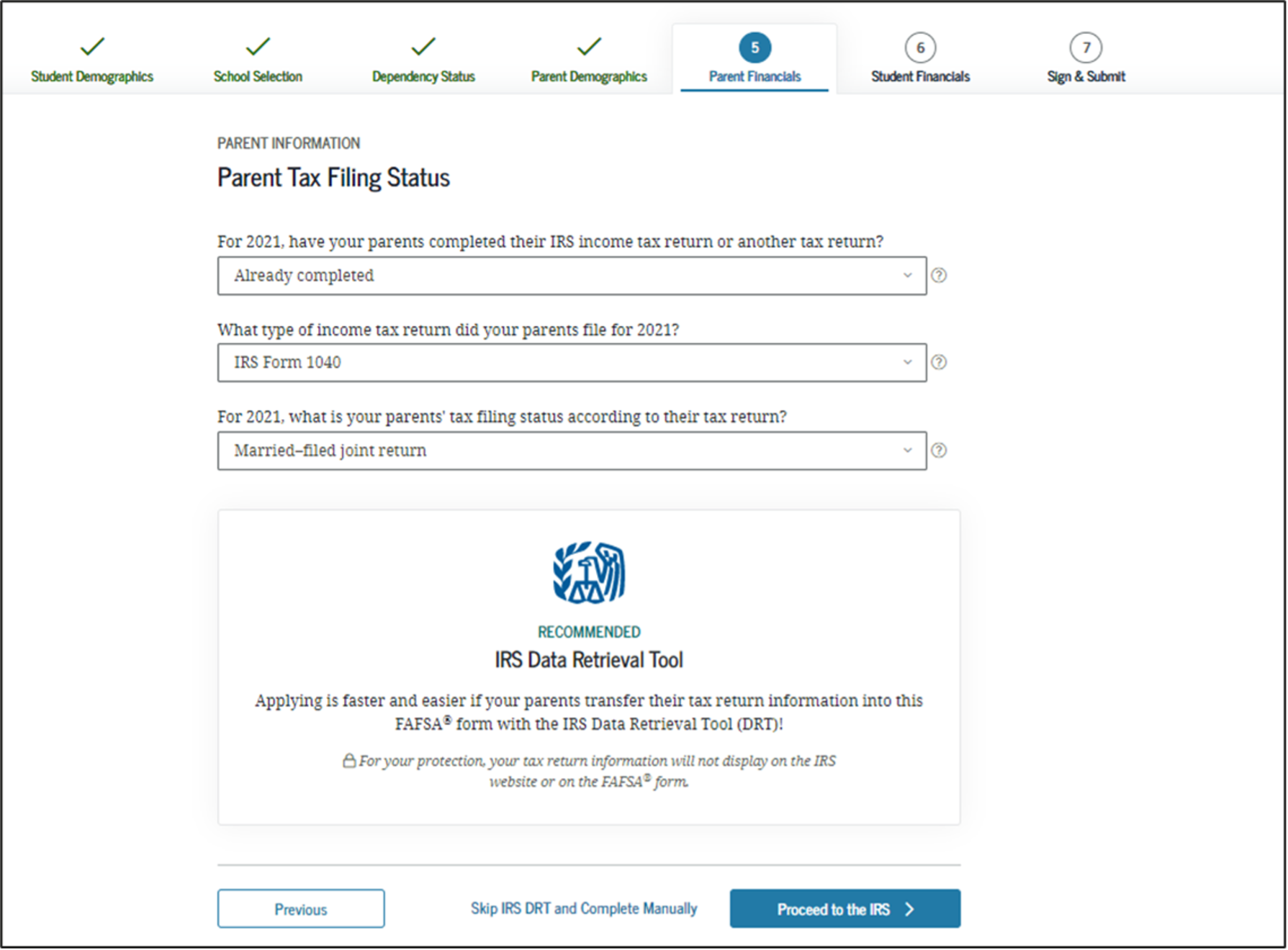
- 2023-24 “Parent Tax Filing Status” view.
- Note: This is the first view in the Parent Financials section.
- Parents completed IRS tax return: This specific question asks your parent/parent's what their tax filing status is for the tax year 2021. You may select from the drop menu whether your parent/parents: “Already Completed”, “Will File”, or “Not Going to File.” There is no wrong answer, but it is important to be as accurate as possible. This view is displayed when the parent chooses not to use the IRS Data Retrieval Tool (DRT) on the previous view. An additional opportunity is presented to the parent to determine if he or she would like to link to the IRS for his or her financial information or to continue to enter it manually.
- Parents tax filing status: Select what your parent/parent's tax filing status is according to their 2021 tax return.
- IRS Data Retrieval Tool: By using the IRS Data Retrieval Tool, parents who are eligible can automatically transfer their tax information into the FAFSA. This will prevent errors and help avoid any processing delays.
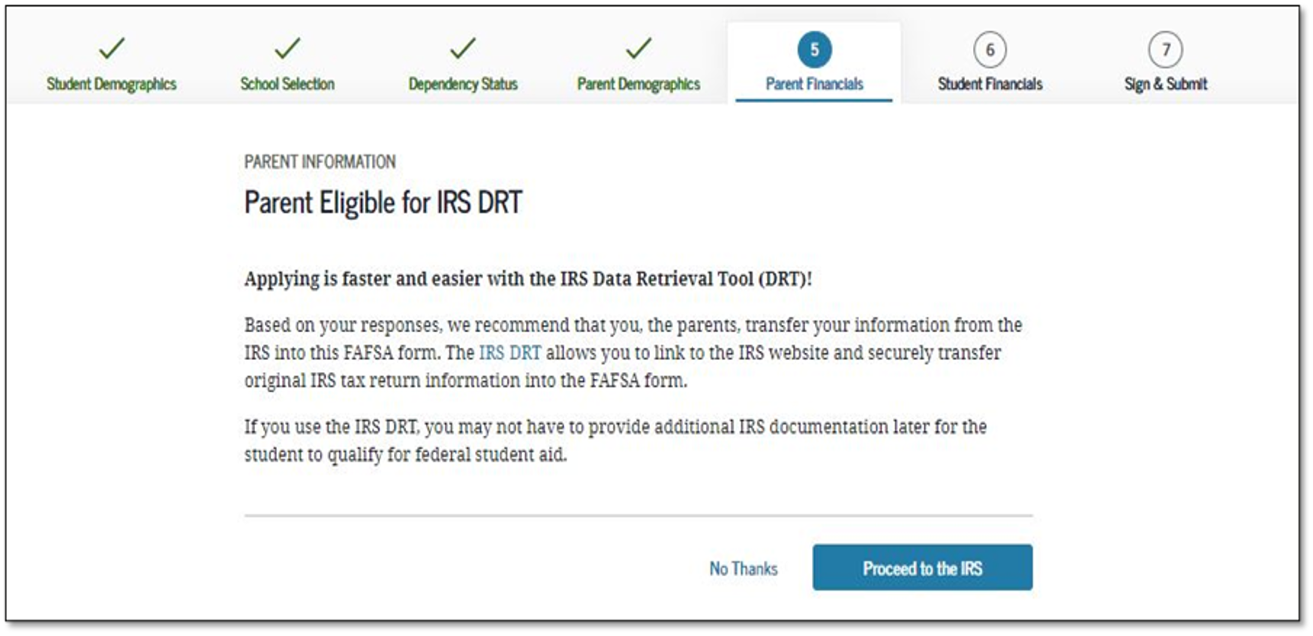
- 2023-24 “Parent Eligible for IRS DRT” view.
- This view is displayed when the parent chooses not to use the IRS Data Retrieval Tool (DRT) on the previous view. An additional opportunity is presented to the parent to determine if they would like to link to the IRS for their financial information or to continue to enter it manually.
Parent Log In to IRS Data Retrieval Tool
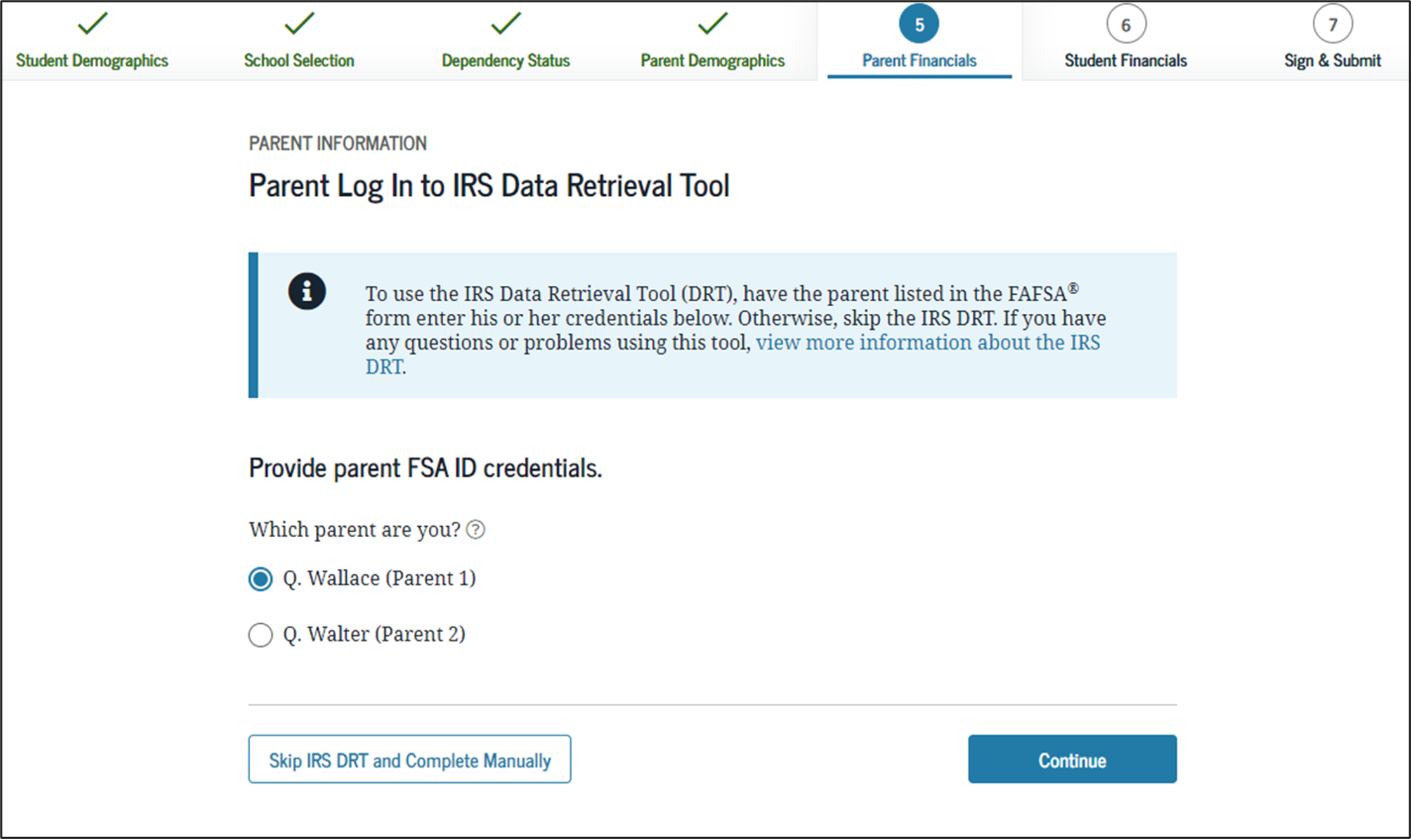
- This view shows if the user decides to use the IRS Data Retrieval Tool. Additionally, this view only displays if the parent was not already authenticated.
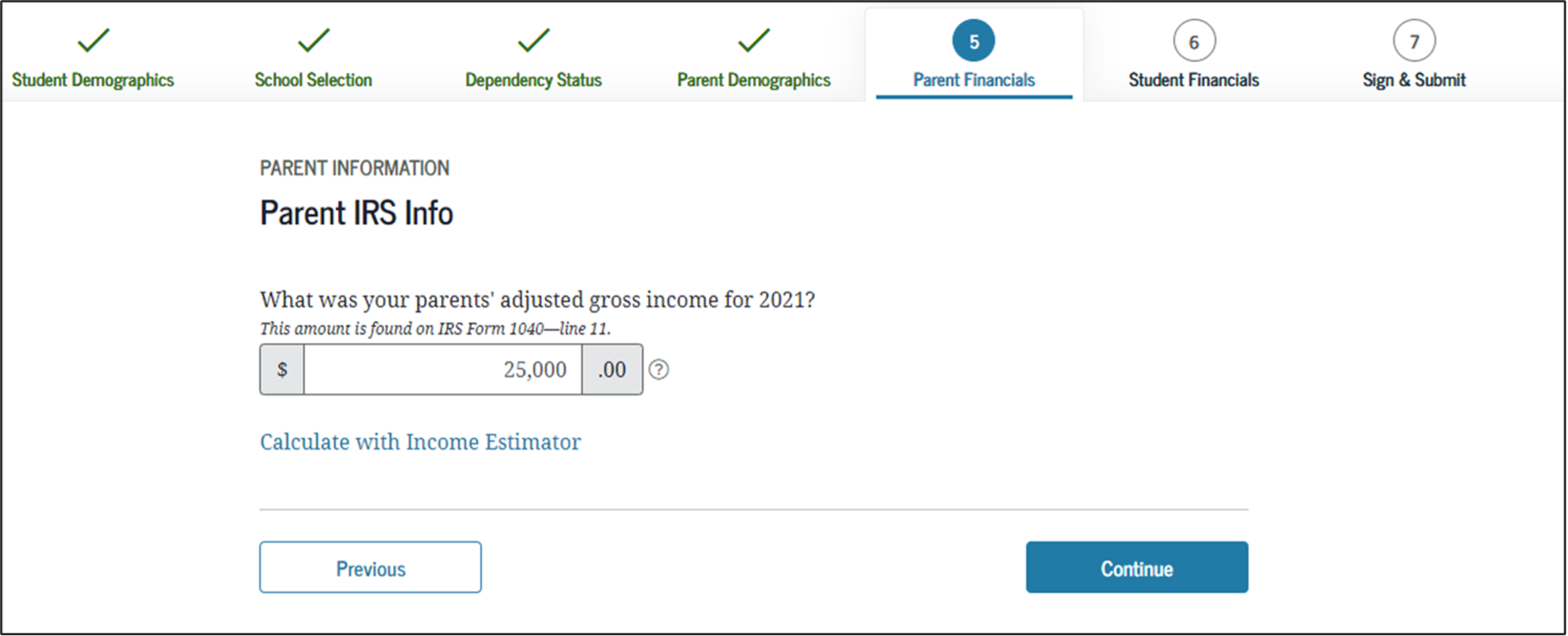
- 2023-24 “Parent IRS Info” view.
- Note: If the parent is either ineligible or decides not to use the IRS DRT, they will be required to enter their financial information manually.
- This figure can be found on either Line 11 (1040). Parents who are married, but file separate returns will need to combine their AGIs from their individual return for this field. If your parent/parents are eligible and choose to use the IRS Data Retrieval tool, the fields in this section will automatically be populated for them.
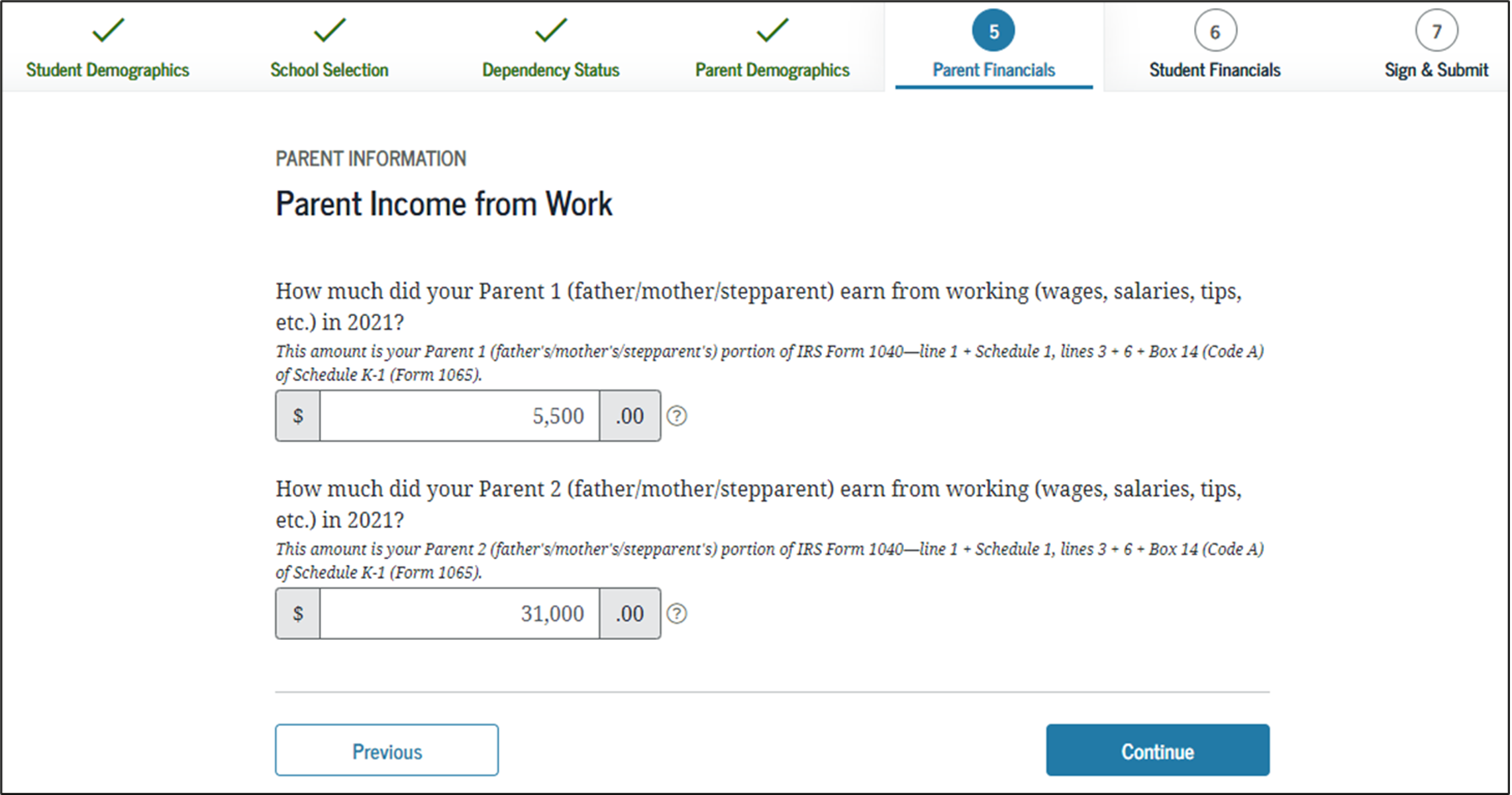
- Note: This is a smart question and therefore might look different based on your prior inputs.
- For either tax return, use the following to impute their earnings: IRS Form 1040-line 1 + Schedule 1, lines 3 + 6 Box 14 (Code A) of Schedule K-1 (Form 1065).
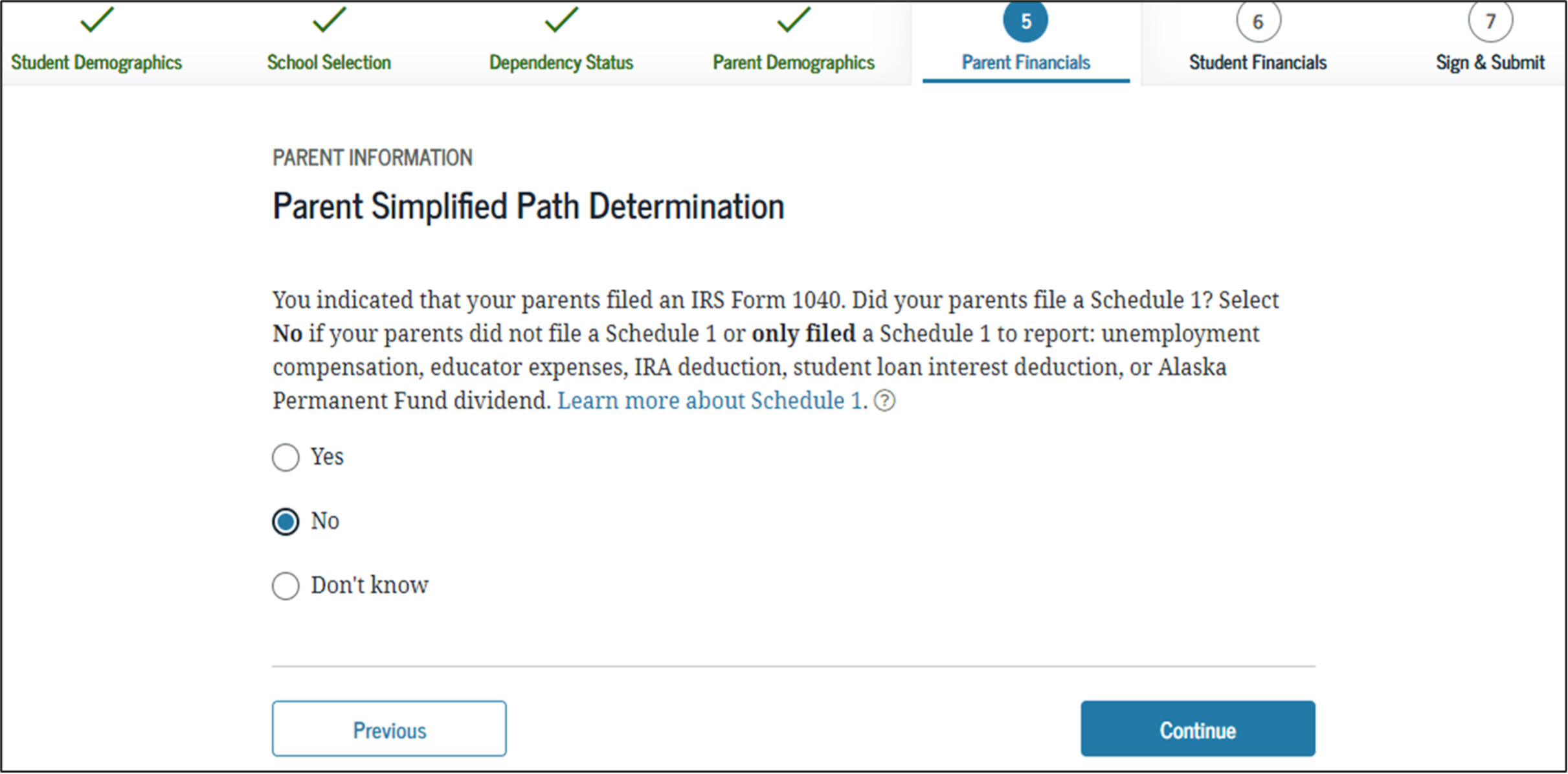
- This view collects the parent financial information used to determine if the student’s application qualifies for simplified needs path. The user selects "no" because the parent didn't file a Schedule 1 or only filed a Schedule 1 to report the following: unemployment compensation, educator expenses, IRA deduction, student loan interest deduction, or Alaska Permanent Fund dividend.
Parent Skip Remaining Questions view/h3>
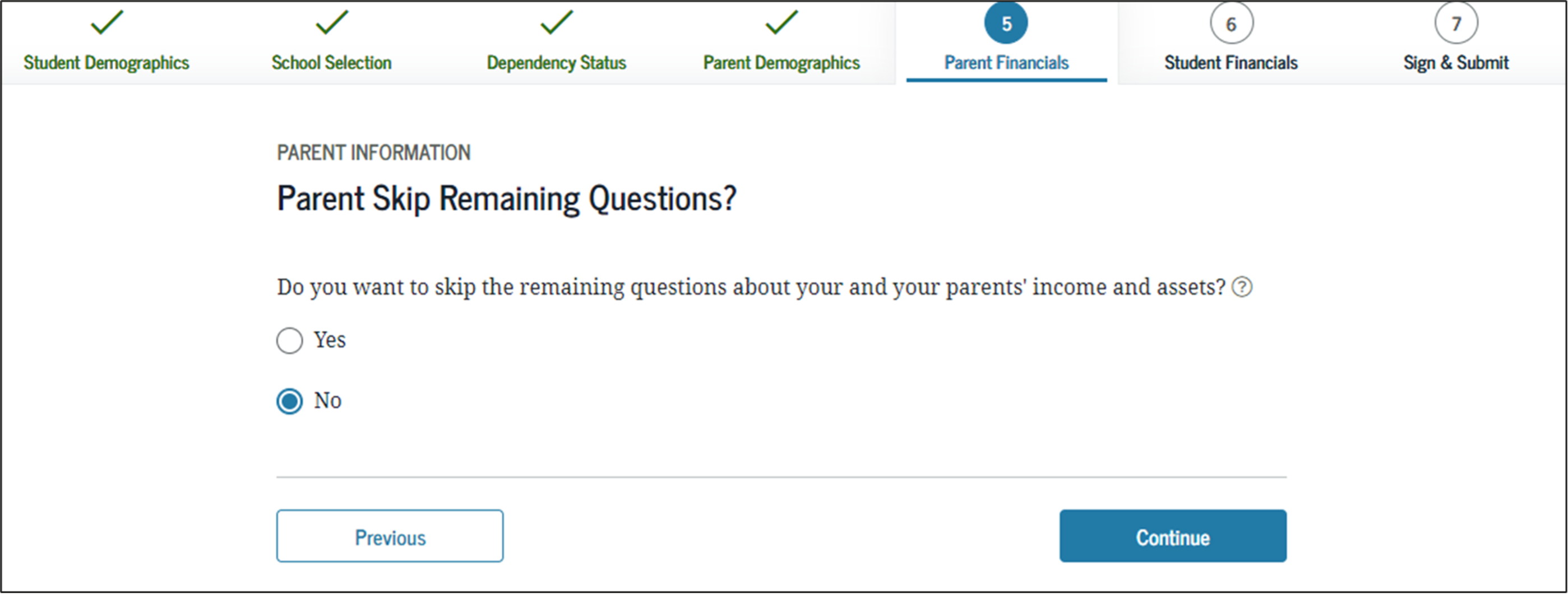
- The user has the option to select "No" or "Yes." If "yes" is selected, the user will be able to skip the remaining questions about the parents' income and assets.
- The user selects "no" to answer the remaining questions about the parents' income and assets.
Parent Additional IRS Info
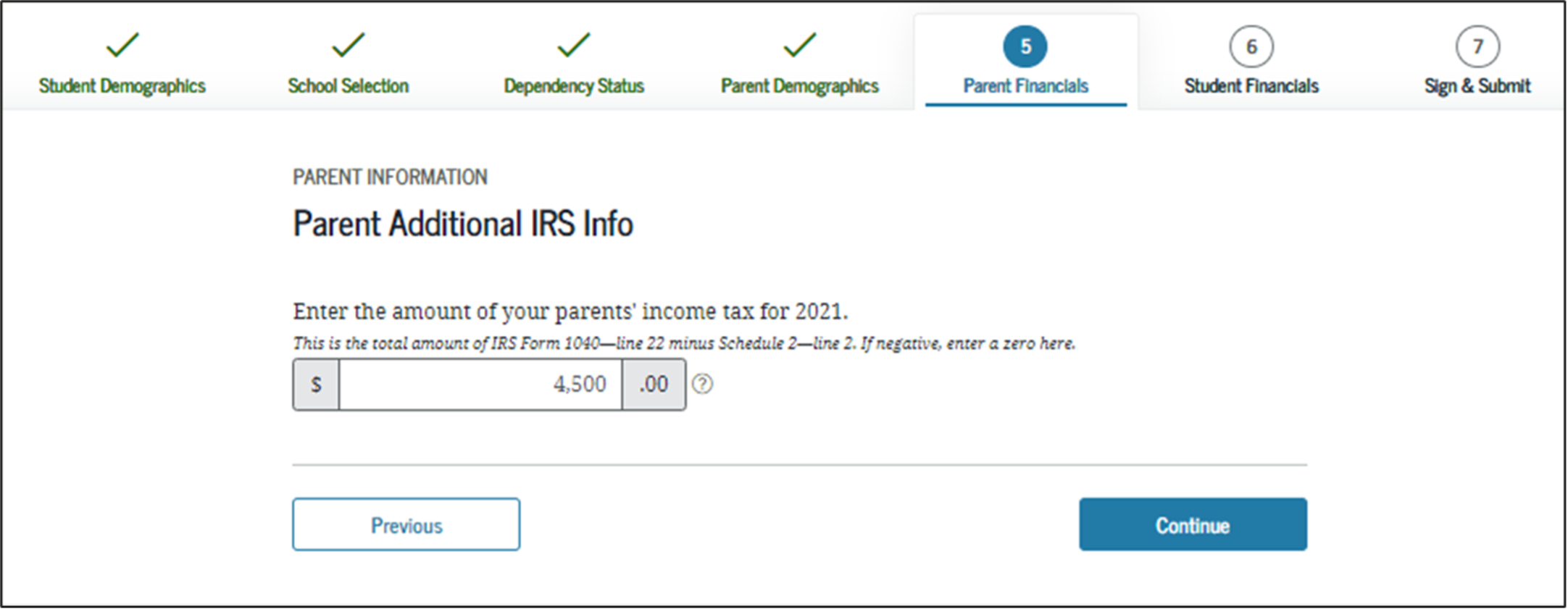
- Parent Additional IRS Info view. The user enters the amount of the parents' income tax for 2021.
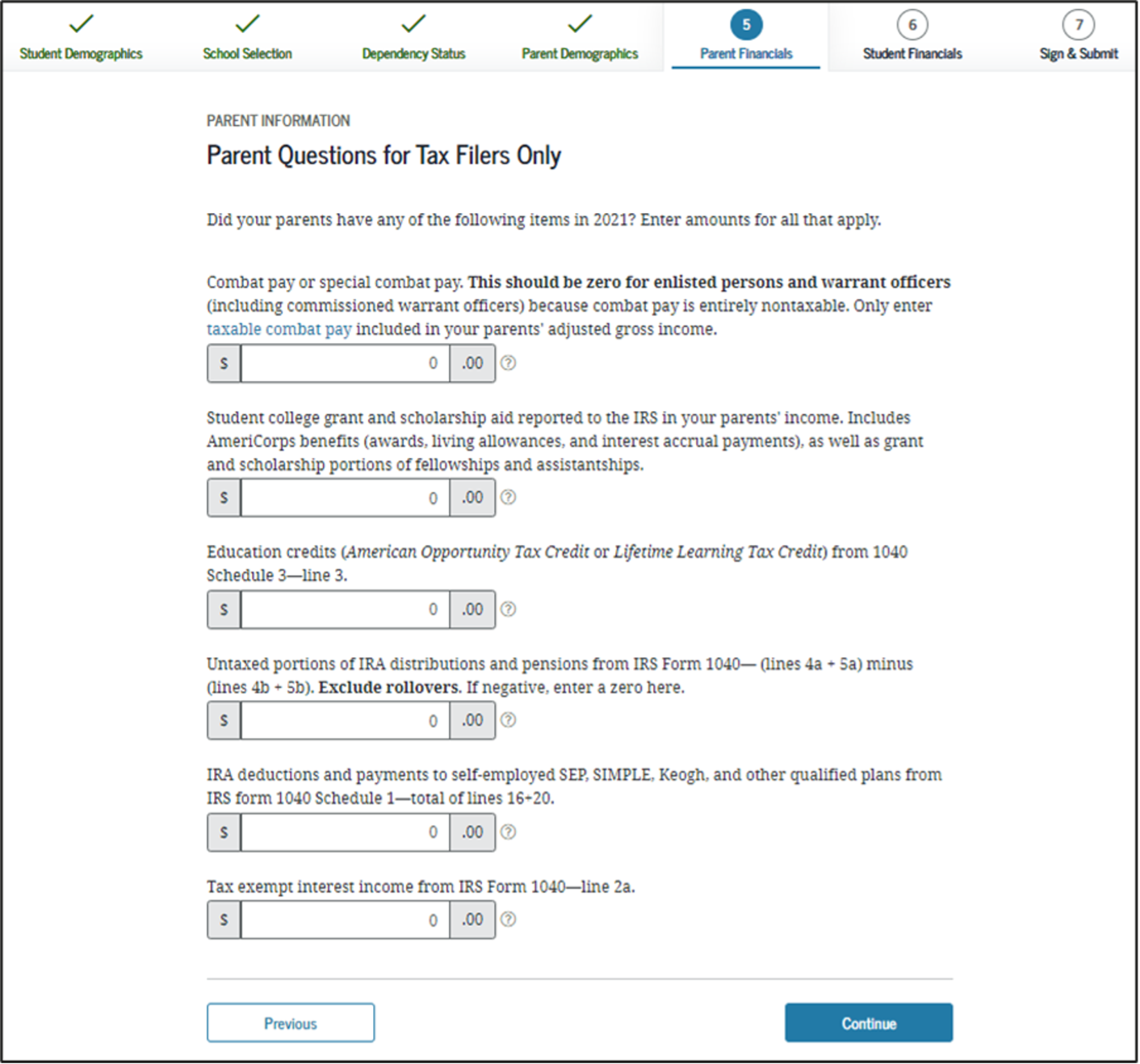
- Fill in your parent/parent's additional financial information based on these categories. If they do not apply, leave a “0.”
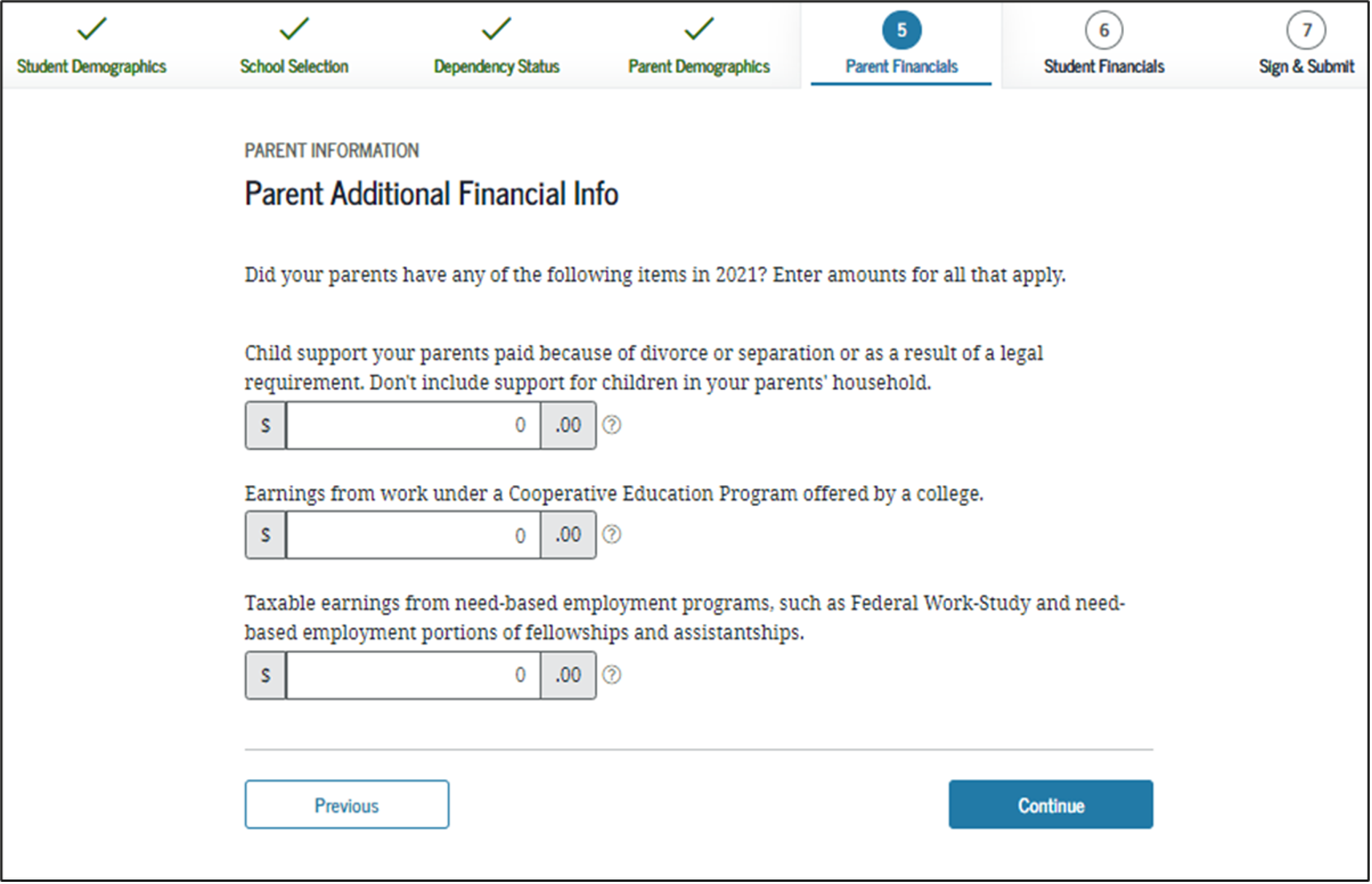
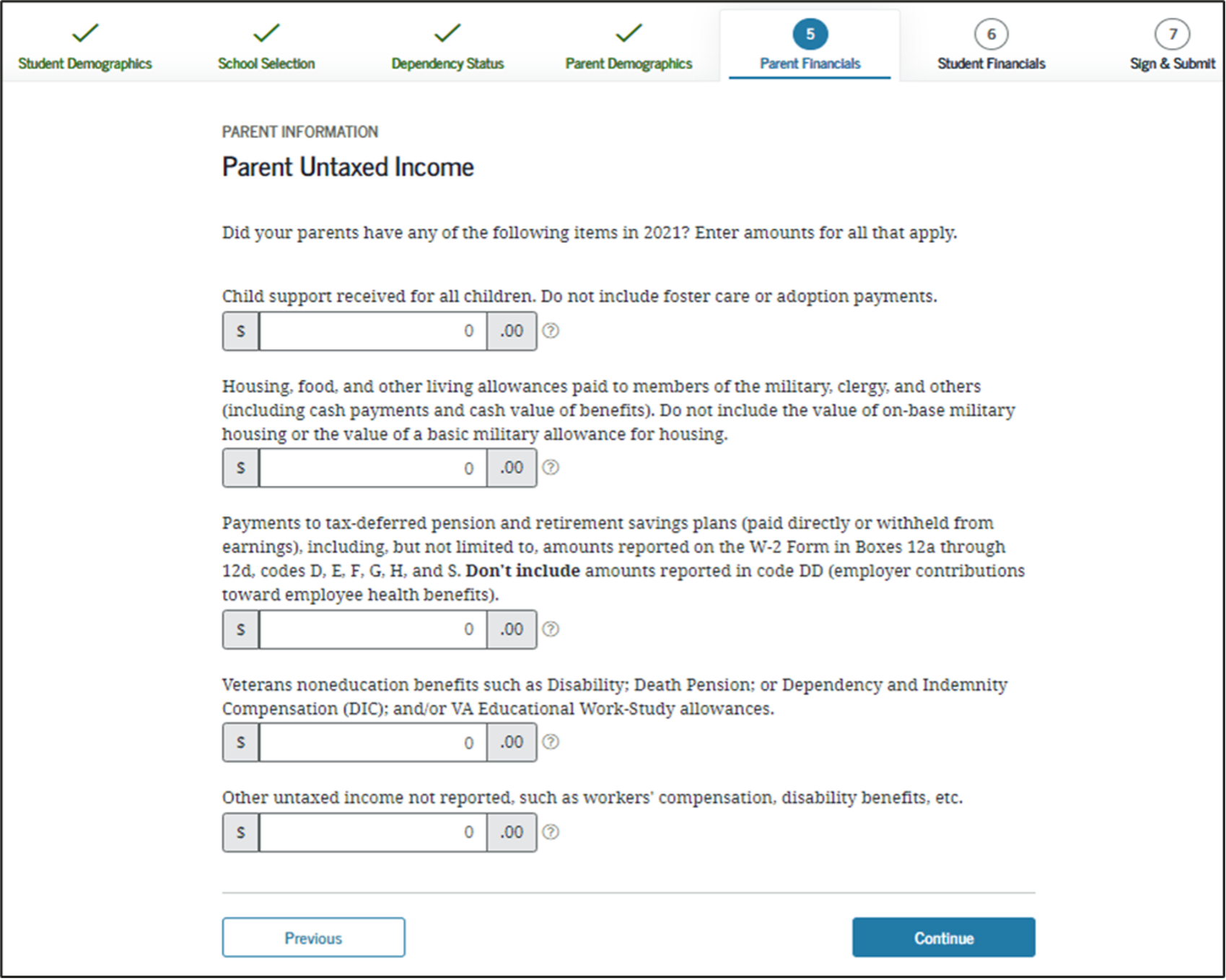
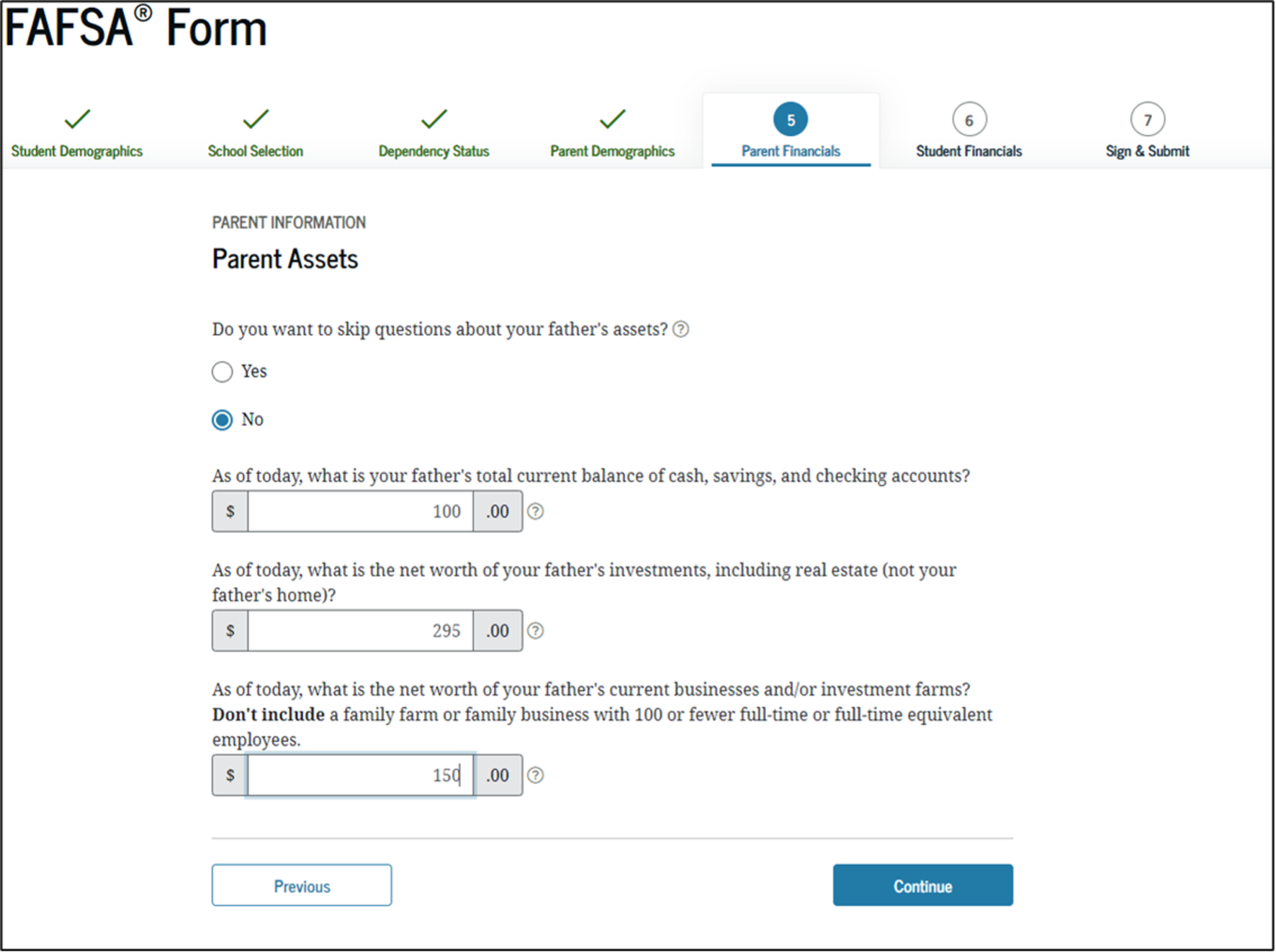
- 2023-24 “Parent Assets” view.
- Note: Since the parents meet the simplified needs path determination criteria, the assets questions are optional.
- Parents total balance of cash: Include the current total of your cash-in-hand, and totals of your checking and savings accounts.
- Parents net worth: Include the net worth of your investments, including real estate, but do NOT include the house that your parents reside.
- Parents net worth of business investments: Include the total value of your parents’ total investments. To do this, you will add the current value of all investments, subtracting any debts currently owed on them.
Step Seven: Student Financials
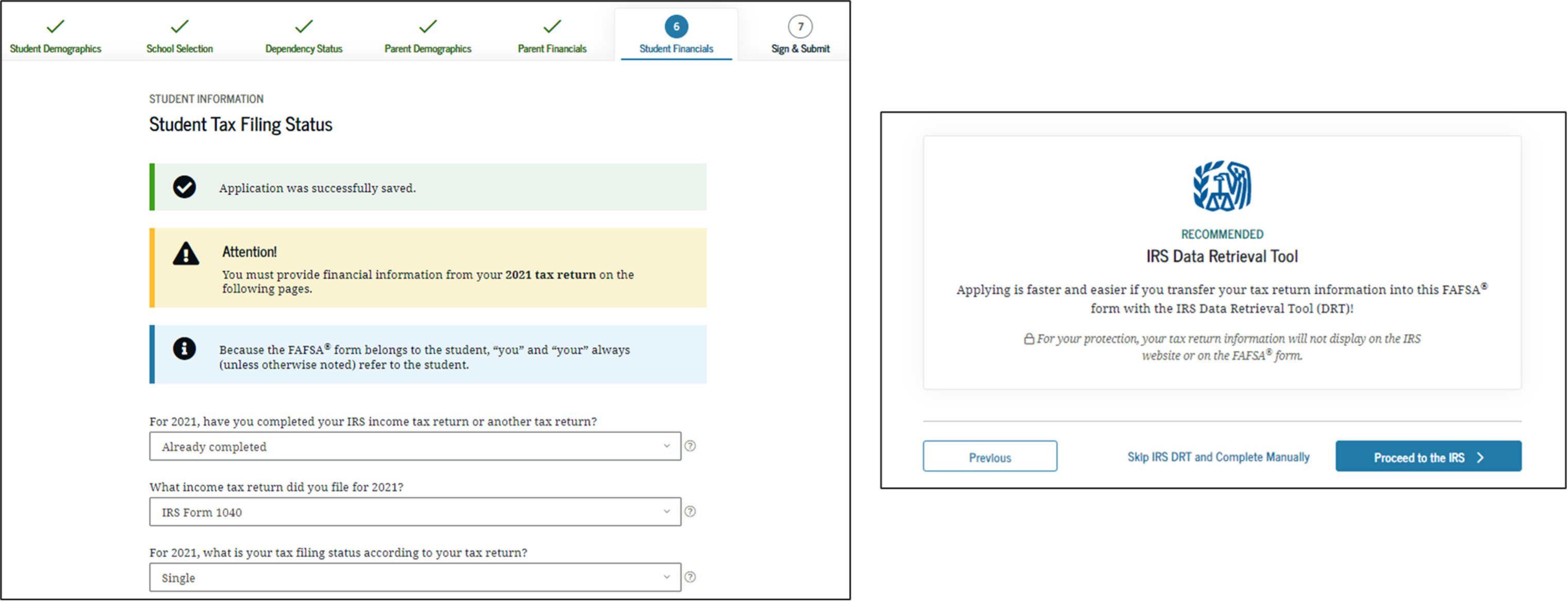
- Note: This is a smart question and the response to your tax return type may generate additional questions and comments.
- IRS tax return: You will need to answer this question based on whether or not you (the student) did, have not yet, or will not file a tax return. You should answer this question based on your current tax filing status for the previous year.
- Tax filing status: Select what your tax filing status is according to your 2021 tax return.
- IRS Data Retrieval Tool: By using the IRS Data Retrieval Tool, students who are eligible can automatically transfer their tax information into the FAFSA. This will prevent errors and help avoid any processing delays.
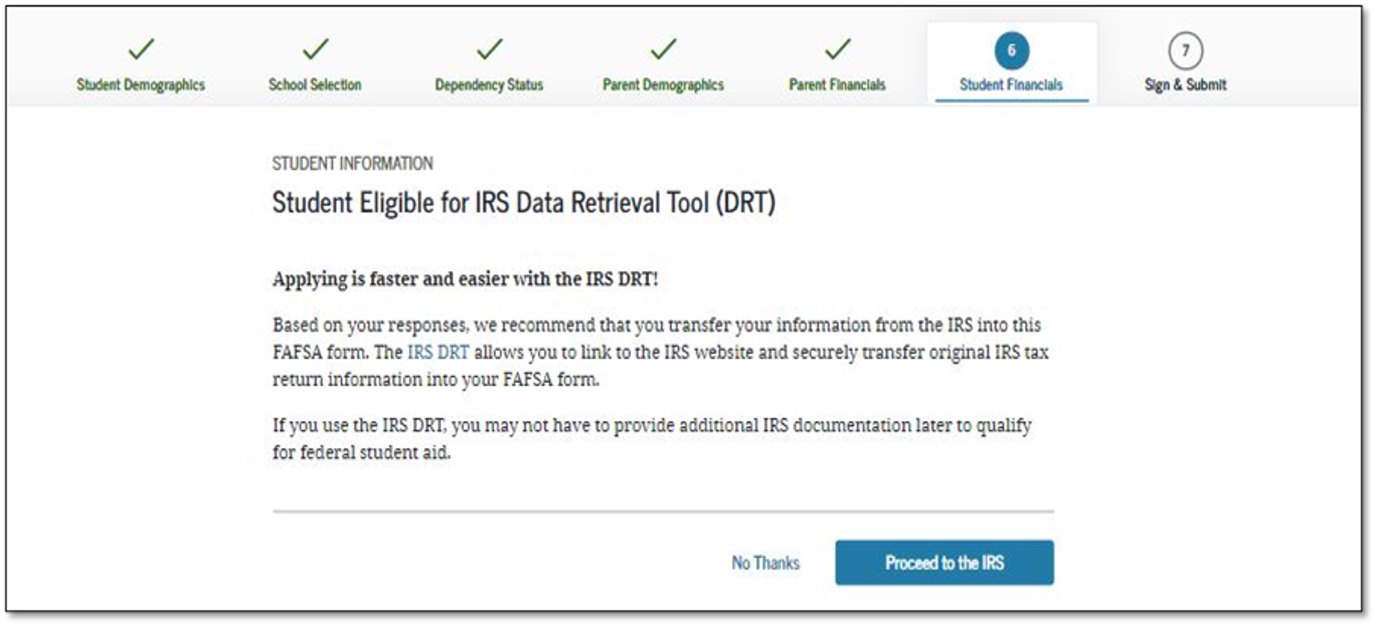
- 2023-24 “Student Eligible for IRS DRT” view.
- This view is displayed when the applicant chooses not to use the IRS Data Retrieval Tool (DRT) on the previous view. An additional opportunity is presented to the applicant to determine if they would like to link to the IRS for their financial information or to continue to enter it manually.
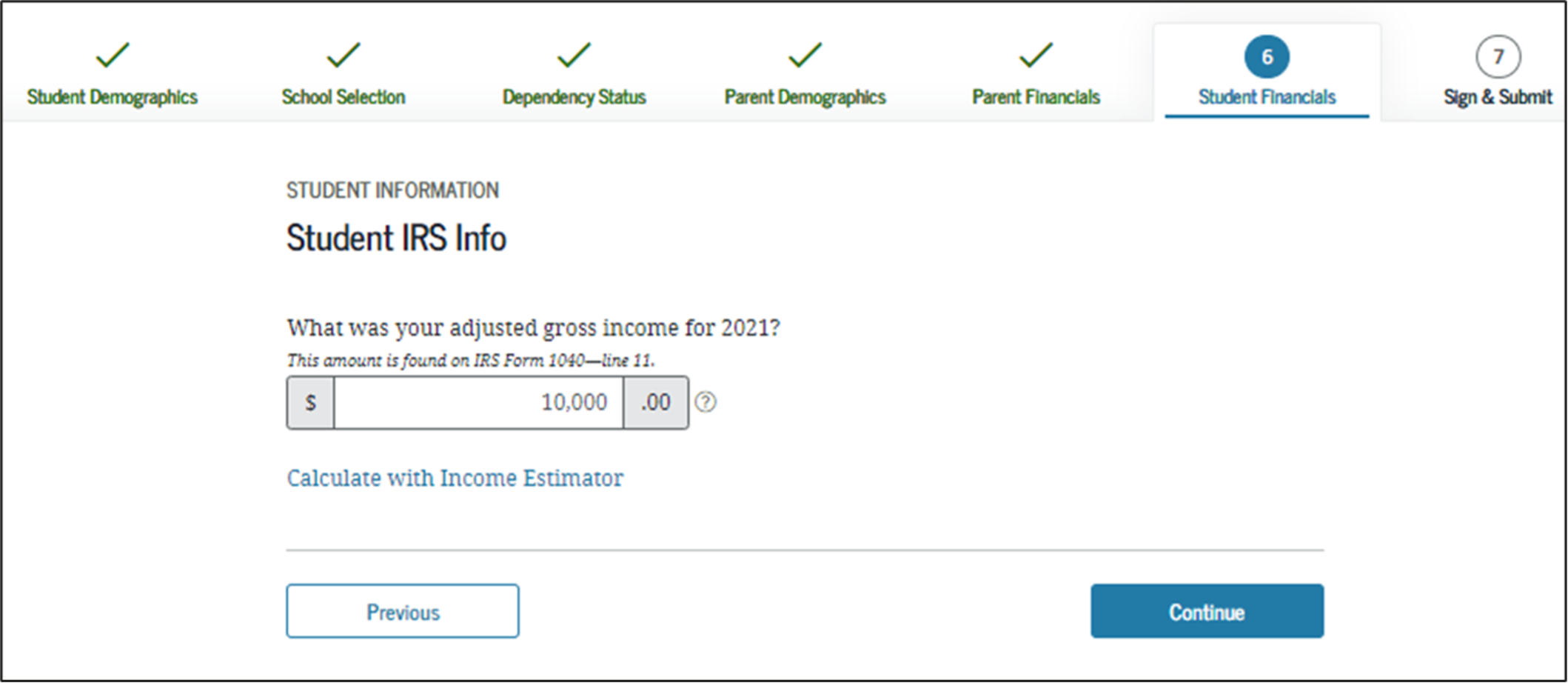
- 2023-24 “Student IRS Info” view.
- Note: If the applicant is either ineligible or decides not to use the IRS DRT, they will be required to enter their financial information manually.
- Answer the questions whether or not a tax return was filed. This information may be on the W-2 forms or on the tax return selected in question 33: IRS Form 1040-line 11
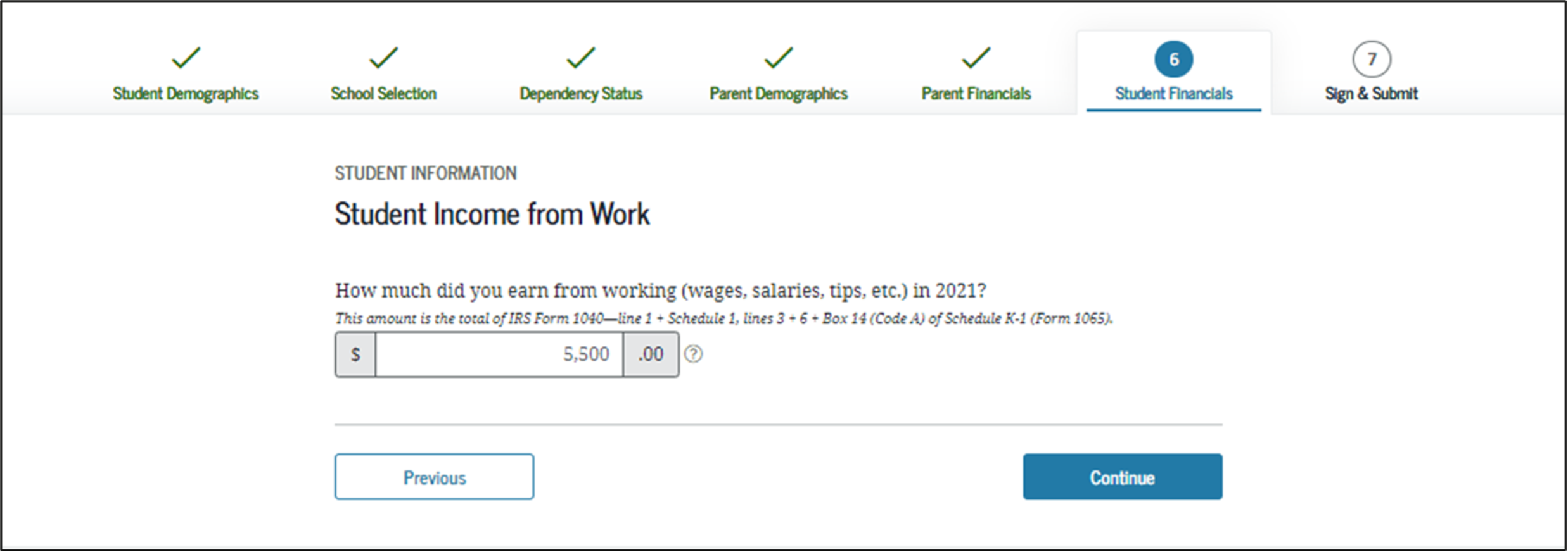
- 2023-24 “Student Income from Work” view.
- Answer the questions whether or not a tax return was filed. This information may be on the W-2 forms or on the tax return selected in question 33: This amount is the total of IRS Form 1040-line 1 + Schedule 1, lines 3 + 6 + Box 14 (code A) of Schedule K-1 (Form 1065)
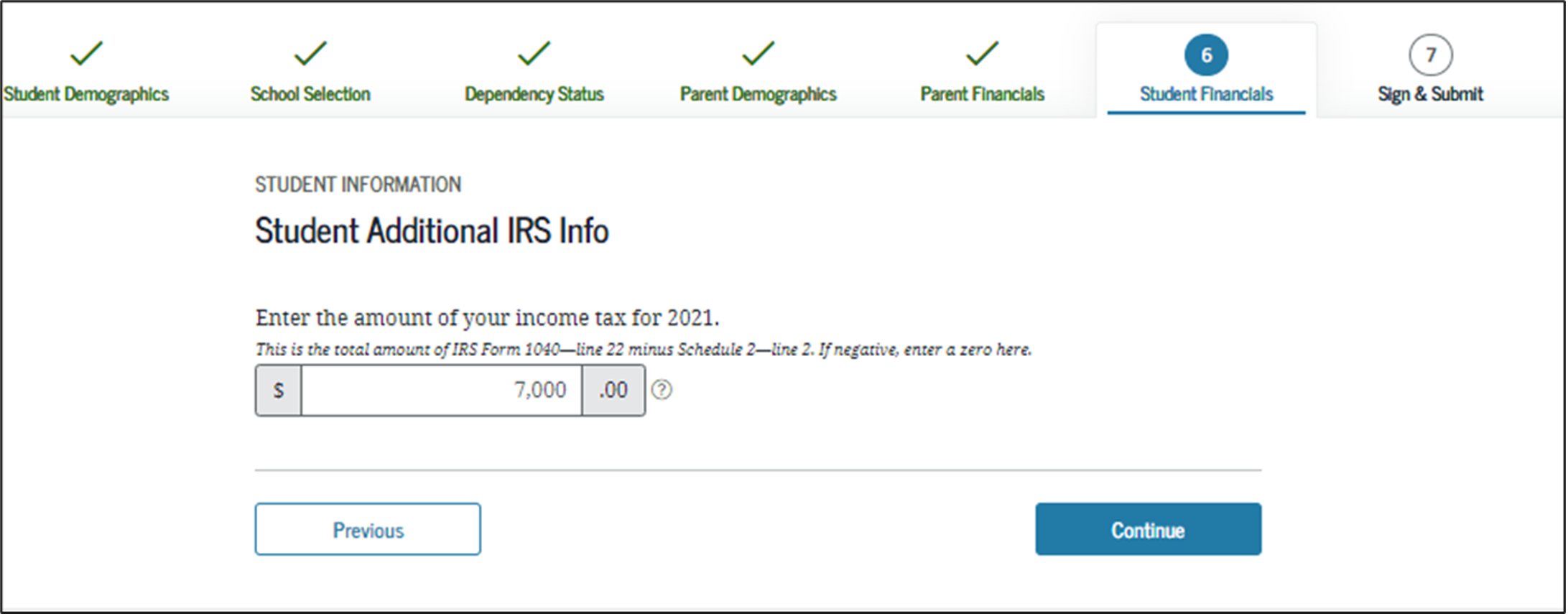
- 2023-24 “Student Additional IRS Info” view.
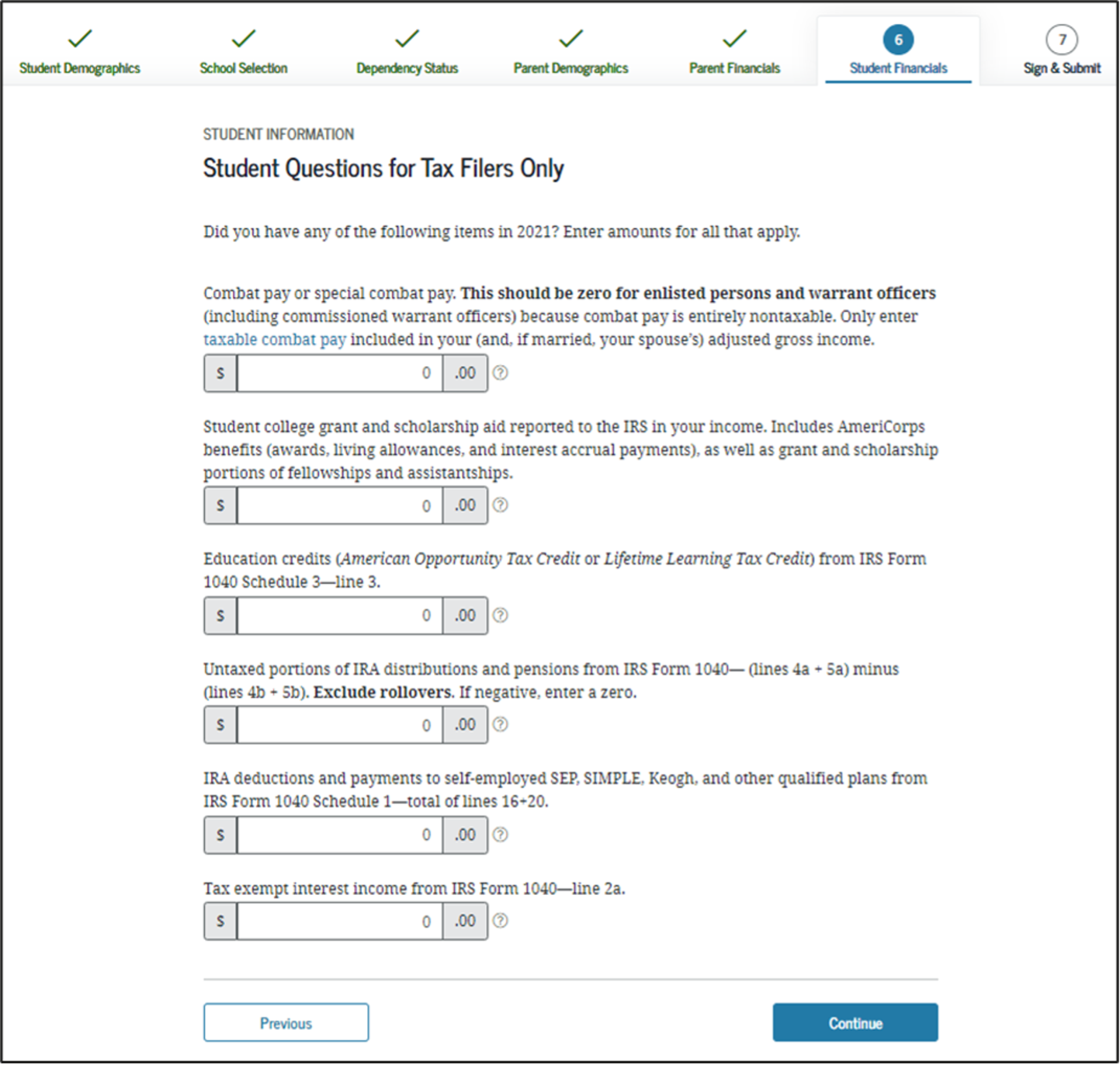
- Fill in your additional financial information based on these categories. If they do not apply, leave a “0.”
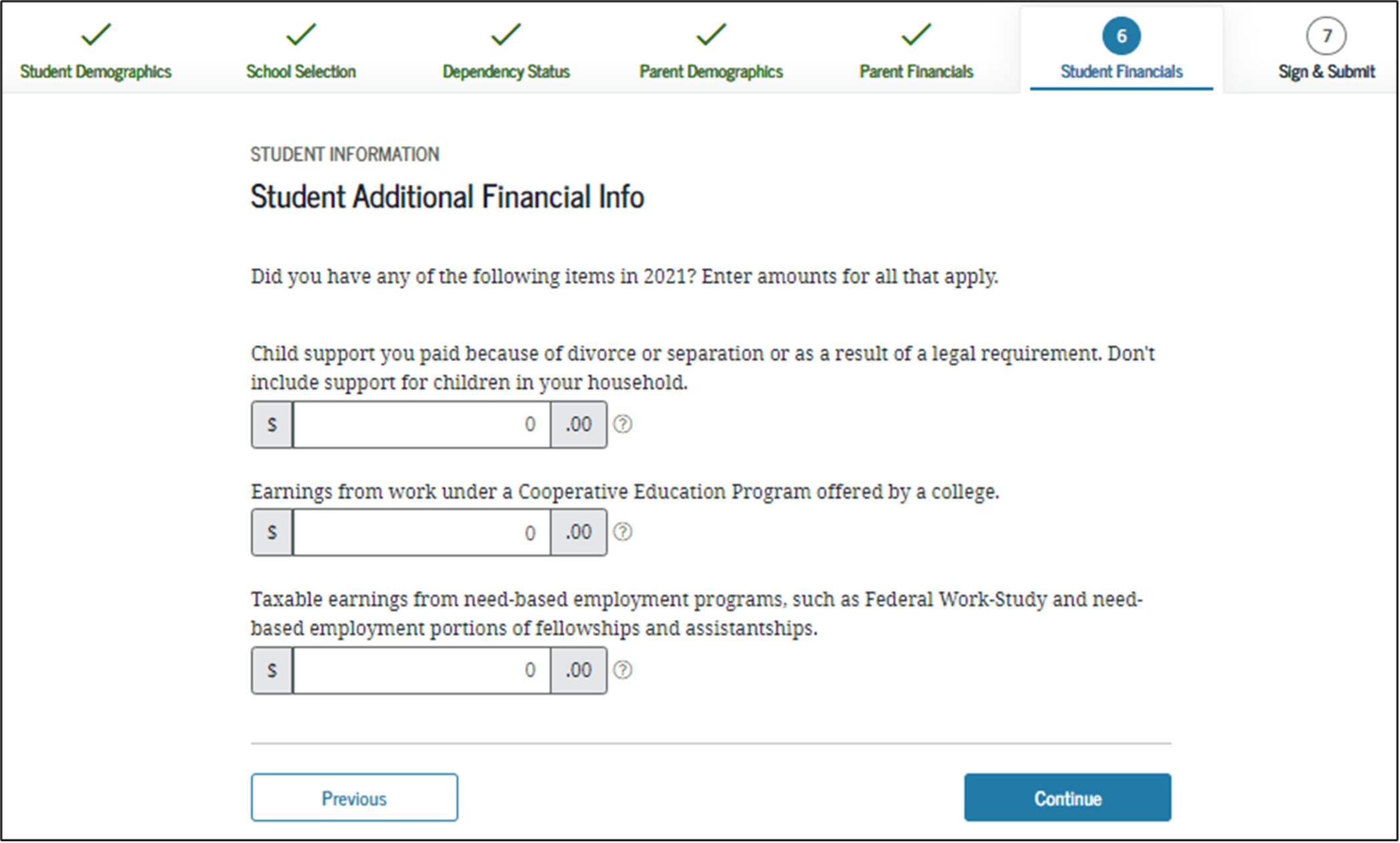
- If a student had income in any of the following categories during the past year, they must fill out the appropriate boxes that apply to them. In all of the above scenarios, if students are married and have a spouse, they should also report their spouse’s information on the FAFSA alongside their own.
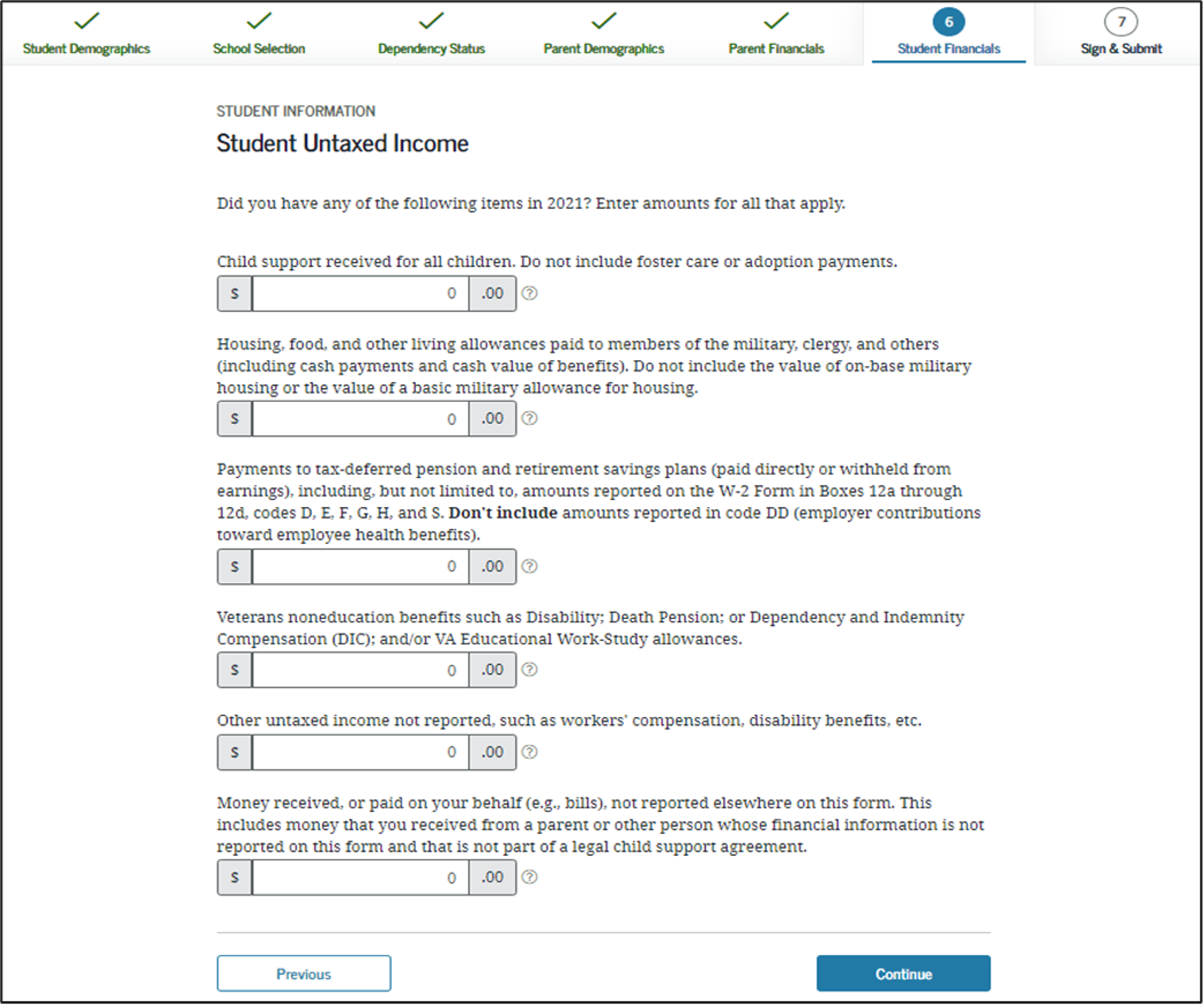
- If a student had income in any of the following categories during the past year, they must fill out the appropriate boxes that apply to them. In all of the above scenarios, if students are married and have a spouse, they should also report their spouse’s information on the FAFSA alongside their own.
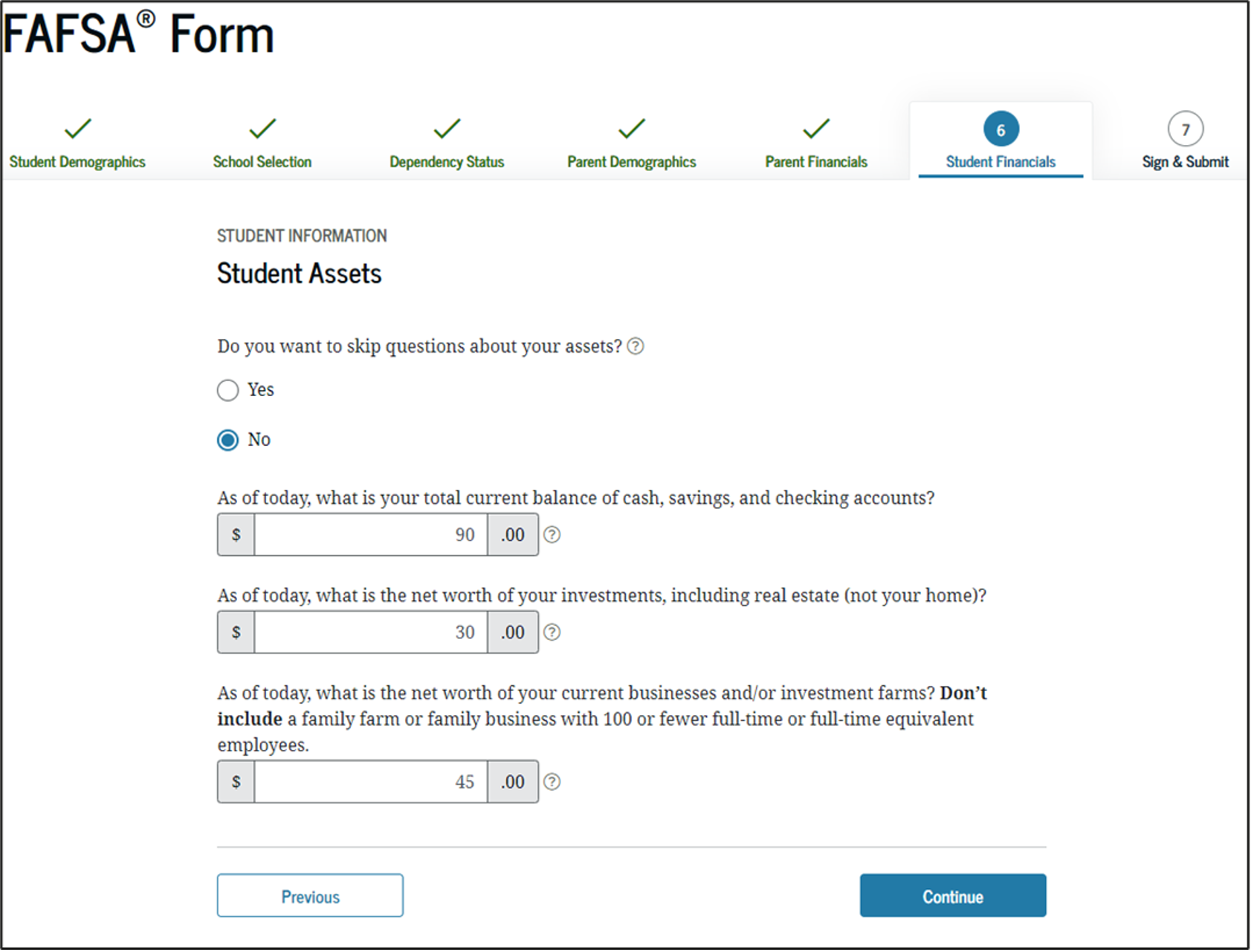
- Note.This is a smart question and may look different for users based on inputs.
- Include the current total of your cash-in-hand, and totals of your checking and savings accounts.
- Include the net worth of your investments, including real estate. Do NOT include the house you live in.
- Include the total value of your (and your spouse’s) total investments. To do this, you will add the current value of all investments, subtracting any debts currently owed on them.
Step Eight: Sign and Submit
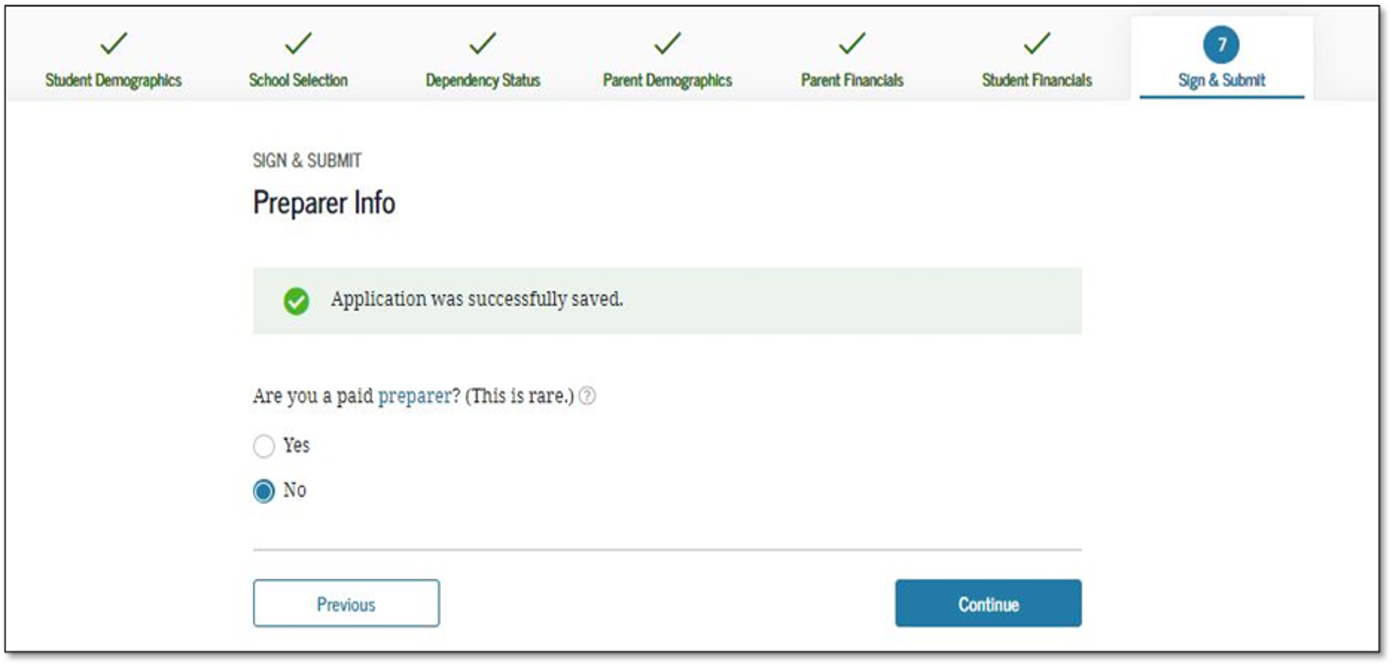
- If you are a student filling out your own FAFSA choose “No.”
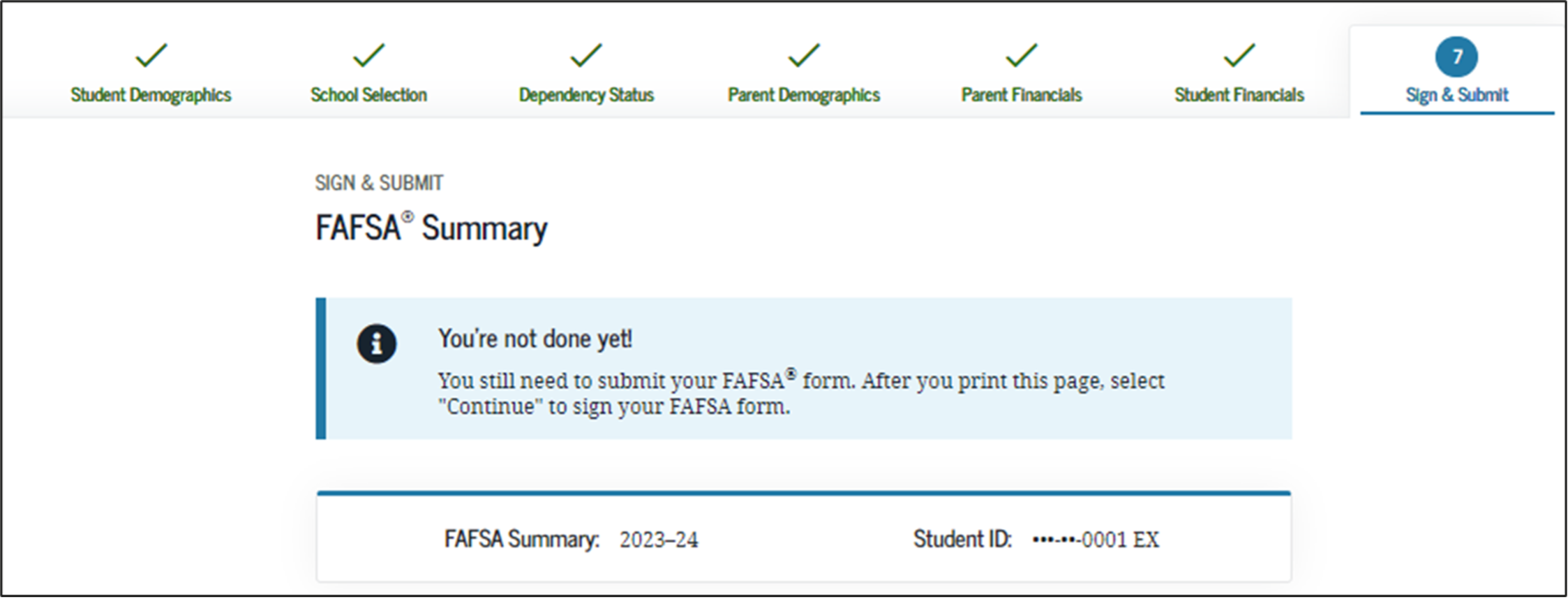
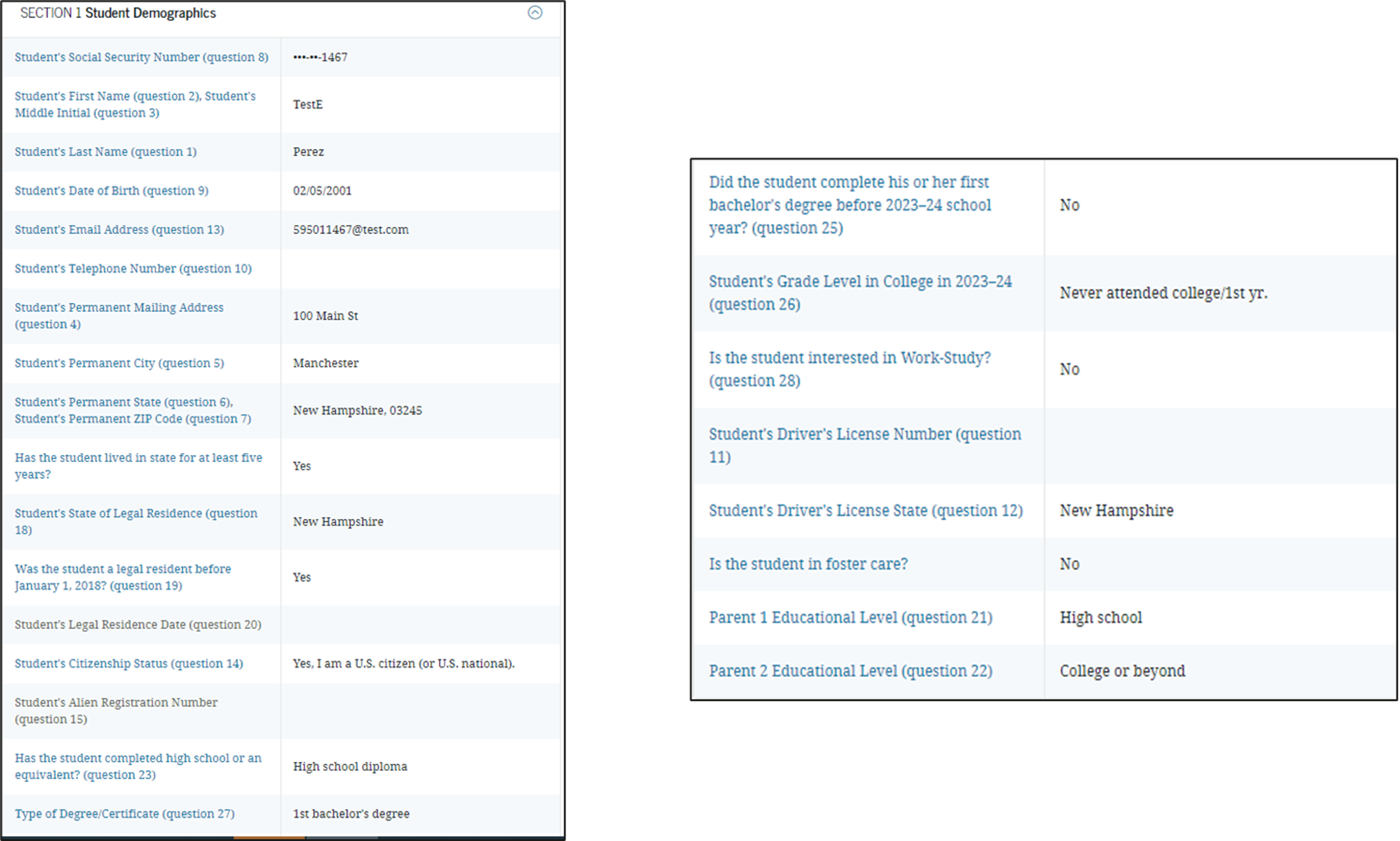
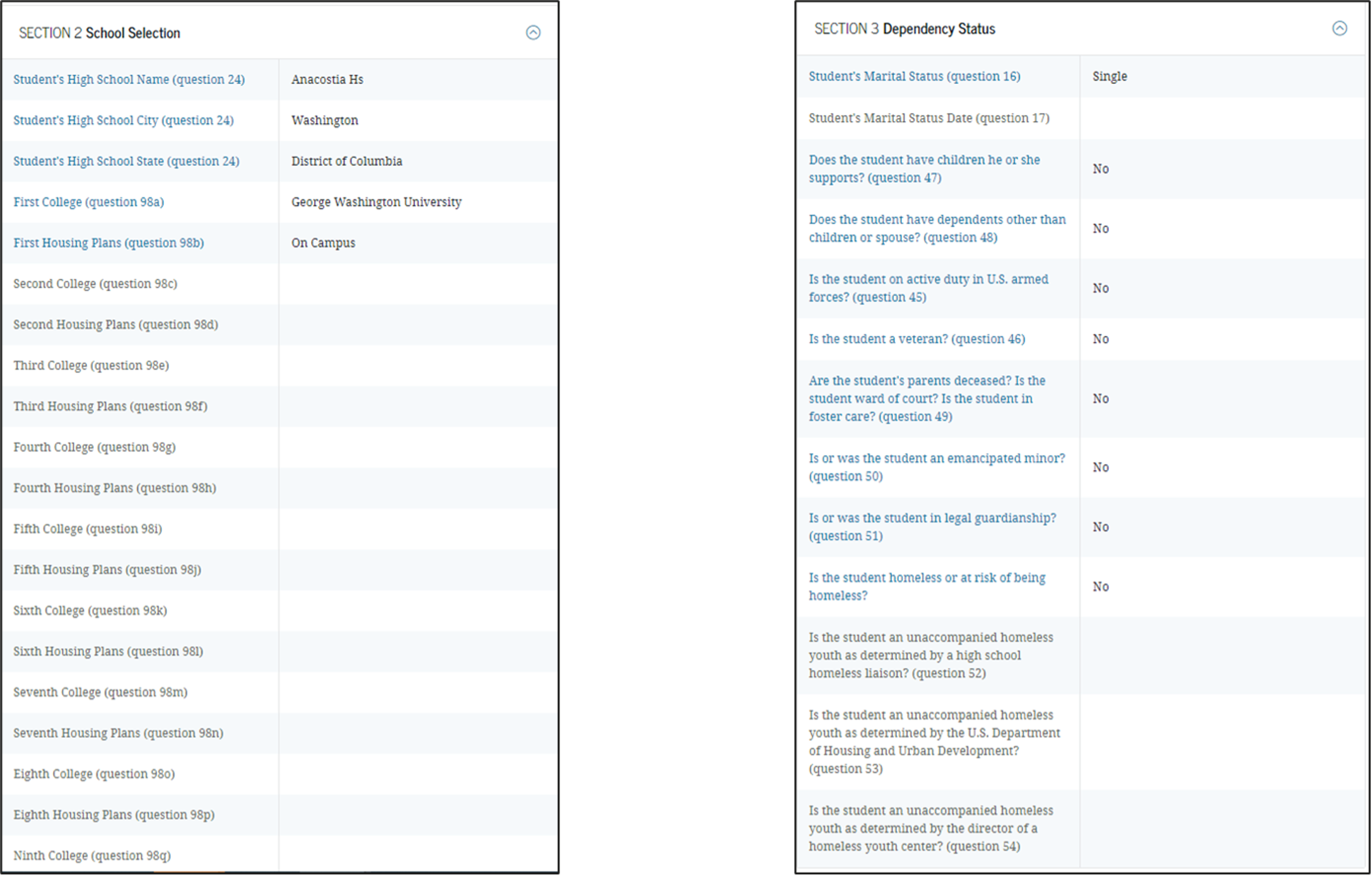
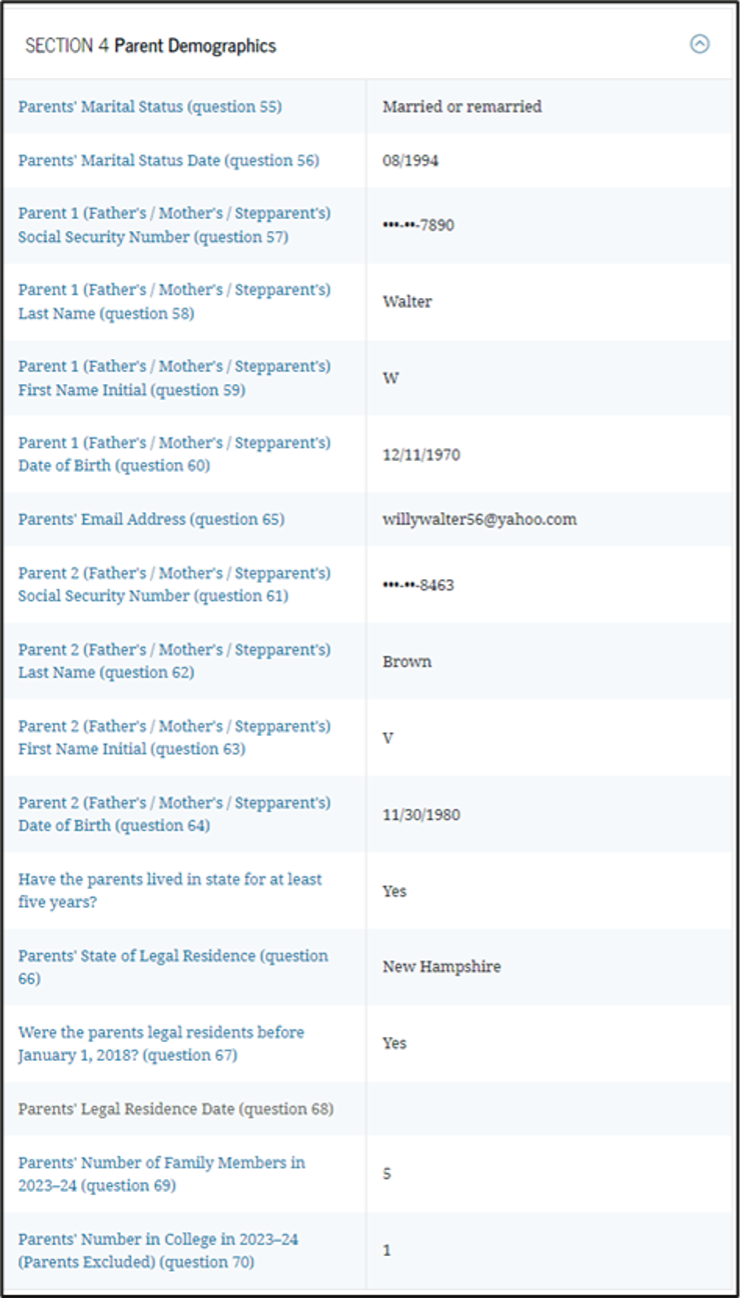
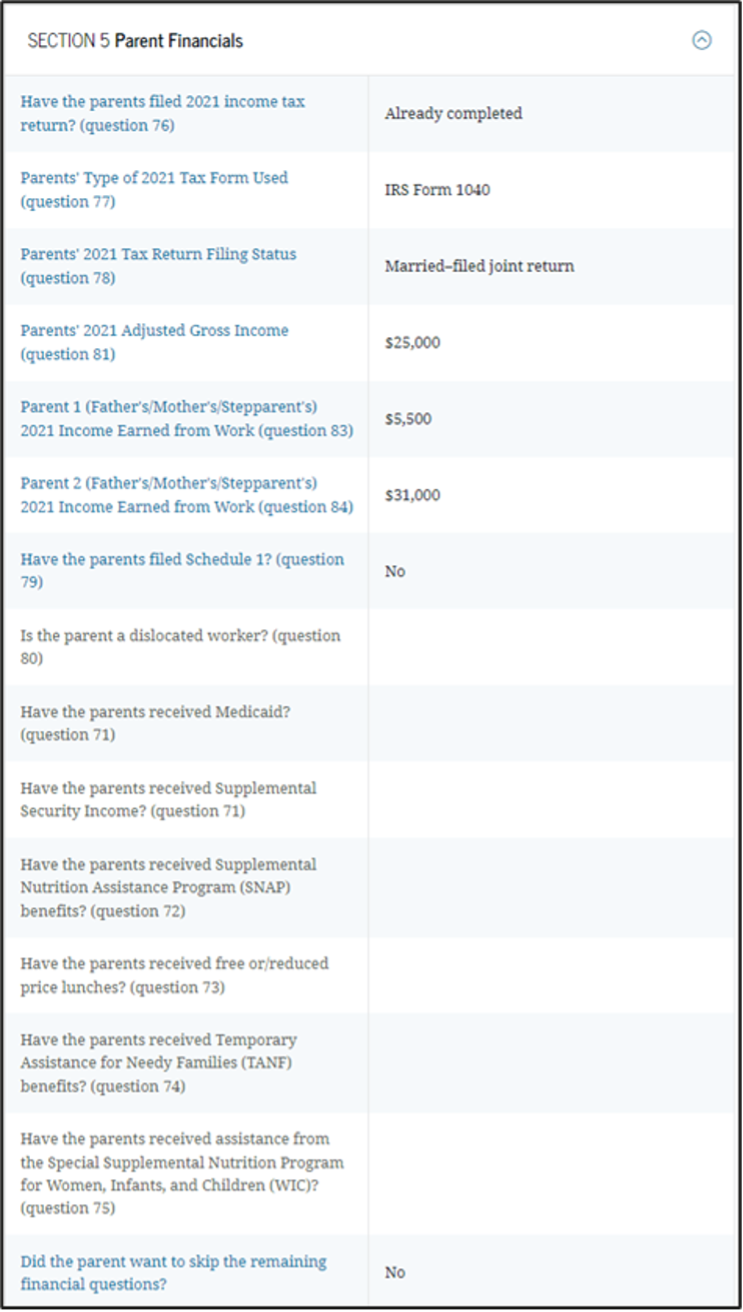
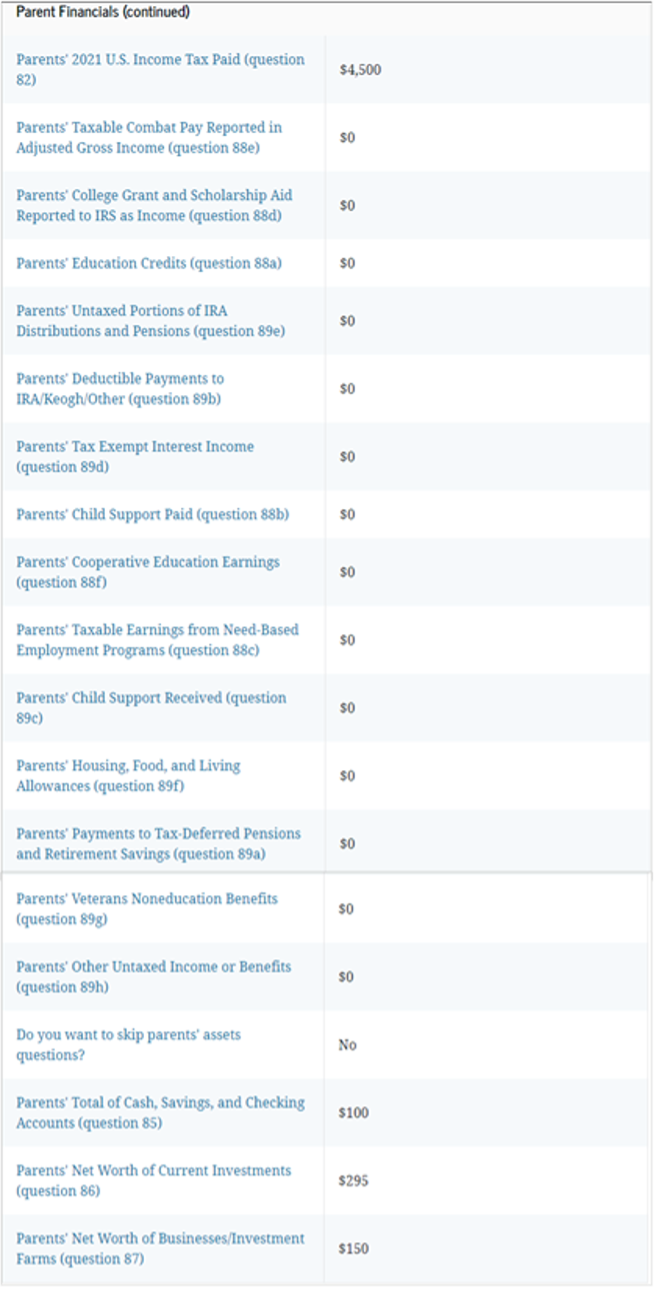
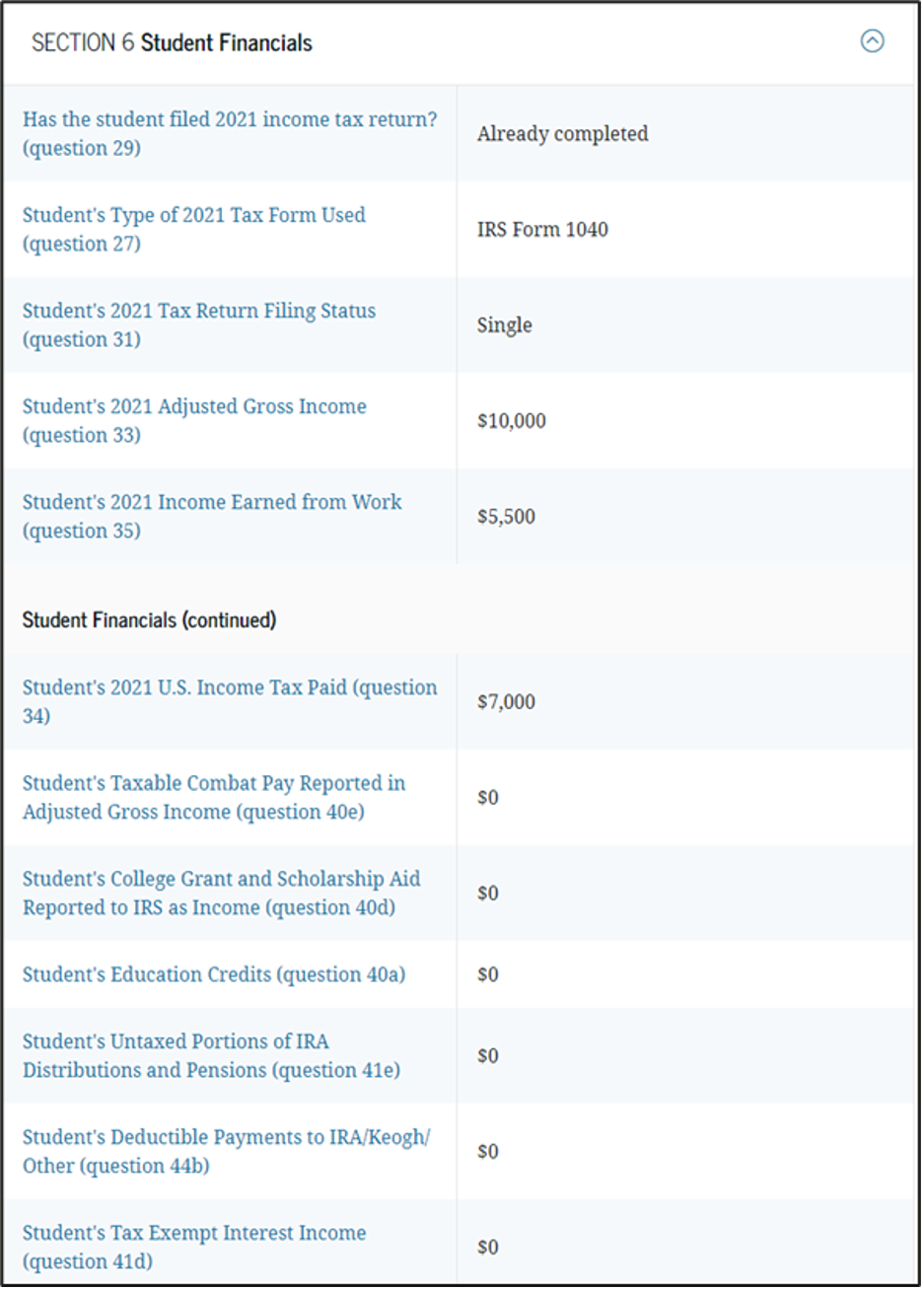
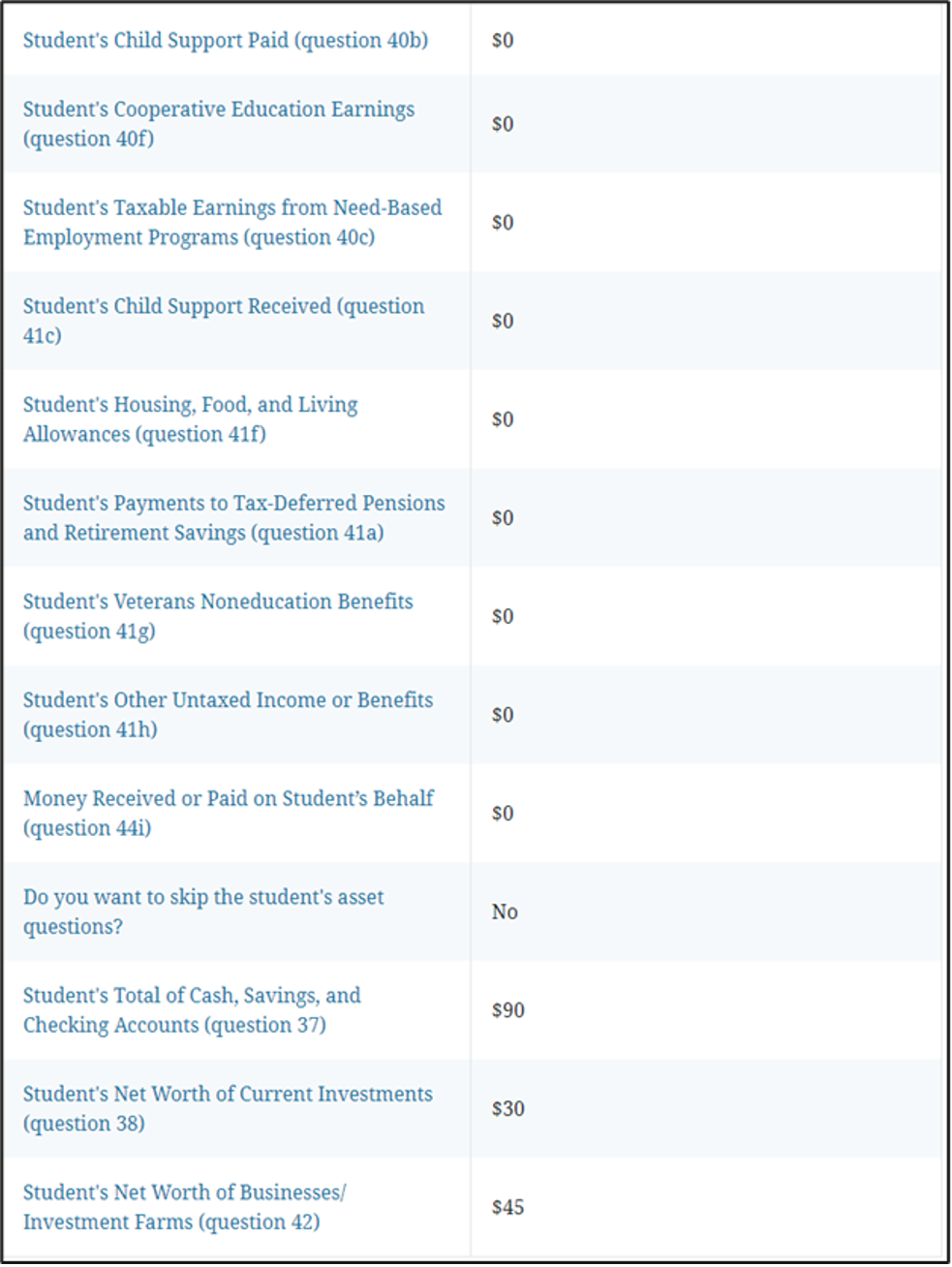
Demographic Survey
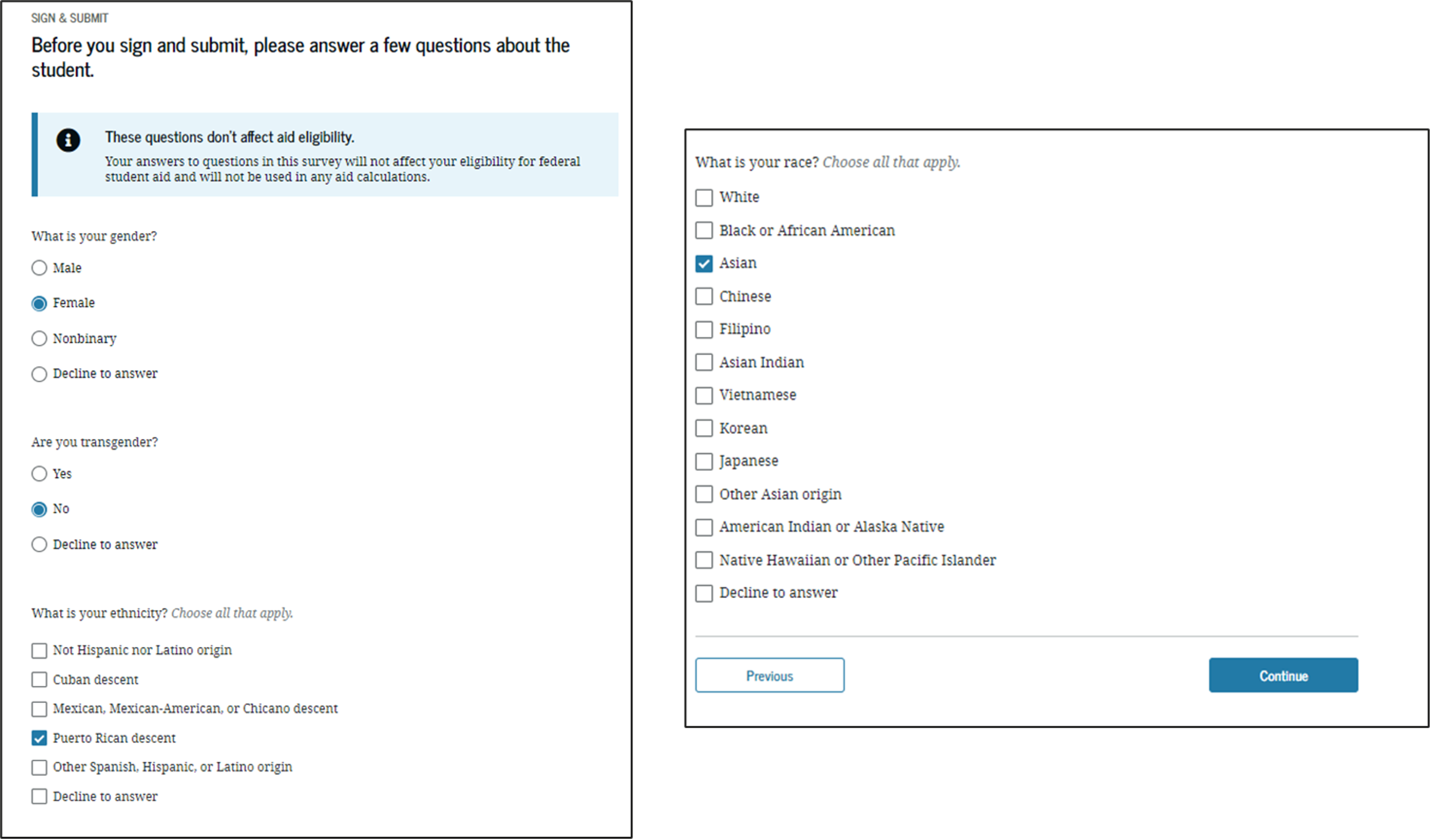
- The demographic survey is new for the 2023 –24 FAFSA® cycle and is only presented once per transaction. Before the user can sign and submit their FAFSA® form, they must respond to the survey.
- 2023-24 “FAFSA Summary” view
- Note: You have not yet completed the FAFSA if you are on this page.
- This is an example of the first screen of the summary of your FAFSA. Here you can confirm the information you provided is correct. If you need to go back and make any edits, you can click the hyperlinked text of the question on the left of the table
Agreement of Terms
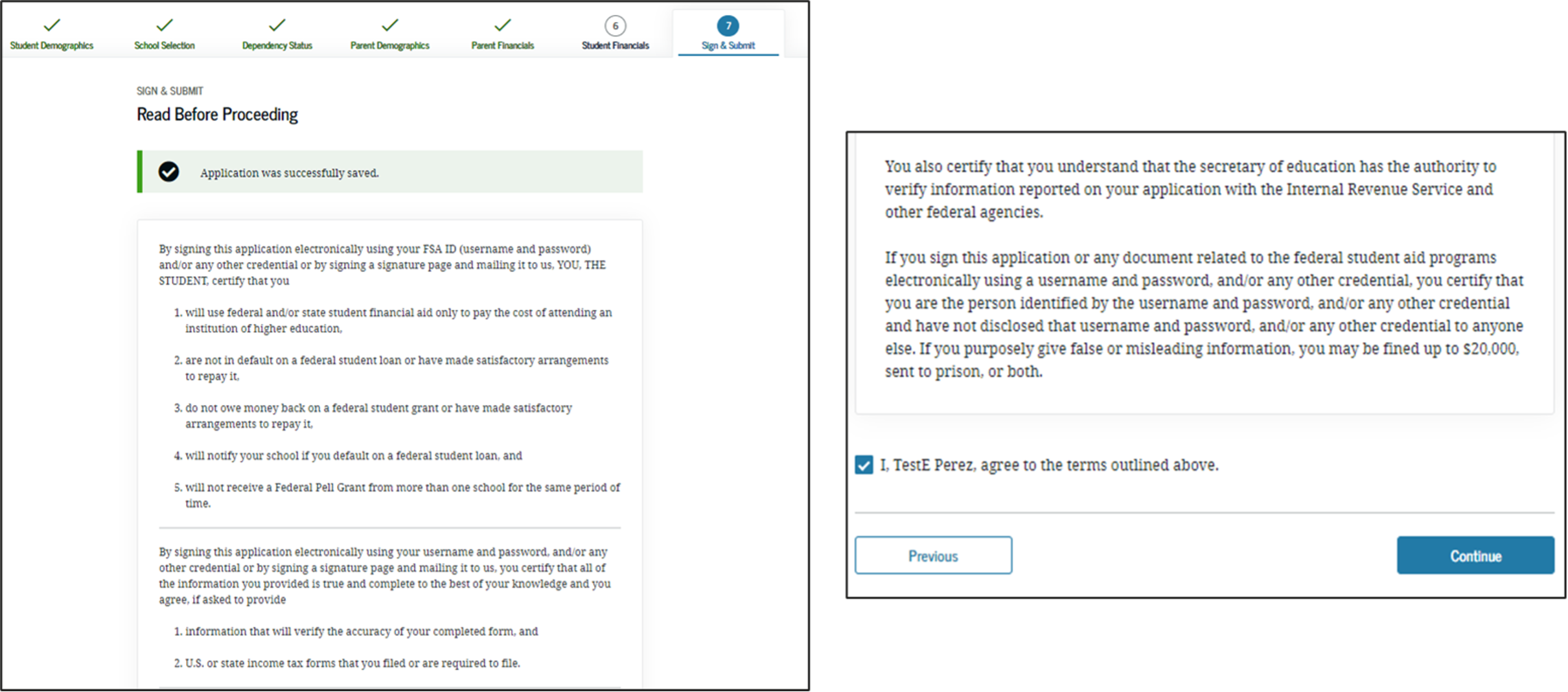
Student Signature Options
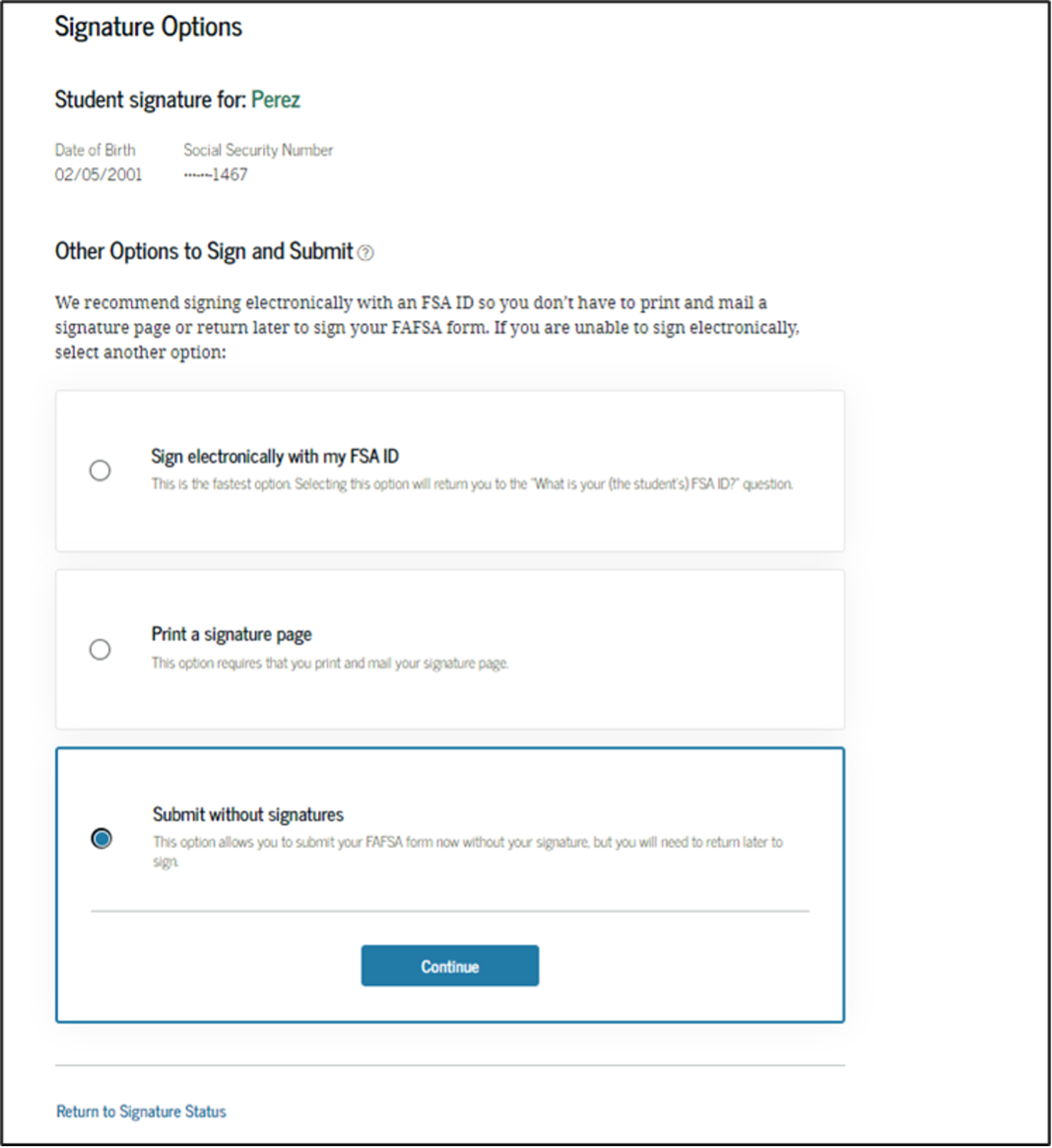
- The user indicates how they plan to sign the application and provide their signature from this view.
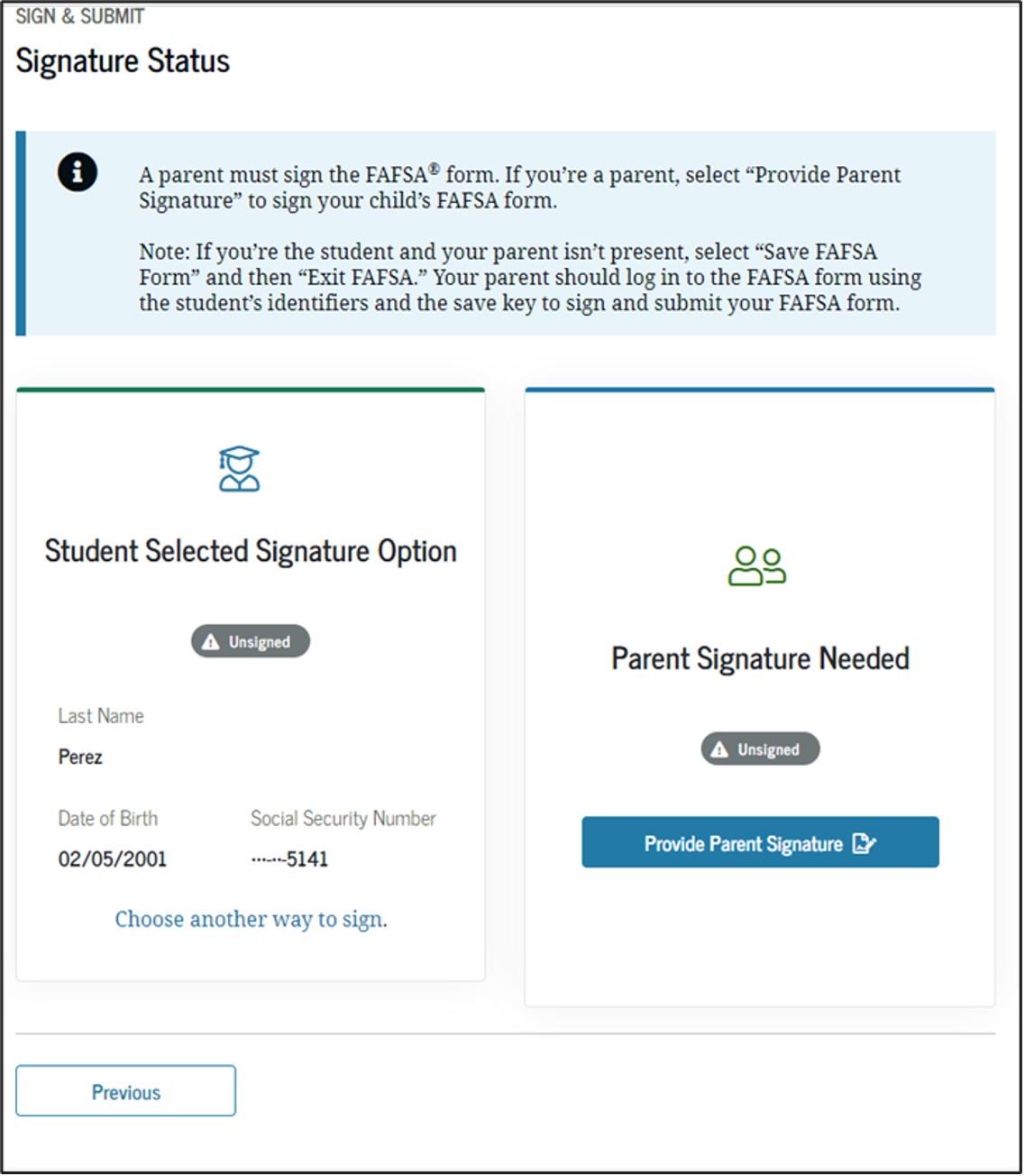
- 2023-2024 “Which Parent Signs” view. Allows the user to select which parent will be signing the application. The choice between parents is only present if information was provided for two parents. Otherwise, this view does not display.
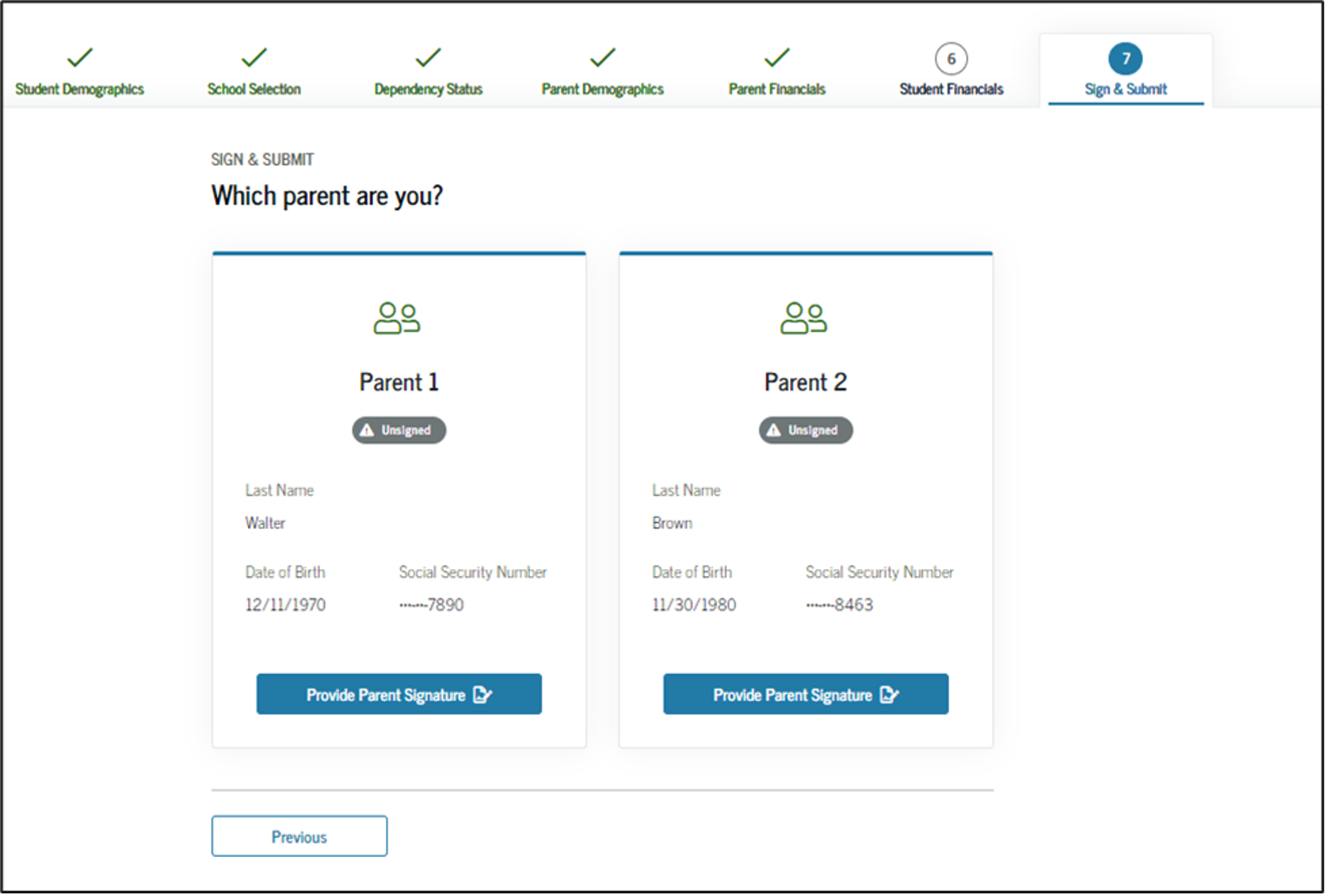
- 2023-24 “Signature Status” view.
- Electronically sign the FAFSA here.
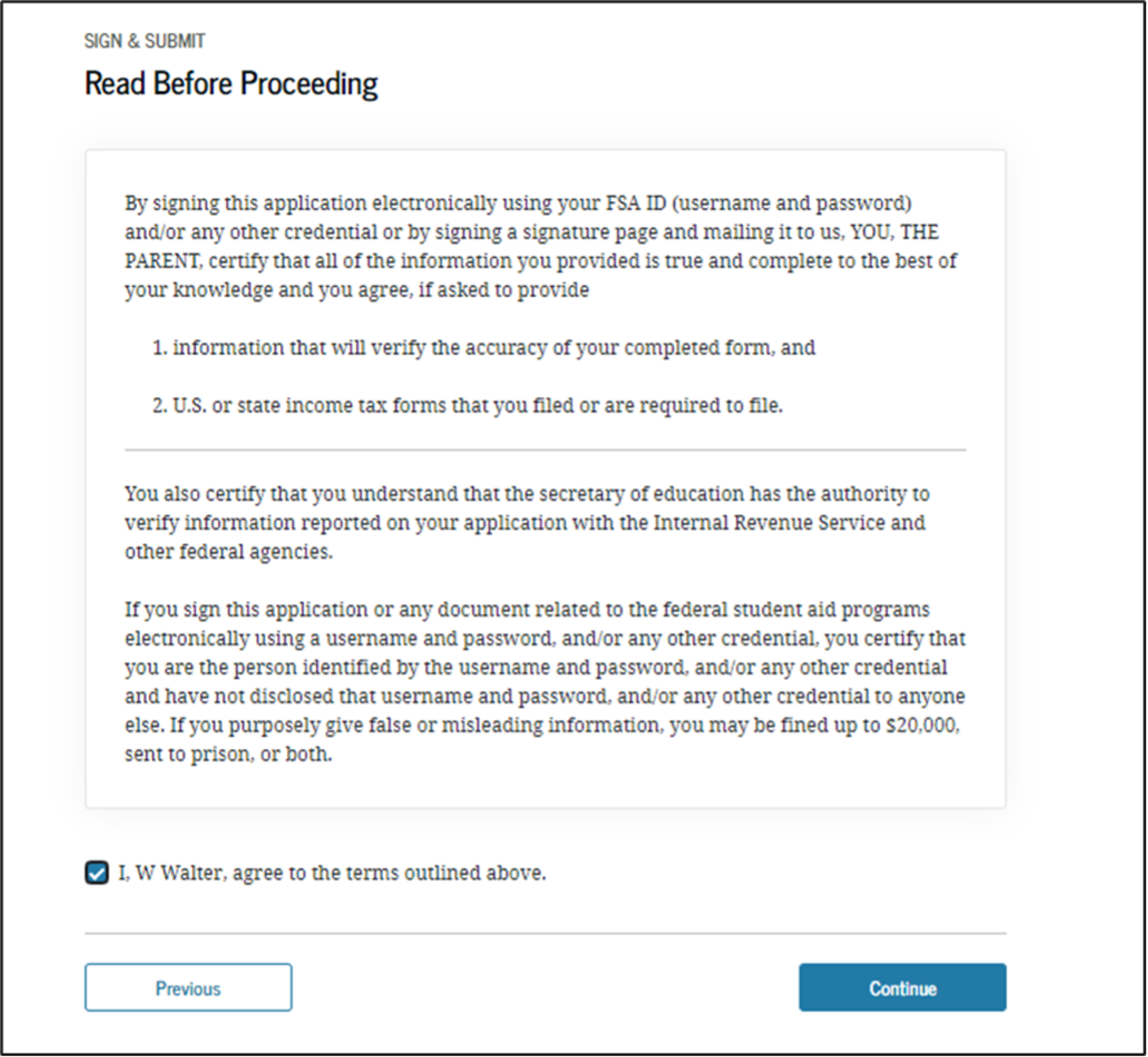
- 2023-24 “Agreement of Terms” student view.
- This is where the applicant acknowledges the Certification Statement.
- Select "Agree" if you agree with the terms.
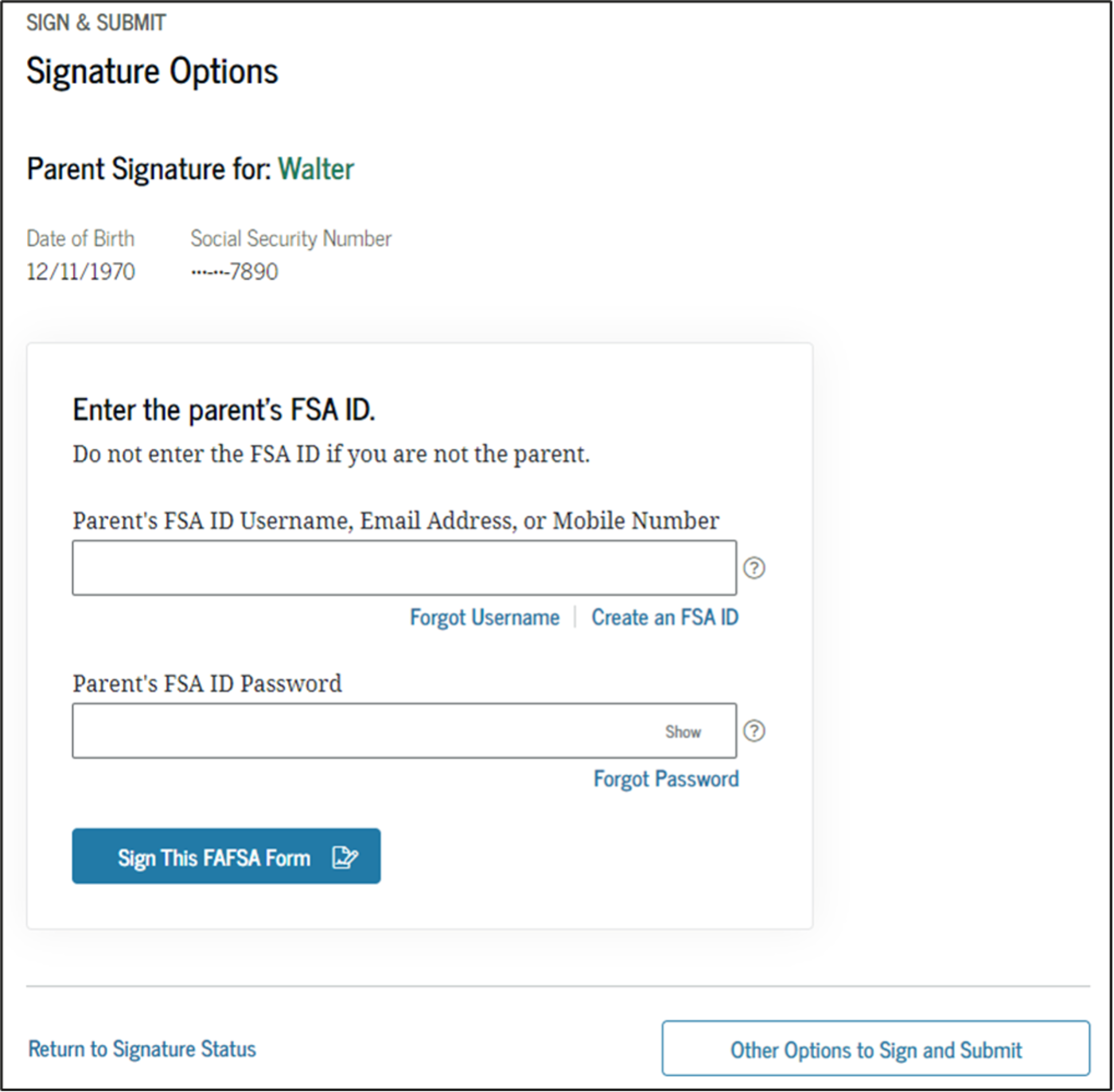
- 2023-24 “Signature Options” view for applicant.
- Electronically sign the FAFSA here.
Parent Signature Options (continued)
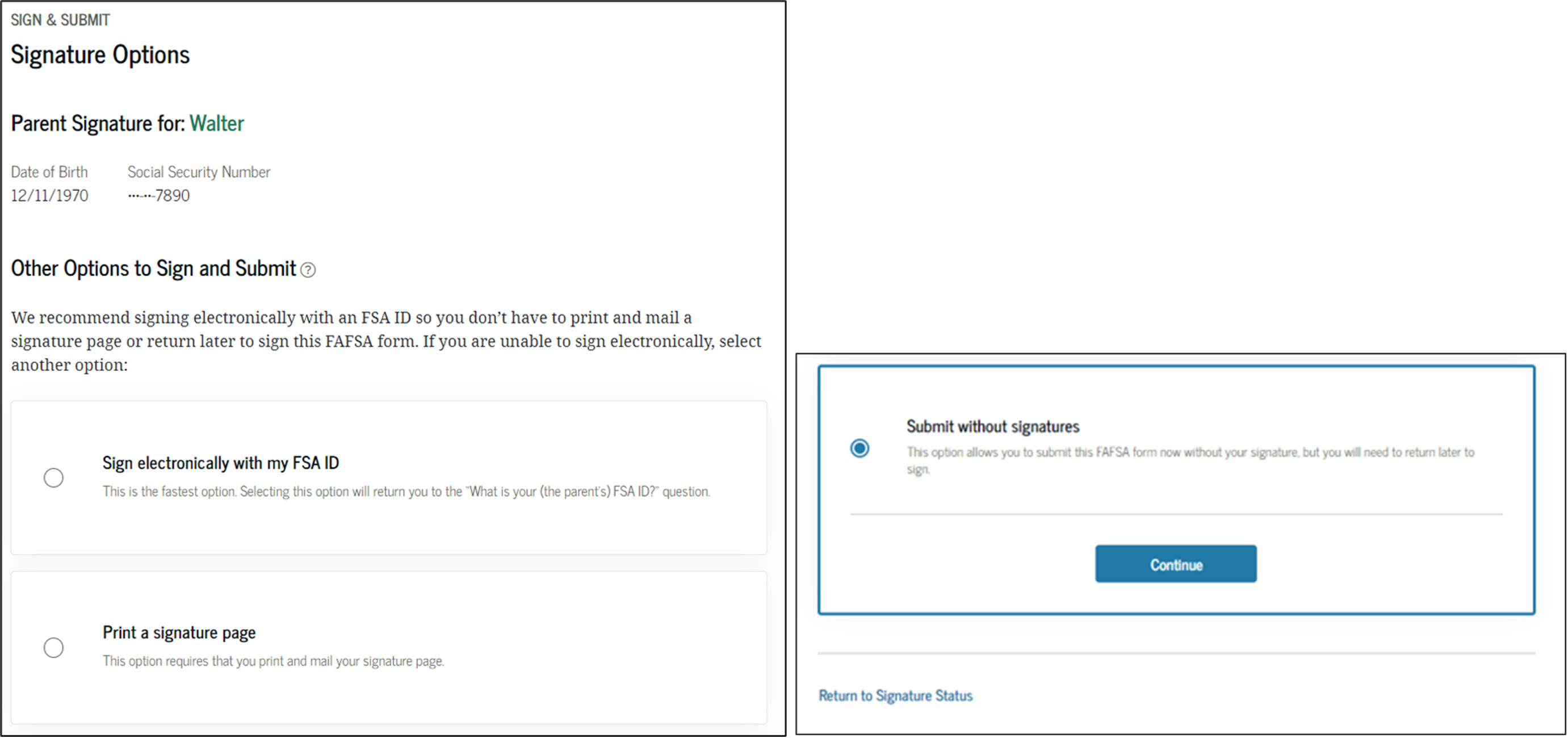
- In this view, the user selects their desired signature option. In this scenario, the parent selects “Submit without signatures” then clicks “Continue.”
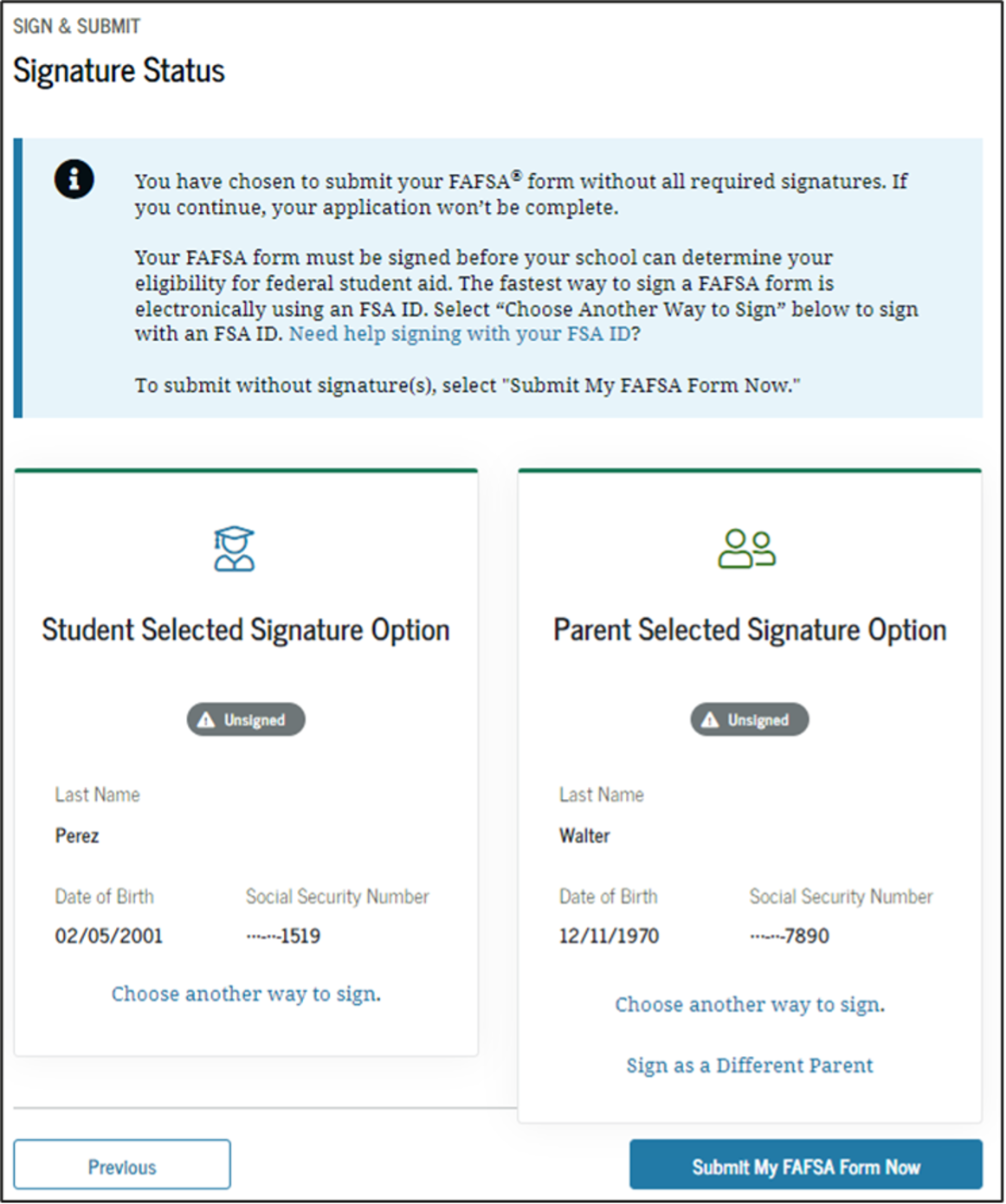
- After the parent has selected a signature option, they are returned to the Sign and Submit page. The “Submit My FAFSA Form Now” button is now enabled. The user clicks this button to submit their FAFSA form.
Confirmation Page
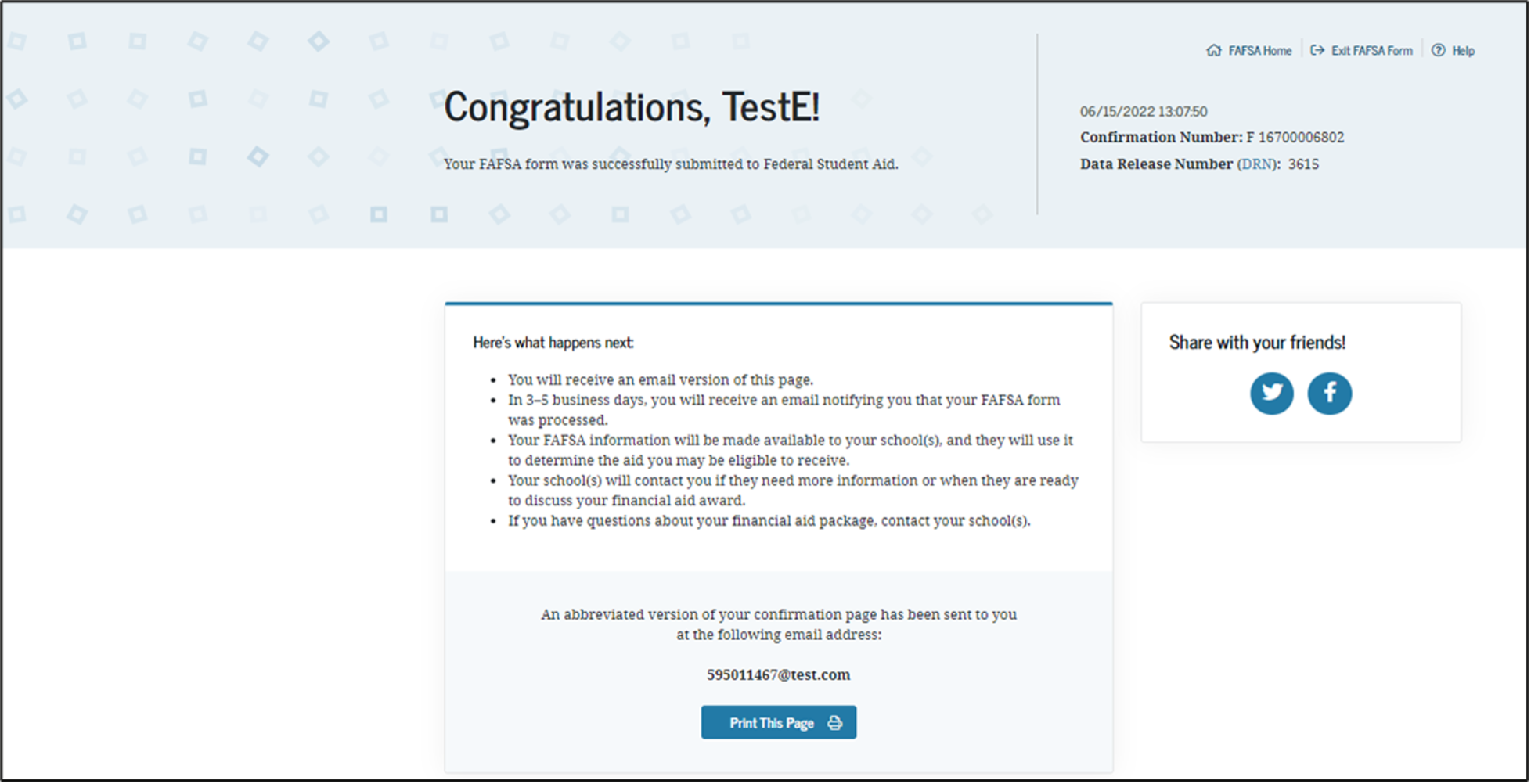
- 2023-24 “Confirmation Page” view.
- Congratulations! Your FAFSA has been officially submitted.
- Some states provide the option to transfer part of the applicant’s FAFSA information into a state aid application.
- Parents of applicants are offered the option to transfer the parents’ data into another applicant's new FAFSA form by clicking the blue box saying “Does your brother or sister need to complete a FAFSA?”
- If the applicant leaves the confirmation view before they click this link, they will not be able to return to transfer data to the application of a sibling.
Want The Answers To Every FAFSA Question?
Here's A Step-By-Step Guide From Our Financial Aid Expert!
This guide will walk you through the why and how of the questions on FAFSA. If you are having trouble, email us at help@nitrocollege.com and we will try to address as many questions as possible or answer it in a future blog post. If you do have questions, you should consult a financial or legal professional. Or if you have specific FAFSA questions, FAFSA provides a support line (800-433-3243). The TDD number for hearing-impaired individuals is 1-800-730-8913.
Once you submit your FAFSA, plan ahead by applying to scholarships that fit your qualifications. To find the perfect fit, use our free college scholarship guides to sort through scholarships based on your eligibility, award amount and if you qualify for need-based aid.
